Key Figures
- 106 articles in high-impact journals
- 7 cover pages
- 1 cover profile
- 1 editor’s pick
- 15+ hot/special/very important papers/topics
- 10+ society/special/themed/topical collections/issues/volumes
- 2,500+ citations
- 35+ press releases & highlights
- 12+ average impact factor
- 90+% collaborative publications
Conformational Tuning of Magnetic Interactions in Coupled Nanographenes
G. Catarina, E. Turco, N. Krane, M. Bommert, A. Ortega-Guerrero, O. Gröning, P. Ruffieux, R. Fasel, C. A. Pignedoli
Nano Lett., 2024, 24, 12536–12544. Link to article.
 Phenalenyl (C13H9) is an open-shell spin-1/2 nanographene. Using scanning tunneling microscopy (STM) inelastic electron tunneling spectroscopy (IETS), covalently bonded phenalenyl dimers have been shown to feature conductance steps associated with singlet–triplet excitations of a spin-1/2 dimer with antiferromagnetic exchange. Here, we address the possibility of tuning the magnitude of the exchange interactions by varying the dihedral angle between the two molecules within a dimer. Theoretical methods ranging from density functional theory calculations to many-body model Hamiltonians solved within different levels of approximation are used to explain STM-IETS measurements of phenalenyl dimers on a hexagonal boron nitride (h-BN)/Rh(111) surface, which exhibit signatures of twisting. By means of first-principles calculations, we also propose strategies to induce sizable twist angles in surface-adsorbed phenalenyl dimers via functional groups, including a photoswitchable scheme. This work paves the way toward tuning magnetic couplings in carbon-based spin chains and two-dimensional lattices.
Phenalenyl (C13H9) is an open-shell spin-1/2 nanographene. Using scanning tunneling microscopy (STM) inelastic electron tunneling spectroscopy (IETS), covalently bonded phenalenyl dimers have been shown to feature conductance steps associated with singlet–triplet excitations of a spin-1/2 dimer with antiferromagnetic exchange. Here, we address the possibility of tuning the magnitude of the exchange interactions by varying the dihedral angle between the two molecules within a dimer. Theoretical methods ranging from density functional theory calculations to many-body model Hamiltonians solved within different levels of approximation are used to explain STM-IETS measurements of phenalenyl dimers on a hexagonal boron nitride (h-BN)/Rh(111) surface, which exhibit signatures of twisting. By means of first-principles calculations, we also propose strategies to induce sizable twist angles in surface-adsorbed phenalenyl dimers via functional groups, including a photoswitchable scheme. This work paves the way toward tuning magnetic couplings in carbon-based spin chains and two-dimensional lattices.
Covalent organic framework-based Li–S batteries: functional separators promoting Li+ transport and polysulfide trapping
S. Gullace, M. Abruzzese, L. Cusin, G. Saleh, S. B. Thorat, A. Gamberini, S. Bellani, A. Ciesielski, F. Bonaccorso, P. Samorì
J. Mater. Chem. A, 2024, 12, 25359–25370. Link to article (open access).
 Lithium–sulphur batteries (LSBs) prevail as a viable alternative to Li-ion batteries due to their high theoretical specific capacity (1672 mA h gS−1). However, the formation of soluble polysulfides and their shuttle from the cathode to the anode cause irreversible capacity loss and uncontrolled self-discharge, limiting the performance of commercially available prototypes. In this work, we present a comparative analysis of two Kagome-shaped imine-based covalent organic frameworks (COFs) as functional modifiers for polypropylene (Celgard) separators in LSBs. We demonstrate, by using the KS60@Celgard separator modified with an optimized content of COF with the thienothiophene linker, the realization of LSBs reaching a specific discharge capacity of 850 mA h gS−1 at C5. The proposed separator has an extraordinarily high Li+ diffusion coefficient (DLi+) of 1.6 × 10−7 cm2 s−1 at the first cathodic peak, as well as the lowest S8 : Li2Sx content ratio in the ex situ post mortem XPS analysis. These findings demonstrate that the use of separators modified with COFs allows the mitigation of shuttle effect, and is further accompanied by an efficient oxidation of Li2Sx to S8 (electrocatalytic effect). The equivalent K60@Celgard, based on a COF carrying a phenyl linker, results in LSBs with a specific discharge capacity of 599 mA h gS−1. This work highlights the synergistic effect of polysulfide retention, selective Li+ sieving and electrocatalytic activity of COF-modified Celgard separators in the development of high-performance LSBs.
Lithium–sulphur batteries (LSBs) prevail as a viable alternative to Li-ion batteries due to their high theoretical specific capacity (1672 mA h gS−1). However, the formation of soluble polysulfides and their shuttle from the cathode to the anode cause irreversible capacity loss and uncontrolled self-discharge, limiting the performance of commercially available prototypes. In this work, we present a comparative analysis of two Kagome-shaped imine-based covalent organic frameworks (COFs) as functional modifiers for polypropylene (Celgard) separators in LSBs. We demonstrate, by using the KS60@Celgard separator modified with an optimized content of COF with the thienothiophene linker, the realization of LSBs reaching a specific discharge capacity of 850 mA h gS−1 at C5. The proposed separator has an extraordinarily high Li+ diffusion coefficient (DLi+) of 1.6 × 10−7 cm2 s−1 at the first cathodic peak, as well as the lowest S8 : Li2Sx content ratio in the ex situ post mortem XPS analysis. These findings demonstrate that the use of separators modified with COFs allows the mitigation of shuttle effect, and is further accompanied by an efficient oxidation of Li2Sx to S8 (electrocatalytic effect). The equivalent K60@Celgard, based on a COF carrying a phenyl linker, results in LSBs with a specific discharge capacity of 599 mA h gS−1. This work highlights the synergistic effect of polysulfide retention, selective Li+ sieving and electrocatalytic activity of COF-modified Celgard separators in the development of high-performance LSBs.
Covalent functionalization by using blue light activated radicals: on the reaction mechanisms of arylazo sulfone binding on graphene
A. Mameli, A. Kovtun, D. Jones, V. Benekou, V. Palermo, M. Bandini, M. Melucci
Nanoscale Adv., 2024, 6, 5080–5091. Link to article (open access).
 Covalent functionalization of graphene presents a pivotal strategy to enhance its surface properties and overcome inherent chemical inertness. While diazonium salts have been extensively utilized for this purpose, their limitations necessitate exploration of alternative approaches. Arylazo sulfones, such as diazonium salt derivatives serving as chromophores, offer a promising solution, enabling photochemical reactions under visible light. Here, we propose a novel method for rapid covalent photofunctionalization of chemical vapor deposition (CVD) graphene on copper substrates using arylazo sulfones. The generation of aryl radicals – chlorobenzene in this case – was achieved through blue light LED irradiation of 4-chlorophenylazo methyl sulfone solution in acetonitrile. Efficient surface covalent modification of graphene was verified by observing (i) the photogeneration of radicals with a decrease in the π–π* band absorbance and an increase in the n–π* of arylazosulfone solution by UV-Vis spectroscopy; (ii) an increase in C sp3 defects on graphene from the Raman D band, the Auger C KLL signal and graphene C 1s X-ray photoelectron spectroscopy (XPS); and (iii) the presence of the chlorobenzene XPS Cl 2p signal. The aryl radical generation was enhanced by the copper substrate during irradiation, with a possible double path reaction mechanism. This approach highlights the versatility of arylazo sulfones in covalently patterning graphene surfaces, thus unlocking opportunities by overcoming the current approach consisting of the deposition of resist materials with successive cycles of lithography and electrochemistry.
Covalent functionalization of graphene presents a pivotal strategy to enhance its surface properties and overcome inherent chemical inertness. While diazonium salts have been extensively utilized for this purpose, their limitations necessitate exploration of alternative approaches. Arylazo sulfones, such as diazonium salt derivatives serving as chromophores, offer a promising solution, enabling photochemical reactions under visible light. Here, we propose a novel method for rapid covalent photofunctionalization of chemical vapor deposition (CVD) graphene on copper substrates using arylazo sulfones. The generation of aryl radicals – chlorobenzene in this case – was achieved through blue light LED irradiation of 4-chlorophenylazo methyl sulfone solution in acetonitrile. Efficient surface covalent modification of graphene was verified by observing (i) the photogeneration of radicals with a decrease in the π–π* band absorbance and an increase in the n–π* of arylazosulfone solution by UV-Vis spectroscopy; (ii) an increase in C sp3 defects on graphene from the Raman D band, the Auger C KLL signal and graphene C 1s X-ray photoelectron spectroscopy (XPS); and (iii) the presence of the chlorobenzene XPS Cl 2p signal. The aryl radical generation was enhanced by the copper substrate during irradiation, with a possible double path reaction mechanism. This approach highlights the versatility of arylazo sulfones in covalently patterning graphene surfaces, thus unlocking opportunities by overcoming the current approach consisting of the deposition of resist materials with successive cycles of lithography and electrochemistry.
Laser-Patterned Polyurethane Composites with Graphene, Graphene Oxide, and Aramid Fibers for the Production of Electric Circuits, Sensors, and Heaters
V. Parkula, A. Licata, F. Valorosi, A. Kovtun, A. Scidà, G. Ruani, F. Liscio, C. Zanardi, A. Candini, F. Bertocchi, F. Cristiano, V. Brunella, F. Cesano, E. Sarotto, B. Martorana, E. Treossi, V. Palermo
ACS Appl. Nano Mater., 2024, 7, 18077–18088. Link to article.
 The patterning of composites with carbon-based additives of nanometer or micrometer size was studied by the precise modification of material surfaces using laser technology. Initially, the composites are electrical insulators, but we can make them conductive by selective patterning; this process allows us to create conductive tracks within seconds, with a sheet resistance that can be adjusted over a wide range, from 108 Ω/sq down to 2.5 Ω/sq. The additives used include graphene nanoplatelets, graphene oxide nanosheets, and aramid fibers. By conducting microscopic and spectroscopic characterizations before and after laser treatment, we can distinguish between two different processes that lead to electrical conduction: (a) localized increase in the concentration of conductive additives or (b) localized reduction and pyrolysis of insulating additives. To demonstrate the versatility and usefulness of this technique in different fields of application, such as automotive, we fabricate three different devices on polyurethane: a heater, a proximity sensor, and an amperometric sensor for detecting biological analytes.
The patterning of composites with carbon-based additives of nanometer or micrometer size was studied by the precise modification of material surfaces using laser technology. Initially, the composites are electrical insulators, but we can make them conductive by selective patterning; this process allows us to create conductive tracks within seconds, with a sheet resistance that can be adjusted over a wide range, from 108 Ω/sq down to 2.5 Ω/sq. The additives used include graphene nanoplatelets, graphene oxide nanosheets, and aramid fibers. By conducting microscopic and spectroscopic characterizations before and after laser treatment, we can distinguish between two different processes that lead to electrical conduction: (a) localized increase in the concentration of conductive additives or (b) localized reduction and pyrolysis of insulating additives. To demonstrate the versatility and usefulness of this technique in different fields of application, such as automotive, we fabricate three different devices on polyurethane: a heater, a proximity sensor, and an amperometric sensor for detecting biological analytes.
Venice’s macroalgae-derived active material for aqueous, organic, and solid-state supercapacitors
A. Bagheri, S. Taghavi, S. Bellani, P. Salimi, H. Beydaghi, J.-K. Panda, M. I. Zappia, V. Mastronardi, A. Gamberini, S. B. Thorat, M. Abruzzese, L. Pasquale, M. Prato, M. Signoretto, X. Feng, F. Bonaccorso
Chem. Eng. J., 2024, 496, 153529. Link to article (open access).
 In this study, self-doped porous activated biochar derived from Venice lagoon’s Sargassum brown macroalgae (ABS) has been successfully prepared through thermochemical carbonization (pyrolysis) followed by CO2 physical activation and used as electrodes for supercapacitor (SC) applications. The ABS exhibits a remarkable specific surface area of 821 m2g–1 and heteroatoms (N, O, and S) doping, both key features to attain high-performance carbon-based SC electrodes. The electrochemical performances of ABS-based SCs were assessed in three different electrolytes. Two are aqueous (i.e., 1 M H2SO4 and 8 M NaNO3), while the third one is the prototypical organic, namely 1 M TEABF4 in acetonitrile. In these three electrolytes, the ABS-based electrodes exhibited specific capacitance values (Cg) of 109.5, 79.0, and 64.3Fg–1, respectively, at a current density of 0.1 Ag–1. The capacitive performance resulted in SC energy densities of 3.45 Wh kg−1 at 22.5 W kg−1, 6.3 Wh kg−1 at 36.1 W kg−1, and 12.4 Wh kg−1 at 57.4 W kg−1 and maximum power densities of 147, 222, and 378 kW kg−1 in the acidic, quasi-neutral aqueous electrolyte and organic electrolyte, respectively. The ABS electrodes were used to realize a flexible solid-state SC based on the sulfonated polyether ether ketone (SPEEK):functionalized niobium disulfide flakes (f-NbS2) composite membrane. The flexible solid-state SC displayed a remarkable 97% Cg retention even under various mechanical stresses, including bending up to 1000 times and folding angles up to 180°, while keeping a Coulombic efficiency above 98%. This study reveals ABS as a promising sustainable source of active materials for SCs. The remarkable performance of ABS-based SCs can be attributed to their multi-scale porosity, heteroatom doping, and enhanced surface wettability, providing abundant active sites for charge accumulation, and efficient electrolyte diffusion, thus highlighting its potential as a sustainable solution for energy storage applications.
In this study, self-doped porous activated biochar derived from Venice lagoon’s Sargassum brown macroalgae (ABS) has been successfully prepared through thermochemical carbonization (pyrolysis) followed by CO2 physical activation and used as electrodes for supercapacitor (SC) applications. The ABS exhibits a remarkable specific surface area of 821 m2g–1 and heteroatoms (N, O, and S) doping, both key features to attain high-performance carbon-based SC electrodes. The electrochemical performances of ABS-based SCs were assessed in three different electrolytes. Two are aqueous (i.e., 1 M H2SO4 and 8 M NaNO3), while the third one is the prototypical organic, namely 1 M TEABF4 in acetonitrile. In these three electrolytes, the ABS-based electrodes exhibited specific capacitance values (Cg) of 109.5, 79.0, and 64.3Fg–1, respectively, at a current density of 0.1 Ag–1. The capacitive performance resulted in SC energy densities of 3.45 Wh kg−1 at 22.5 W kg−1, 6.3 Wh kg−1 at 36.1 W kg−1, and 12.4 Wh kg−1 at 57.4 W kg−1 and maximum power densities of 147, 222, and 378 kW kg−1 in the acidic, quasi-neutral aqueous electrolyte and organic electrolyte, respectively. The ABS electrodes were used to realize a flexible solid-state SC based on the sulfonated polyether ether ketone (SPEEK):functionalized niobium disulfide flakes (f-NbS2) composite membrane. The flexible solid-state SC displayed a remarkable 97% Cg retention even under various mechanical stresses, including bending up to 1000 times and folding angles up to 180°, while keeping a Coulombic efficiency above 98%. This study reveals ABS as a promising sustainable source of active materials for SCs. The remarkable performance of ABS-based SCs can be attributed to their multi-scale porosity, heteroatom doping, and enhanced surface wettability, providing abundant active sites for charge accumulation, and efficient electrolyte diffusion, thus highlighting its potential as a sustainable solution for energy storage applications.
Demonstrating Kondo behavior by temperature-dependent scanning tunneling spectroscopy
E. Turco, M. Aapro, S. C. Ganguli, N. Krane, R. Drost, N. Sobrino, A. Bernhardt, M. Juríček, R. Fasel, P. Ruffieux, P. Liljeroth, D. Jacob
Phys. Rev. Res., 2024, 6, L022061. Link to article (open access).
 The Kondo effect describes the scattering of conduction electrons by magnetic impurities, manifesting as an electronic resonance at the Fermi energy with a distinctive temperature evolution. In this Letter, we present a critical evaluation of the current methodology employed to demonstrate Kondo behavior in transport measurements, underscoring the limitations of established theoretical frameworks and the influence of extrinsic broadening. We introduce an approach for analyzing spectroscopic indicators of the Kondo effect, employing the Hurwitz-Fano lineshape as a model for the Kondo resonance in the presence of extrinsic broadening. Through precise scanning tunneling spectroscopy measurements on an exemplary spin-1/2 Kondo system, phenalenyl on Au(111), we demonstrate the efficacy of our proposed protocol in extracting accurate intrinsic Kondo linewidths from finite-temperature measurements. The extracted linewidths exhibit a robust fit with a recently derived expression for the temperature-dependent intrinsic Kondo linewidth, providing compelling evidence for the validity of the underlying theory.
The Kondo effect describes the scattering of conduction electrons by magnetic impurities, manifesting as an electronic resonance at the Fermi energy with a distinctive temperature evolution. In this Letter, we present a critical evaluation of the current methodology employed to demonstrate Kondo behavior in transport measurements, underscoring the limitations of established theoretical frameworks and the influence of extrinsic broadening. We introduce an approach for analyzing spectroscopic indicators of the Kondo effect, employing the Hurwitz-Fano lineshape as a model for the Kondo resonance in the presence of extrinsic broadening. Through precise scanning tunneling spectroscopy measurements on an exemplary spin-1/2 Kondo system, phenalenyl on Au(111), we demonstrate the efficacy of our proposed protocol in extracting accurate intrinsic Kondo linewidths from finite-temperature measurements. The extracted linewidths exhibit a robust fit with a recently derived expression for the temperature-dependent intrinsic Kondo linewidth, providing compelling evidence for the validity of the underlying theory.
Fusion of Cyclohepta[def]fluorene Units: Toward Synthesis of High-Spin Non-Benzenoid Nanographenes
F. Wu, Y. Fu, W. Niu, F. Liu, R. Liu, Z. Qiu, A. A. Popov, J. Liu, J. Ma, X. Feng
Eur. J. Org. Chem., 2024, 27, e202400408. Link to article (open access). Featured in Society Volumes: Germany.
 Non-benzenoid diradicaloids possessing high-spin ground states are attractive synthetic targets given their high potential for spintronics and quantum computing. Nevertheless, the synthesis of such compounds remains highly challenging due to their inherent instability. In this work, we present the synthetic attempt towards creating a non-benzenoid diradicaloid (1) with a triplet ground state by fusing two cyclohepta[def]fluorene units onto a benzene ring. Our synthetic approach involves both oxidation and reduction pathways. In the oxidation path, we obtained the partially dehydrogenated products 1+H and 1+2H containing an indeno[1,2-b]fluorene core from the tetrahydro precursor (2). However, further dehydrogenation to afford the target molecule (1) did not proceed. On the other hand, with the reduction pathway, a novel tetraketone precursor (9) with two pairs of pentagons and heptagons was successfully synthesized. The subsequent nucleophilic attack however was proved to be difficult probably due to the unselective nucleophilic addition on the zigzag nanographene ketones. Furthermore, UV-vis absorption, cyclic voltammetry, and theoretical calculations were conducted to explore the optical, electrochemical properties, and aromaticity of all the obtained molecules (1+H, 1+2H and 9). Although the desired target 1 is not achieved, our work provides insight into designing novel high-spin non-benzenoid NGs based on nonalternant cyclohepta[def]fluorene system.
Non-benzenoid diradicaloids possessing high-spin ground states are attractive synthetic targets given their high potential for spintronics and quantum computing. Nevertheless, the synthesis of such compounds remains highly challenging due to their inherent instability. In this work, we present the synthetic attempt towards creating a non-benzenoid diradicaloid (1) with a triplet ground state by fusing two cyclohepta[def]fluorene units onto a benzene ring. Our synthetic approach involves both oxidation and reduction pathways. In the oxidation path, we obtained the partially dehydrogenated products 1+H and 1+2H containing an indeno[1,2-b]fluorene core from the tetrahydro precursor (2). However, further dehydrogenation to afford the target molecule (1) did not proceed. On the other hand, with the reduction pathway, a novel tetraketone precursor (9) with two pairs of pentagons and heptagons was successfully synthesized. The subsequent nucleophilic attack however was proved to be difficult probably due to the unselective nucleophilic addition on the zigzag nanographene ketones. Furthermore, UV-vis absorption, cyclic voltammetry, and theoretical calculations were conducted to explore the optical, electrochemical properties, and aromaticity of all the obtained molecules (1+H, 1+2H and 9). Although the desired target 1 is not achieved, our work provides insight into designing novel high-spin non-benzenoid NGs based on nonalternant cyclohepta[def]fluorene system.
Peri-Xanthenoxanthene-Based Covalent Organic Frameworks for High-Performance Aqueous Zn-Ion Hybrid Supercapacitors
C. Valentini, V. Montes-García, L. Cusin, D. Pakulski, M. Wlazło, P. Samorì, A. Ciesielski
Small Sci., 2024, 4, 2400031. Link to article (open access).
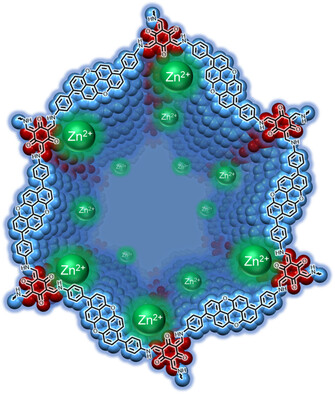 Aqueous zinc-ion hybrid supercapacitors (Zn-HSCs) are promising devices for sustainable and efficient energy storage. However, they suffer from a limited energy density compared to lithium-ion batteries. This limitation can be overcome by developing novel electrode materials, with covalent organic frameworks (COFs) standing out as a particularly intriguing option. Herein, peri-xanthenoxanthene (PXX) has been integrated for the first time into a COF scaffold to take advantage of its straightforward synthesis, chemical stability, π-conjugated backbone, and heteroatom content endowing reversible redox reactions at low potentials. Two novel hexagonal COFs have been designed and synthesized by tethering of a PXX-diamine unit having a C2 symmetry with two distinct tris-aldehydes acting as C3-symmetric cornerstones, i.e., triformyl benzene (TFB) and triformylphloroglucinol (Tp), ultimately yielding COF PXX(PhNH2)2-TFB and COF PXX(PhNH2)2-Tp, respectively. As cathodes in Zn-HSCs, COF PXX(PhNH2)2-Tp exhibits a remarkable specific capacitance, energy, and power densities (237 F g−1, 106.6 Wh kg−1, and 3.0 kW kg−1, respectively), surpassing those of COF PXX(PhNH2)2-TFB (109 F g−1, 49.1 Wh kg−1, and 0.67 kW kg−1). Importantly, both COFs display outstanding long-term stability, over 5000 charge/discharge cycles, with capacitance retention >92%. These findings underscore the potential of PXX-based COFs as high-performance cathode materials for HSCs, thereby offering a promising new avenue for energy storage technologies.
Aqueous zinc-ion hybrid supercapacitors (Zn-HSCs) are promising devices for sustainable and efficient energy storage. However, they suffer from a limited energy density compared to lithium-ion batteries. This limitation can be overcome by developing novel electrode materials, with covalent organic frameworks (COFs) standing out as a particularly intriguing option. Herein, peri-xanthenoxanthene (PXX) has been integrated for the first time into a COF scaffold to take advantage of its straightforward synthesis, chemical stability, π-conjugated backbone, and heteroatom content endowing reversible redox reactions at low potentials. Two novel hexagonal COFs have been designed and synthesized by tethering of a PXX-diamine unit having a C2 symmetry with two distinct tris-aldehydes acting as C3-symmetric cornerstones, i.e., triformyl benzene (TFB) and triformylphloroglucinol (Tp), ultimately yielding COF PXX(PhNH2)2-TFB and COF PXX(PhNH2)2-Tp, respectively. As cathodes in Zn-HSCs, COF PXX(PhNH2)2-Tp exhibits a remarkable specific capacitance, energy, and power densities (237 F g−1, 106.6 Wh kg−1, and 3.0 kW kg−1, respectively), surpassing those of COF PXX(PhNH2)2-TFB (109 F g−1, 49.1 Wh kg−1, and 0.67 kW kg−1). Importantly, both COFs display outstanding long-term stability, over 5000 charge/discharge cycles, with capacitance retention >92%. These findings underscore the potential of PXX-based COFs as high-performance cathode materials for HSCs, thereby offering a promising new avenue for energy storage technologies.
Emissive brightening in molecular graphene nanoribbons by twilight states
B. K. Sturdza, F. Kong, X. Yao, W. Niu, J. Ma, X. Feng, M. K. Riede, L. Bogani, R. J. Nicholas
Nat. Commun., 2024, 15, 2985. Link to article (open access).
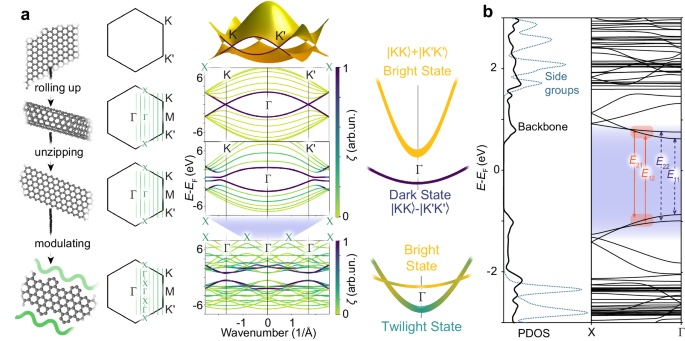 Carbon nanomaterials are expected to be bright and efficient emitters, but structural disorder, intermolecular interactions and the intrinsic presence of dark states suppress their photoluminescence. Here, we study synthetically-made graphene nanoribbons with atomically precise edges and which are designed to suppress intermolecular interactions to demonstrate strong photoluminescence in both solutions and thin films. The resulting high spectral resolution reveals strong vibron-electron coupling from the radial-breathing-like mode of the ribbons. In addition, their cove-edge structure produces inter-valley mixing, which brightens conventionally-dark states to generate hitherto-unrecognised twilight states as predicted by theory. The coupling of these states to the nanoribbon phonon modes affects absorption and emission differently, suggesting a complex interaction with both Herzberg–Teller and Franck– Condon coupling present. Detailed understanding of the fundamental electronic processes governing the optical response will help the tailored chemical design of nanocarbon optical devices, via gap tuning and side-chain functionalisation.
Carbon nanomaterials are expected to be bright and efficient emitters, but structural disorder, intermolecular interactions and the intrinsic presence of dark states suppress their photoluminescence. Here, we study synthetically-made graphene nanoribbons with atomically precise edges and which are designed to suppress intermolecular interactions to demonstrate strong photoluminescence in both solutions and thin films. The resulting high spectral resolution reveals strong vibron-electron coupling from the radial-breathing-like mode of the ribbons. In addition, their cove-edge structure produces inter-valley mixing, which brightens conventionally-dark states to generate hitherto-unrecognised twilight states as predicted by theory. The coupling of these states to the nanoribbon phonon modes affects absorption and emission differently, suggesting a complex interaction with both Herzberg–Teller and Franck– Condon coupling present. Detailed understanding of the fundamental electronic processes governing the optical response will help the tailored chemical design of nanocarbon optical devices, via gap tuning and side-chain functionalisation.
Hydrogen-Assisted Thermal Treatment of Electrode Materials for Electrochemical Double-Layer Capacitors
M. Gentile, S. Bellani, M. I. Zappia, A. Gamberini, V. Mastronardi, M. Abruzzese, L. Gabatel, L. Pasquale, S. Marras, A. Bagheri, H. Beydaghi, E. L. Papadopoulou, G. Lanzani, F. Bonaccorso
ACS Appl. Mater. Interfaces, 2024, 16, 13706–13718. Link to article (open access).
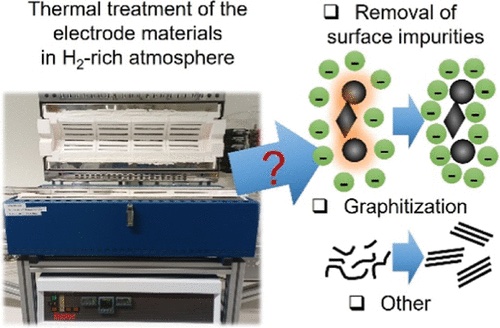 The capacitance of electrode materials used in electrochemical double-layer capacitors (EDLCs) is currently limited by several factors, including inaccessible isolated micropores in high-surface area carbons, the finite density of states resulting in a quantum capacitance in series to Helmholtz double-layer capacitance, and the presence of surface impurities, such as functional groups and adsorbed species. To unlock the full potential of EDLC active materials and corresponding electrodes, several post-production treatments are commonly proposed to improve their capacitance and, thus, the energy density of the corresponding devices. In this work, we report a systematic study of the effect of a prototypical treatment, namely H2-assisted thermal treatment, on the chemical, structural, and thermal properties of activated carbon and corresponding electrodes. By combining multiple characterization techniques, we clarify the actual origins of the improvement of the performance (e.g., > +35% energy density for the investigated power densities in the 0.5–45 kW kg–1 range) of the EDLCs based on treated electrodes compared to the case based on the pristine electrodes. Contrary to previous works supporting a questionable graphitization of the activated carbon at temperatures <1000 °C, we found that a “surface graphitization” of the activated carbon, detected by spectroscopic analysis, is mainly associated with the desorption of surface contaminants. The elimination of surface impurities, including adsorbed species, improves the surface capacitance of the activated carbon (CsurfAC) by +37.1 and +36.3% at specific currents of 1 and 10 A g–1, respectively. Despite the presence of slight densification of the activated carbon upon the thermal treatment, the latter still improves the cell gravimetric capacitance normalized on the mass of the activated carbon only (CgAC), e.g., + 28% at 1 A g–1. Besides, our holistic approach identifies the change in the active material and binder contents as a concomitant cause of the increase of cell gravimetric capacitance (Cg), accounting for the mass of all of the electrode materials measured for treated electrodes compared to pristine ones. Overall, this study provides new insights into the relationship between the modifications of the electrode materials induced by H2-assisted thermal treatments and the performance of the resulting EDLCs.
The capacitance of electrode materials used in electrochemical double-layer capacitors (EDLCs) is currently limited by several factors, including inaccessible isolated micropores in high-surface area carbons, the finite density of states resulting in a quantum capacitance in series to Helmholtz double-layer capacitance, and the presence of surface impurities, such as functional groups and adsorbed species. To unlock the full potential of EDLC active materials and corresponding electrodes, several post-production treatments are commonly proposed to improve their capacitance and, thus, the energy density of the corresponding devices. In this work, we report a systematic study of the effect of a prototypical treatment, namely H2-assisted thermal treatment, on the chemical, structural, and thermal properties of activated carbon and corresponding electrodes. By combining multiple characterization techniques, we clarify the actual origins of the improvement of the performance (e.g., > +35% energy density for the investigated power densities in the 0.5–45 kW kg–1 range) of the EDLCs based on treated electrodes compared to the case based on the pristine electrodes. Contrary to previous works supporting a questionable graphitization of the activated carbon at temperatures <1000 °C, we found that a “surface graphitization” of the activated carbon, detected by spectroscopic analysis, is mainly associated with the desorption of surface contaminants. The elimination of surface impurities, including adsorbed species, improves the surface capacitance of the activated carbon (CsurfAC) by +37.1 and +36.3% at specific currents of 1 and 10 A g–1, respectively. Despite the presence of slight densification of the activated carbon upon the thermal treatment, the latter still improves the cell gravimetric capacitance normalized on the mass of the activated carbon only (CgAC), e.g., + 28% at 1 A g–1. Besides, our holistic approach identifies the change in the active material and binder contents as a concomitant cause of the increase of cell gravimetric capacitance (Cg), accounting for the mass of all of the electrode materials measured for treated electrodes compared to pristine ones. Overall, this study provides new insights into the relationship between the modifications of the electrode materials induced by H2-assisted thermal treatments and the performance of the resulting EDLCs.
Enhancing Chiroptical Responses in Helical Nanographenes via Geometric Engineering of Double [7]Helicenes
W. Niu, Y. Fu, Q. Deng, Z.-L. Qiu, F. Liu, A. A. Popov, H. Komber, J. Ma, X. Feng
Angew. Chem. Int. Ed., 2024, 63, e202319874. Link to article (open access).
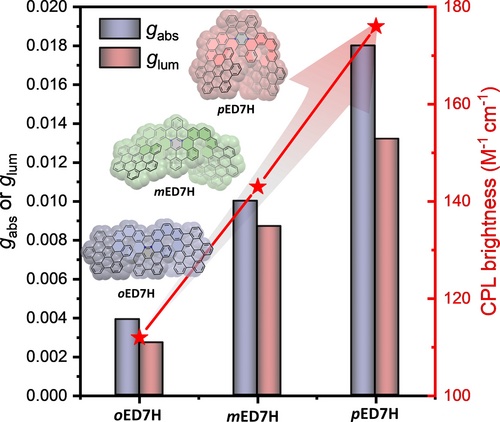 Helical nanographenes with high quantum yields and strong chiroptical responses are pivotal for developing circularly polarized luminescence (CPL) materials. Here, we present the successful synthesis of novel π-extended double [7]helicenes (ED7Hs) where two helicene units are fused at the meta- or para-position of the middle benzene ring, respectively, as the structural isomers of the reported ortho-fused ED7H. The structural geometry of these ED7Hs is clearly characterized by single-crystal X-ray analysis. Notably, this class of ED7Hs exhibits bright luminescence with high quantum yields exceeding 40 %. Through geometric regulation of two embedded [7]helicene units from ortho-, meta- to para-position, these ED7Hs display exceptional amplification in chiroptical responses. This enhancement is evident in a remarkable approximate fivefold increase in the absorbance and luminescence dissymmetry factors (gabs and glum), respectively, along with a boosted CPL brightness up to 176 M−1 cm−1, surpassing the performance of most helicene-based chiral NGs. Furthermore, DFT calculations elucidate that the geometric adjustment of two [7]helicene units allows the precise alignment of electric and magnetic transition dipole moments, leading to the observed enhancement of their chiroptical responses. This study offers an effective strategy for magnifying the CPL performance in chiral NGs, promoting their expanded application as CPL emitters.
Helical nanographenes with high quantum yields and strong chiroptical responses are pivotal for developing circularly polarized luminescence (CPL) materials. Here, we present the successful synthesis of novel π-extended double [7]helicenes (ED7Hs) where two helicene units are fused at the meta- or para-position of the middle benzene ring, respectively, as the structural isomers of the reported ortho-fused ED7H. The structural geometry of these ED7Hs is clearly characterized by single-crystal X-ray analysis. Notably, this class of ED7Hs exhibits bright luminescence with high quantum yields exceeding 40 %. Through geometric regulation of two embedded [7]helicene units from ortho-, meta- to para-position, these ED7Hs display exceptional amplification in chiroptical responses. This enhancement is evident in a remarkable approximate fivefold increase in the absorbance and luminescence dissymmetry factors (gabs and glum), respectively, along with a boosted CPL brightness up to 176 M−1 cm−1, surpassing the performance of most helicene-based chiral NGs. Furthermore, DFT calculations elucidate that the geometric adjustment of two [7]helicene units allows the precise alignment of electric and magnetic transition dipole moments, leading to the observed enhancement of their chiroptical responses. This study offers an effective strategy for magnifying the CPL performance in chiral NGs, promoting their expanded application as CPL emitters.
Bistability between π-diradical open-shell and closed-shell states in indeno[1,2-a]fluorene
S. Mishra, M. Vilas-Varela, L.-A. Lieske, R. Ortiz, S. Fatayer, I. Rončević, F. Albrecht, T. Frederiksen, D. Peña, L. Gross
Nat. Chem., 2024, 16, 755–761. Link to article (open access).
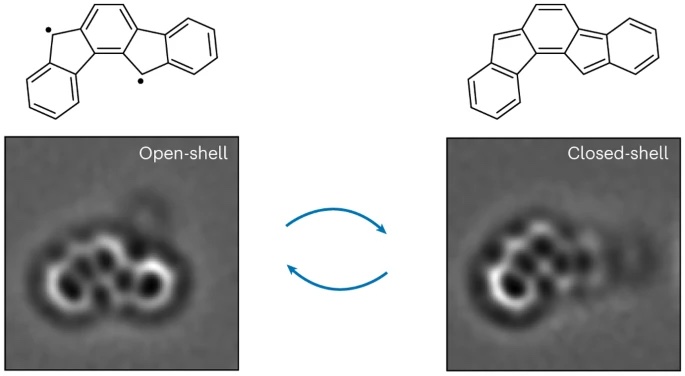 Indenofluorenes are non-benzenoid conjugated hydrocarbons that have received great interest owing to their unusual electronic structure and potential applications in nonlinear optics and photovoltaics. Here we report the generation of unsubstituted indeno[1,2-a]fluorene on various surfaces by the cleavage of two C–H bonds in 7,12-dihydroindeno[1,2-a]fluorene through voltage pulses applied by the tip of a combined scanning tunnelling microscope and atomic force microscope. On bilayer NaCl on Au(111), indeno[1,2-a]fluorene is in the neutral charge state, but it exhibits charge bistability between neutral and anionic states on the lower-workfunction surfaces of bilayer NaCl on Ag(111) and Cu(111). In the neutral state, indeno[1,2-a]fluorene exhibits one of two ground states: an open-shell π-diradical state, predicted to be a triplet by density functional and multireference many-body perturbation theory calculations, or a closed-shell state with a para-quinodimethane moiety in the as-indacene core. We observe switching between open- and closed-shell states of a single molecule by changing its adsorption site on NaCl.
Indenofluorenes are non-benzenoid conjugated hydrocarbons that have received great interest owing to their unusual electronic structure and potential applications in nonlinear optics and photovoltaics. Here we report the generation of unsubstituted indeno[1,2-a]fluorene on various surfaces by the cleavage of two C–H bonds in 7,12-dihydroindeno[1,2-a]fluorene through voltage pulses applied by the tip of a combined scanning tunnelling microscope and atomic force microscope. On bilayer NaCl on Au(111), indeno[1,2-a]fluorene is in the neutral charge state, but it exhibits charge bistability between neutral and anionic states on the lower-workfunction surfaces of bilayer NaCl on Ag(111) and Cu(111). In the neutral state, indeno[1,2-a]fluorene exhibits one of two ground states: an open-shell π-diradical state, predicted to be a triplet by density functional and multireference many-body perturbation theory calculations, or a closed-shell state with a para-quinodimethane moiety in the as-indacene core. We observe switching between open- and closed-shell states of a single molecule by changing its adsorption site on NaCl.
Tailoring Magnetism of Graphene Nanoflakes via Tip-Controlled Dehydrogenation
C. Zhao, Q. Huang, L. Valenta, K. Eimre, L. Yang, A. V. Yakutovich, W. Xu, J. Ma, X. Feng, M. Juríček, R. Fasel, P. Ruffieux, C. A. Pignedoli
Phys. Rev. Lett., 2024, 132, 046201. Link to article.
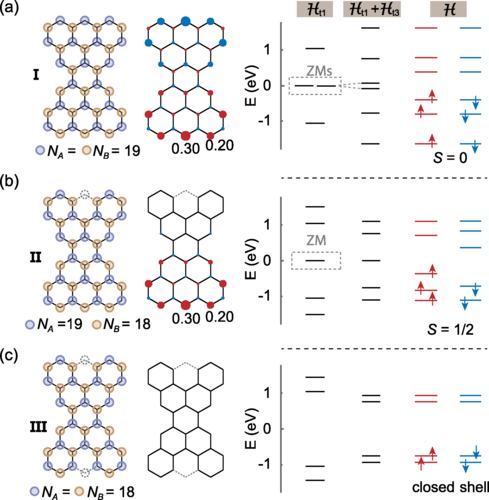 Atomically precise graphene nanoflakes called nanographenes have emerged as a promising platform to realize carbon magnetism. Their ground state spin configuration can be anticipated by Ovchinnikov-Lieb rules based on the mismatch of π electrons from two sublattices. While rational geometrical design achieves specific spin configurations, further direct control over the π electrons offers a desirable extension for efficient spin manipulations and potential quantum device operations. To this end, we apply a site-specific dehydrogenation using a scanning tunneling microscope tip to nanographenes deposited on a Au(111) substrate, which shows the capability of precisely tailoring the underlying π-electron system and therefore efficiently manipulating their magnetism. Through first-principles calculations and tight-binding mean-field-Hubbard modeling, we demonstrate that the dehydrogenation-induced Au—C bond formation along with the resulting hybridization between frontier π orbitals and Au substrate states effectively eliminate the unpaired π electron. Our results establish an efficient technique for controlling the magnetism of nanographenes.
Atomically precise graphene nanoflakes called nanographenes have emerged as a promising platform to realize carbon magnetism. Their ground state spin configuration can be anticipated by Ovchinnikov-Lieb rules based on the mismatch of π electrons from two sublattices. While rational geometrical design achieves specific spin configurations, further direct control over the π electrons offers a desirable extension for efficient spin manipulations and potential quantum device operations. To this end, we apply a site-specific dehydrogenation using a scanning tunneling microscope tip to nanographenes deposited on a Au(111) substrate, which shows the capability of precisely tailoring the underlying π-electron system and therefore efficiently manipulating their magnetism. Through first-principles calculations and tight-binding mean-field-Hubbard modeling, we demonstrate that the dehydrogenation-induced Au—C bond formation along with the resulting hybridization between frontier π orbitals and Au substrate states effectively eliminate the unpaired π electron. Our results establish an efficient technique for controlling the magnetism of nanographenes.
Chain-growth polymerization enables the controlled synthesis of graphene nanoribbons
J. Ma, X. Feng
Chem, 2024, 10, 435–437. Link to article.
Precision graphene nanoribbons (GNRs) have garnered significant interest because of their unique and tailorable electronic properties. In this issue of Chem, Fischer and co-workers present a hybrid approach that combines chain-growth Suzuki catalyst-transfer polymerization with a surface-assisted cyclodehydrogenation reaction, enabling precise control over GNR length and end groups.
Cove-Edged Chiral Graphene Nanoribbons with Chirality-Dependent Bandgap and Carrier Mobility
K. Liu, W. Zheng, S. Osella, Z.-L. Qiu, S. Böckmann, W. Niu, L. Meingast, H. Komber, S. Obermann, R. Gillen, M. Bonn, M. R. Hansen, J. Maultzsch, H. I. Wang, J. Ma, X. Feng
J. Am. Chem. Soc., 2024, 146, 1026–1034. Link to article.
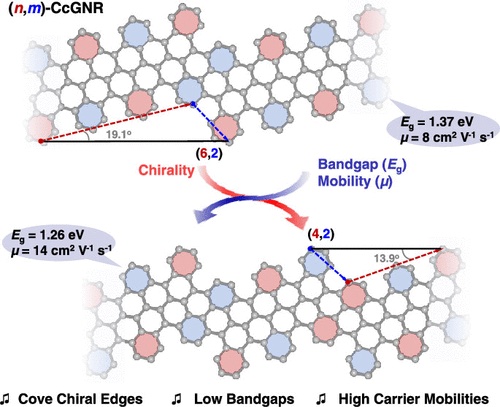 Graphene nanoribbons (GNRs) have garnered significant interest due to their highly customizable physicochemical properties and potential utility in nanoelectronics. Besides controlling widths and edge structures, the inclusion of chirality in GNRs brings another dimension for fine-tuning their optoelectronic properties, but related studies remain elusive owing to the absence of feasible synthetic strategies. Here, we demonstrate a novel class of cove-edged chiral GNRs (CcGNRs) with a tunable chiral vector (n,m). Notably, the bandgap and effective mass of (n,2)-CcGNR show a distinct positive correlation with the increasing value of n, as indicated by theory. Within this GNR family, two representative members, namely, (4,2)-CcGNR and (6,2)-CcGNR, are successfully synthesized. Both CcGNRs exhibit prominently curved geometries arising from the incorporated [4]helicene motifs along their peripheries, as also evidenced by the single-crystal structures of the two respective model compounds (1 and 2). The chemical identities and optoelectronic properties of (4,2)- and (6,2)-CcGNRs are comprehensively investigated via a combination of IR, Raman, solid-state NMR, UV–vis, and THz spectroscopies as well as theoretical calculations. In line with theoretical expectation, the obtained (6,2)-CcGNR possesses a low optical bandgap of 1.37 eV along with charge carrier mobility of ∼8 cm2 V–1 s–1, whereas (4,2)-CcGNR exhibits a narrower bandgap of 1.26 eV with increased mobility of ∼14 cm2 V–1 s–1. This work opens up a new avenue to precisely engineer the bandgap and carrier mobility of GNRs by manipulating their chiral vector.
Graphene nanoribbons (GNRs) have garnered significant interest due to their highly customizable physicochemical properties and potential utility in nanoelectronics. Besides controlling widths and edge structures, the inclusion of chirality in GNRs brings another dimension for fine-tuning their optoelectronic properties, but related studies remain elusive owing to the absence of feasible synthetic strategies. Here, we demonstrate a novel class of cove-edged chiral GNRs (CcGNRs) with a tunable chiral vector (n,m). Notably, the bandgap and effective mass of (n,2)-CcGNR show a distinct positive correlation with the increasing value of n, as indicated by theory. Within this GNR family, two representative members, namely, (4,2)-CcGNR and (6,2)-CcGNR, are successfully synthesized. Both CcGNRs exhibit prominently curved geometries arising from the incorporated [4]helicene motifs along their peripheries, as also evidenced by the single-crystal structures of the two respective model compounds (1 and 2). The chemical identities and optoelectronic properties of (4,2)- and (6,2)-CcGNRs are comprehensively investigated via a combination of IR, Raman, solid-state NMR, UV–vis, and THz spectroscopies as well as theoretical calculations. In line with theoretical expectation, the obtained (6,2)-CcGNR possesses a low optical bandgap of 1.37 eV along with charge carrier mobility of ∼8 cm2 V–1 s–1, whereas (4,2)-CcGNR exhibits a narrower bandgap of 1.26 eV with increased mobility of ∼14 cm2 V–1 s–1. This work opens up a new avenue to precisely engineer the bandgap and carrier mobility of GNRs by manipulating their chiral vector.
Tuneable Permeability to H2, CO2, He, and Ar in Graphene Oxide−PDDA Self-Assembled Multilayers, Yielding Good Selectivity at High Flux
G. Foli, A. Kovtun, F. Liscio, E. Battaglini, S. Ligi, M. Fiorini, M. Minelli, V. Palermo
Adv. Mater. Interfaces, 2024, 11, 2300357. Link to article (open access). Featured in Hot Topic: Carbon, Graphite, and Graphene.
 Today, the most effective and suitable method to obtain molecular H2 is the extraction from mixtures where it is present, using gas-sieving membranes. To this aim, the preparation and characterization of layered nano-composites are described, made of alternated layers of positively charged Poly(Diallyl Dimethyl Ammonium chloride) (PDDA) and negatively charged graphene oxide (GO) nanosheets with high and tunable selectivity for H2 purification. The composites are assembled exploiting electrostatic interactions and the layer-by-layer technique; this study correlates permeance tests with changes in chemical composition and structure of the material using X-rays Photoelectron Spectroscopy, X-rays diffraction water contact angle, and surface zeta-potential measurements. Thanks to its layered nature, the GO-PDDA composite shows an excellent selectivity, allowing faster permeation of H2 as compared to CO2 and Argon. By transforming the GO to reduced GO, the porosity of the nanosheets can be further increased, in this way increasing the permeance of the material and its selectivity at the same time, thus allowing to overcome the Robeson limit, the technological upper boundary to the performance of actual membranes.
Today, the most effective and suitable method to obtain molecular H2 is the extraction from mixtures where it is present, using gas-sieving membranes. To this aim, the preparation and characterization of layered nano-composites are described, made of alternated layers of positively charged Poly(Diallyl Dimethyl Ammonium chloride) (PDDA) and negatively charged graphene oxide (GO) nanosheets with high and tunable selectivity for H2 purification. The composites are assembled exploiting electrostatic interactions and the layer-by-layer technique; this study correlates permeance tests with changes in chemical composition and structure of the material using X-rays Photoelectron Spectroscopy, X-rays diffraction water contact angle, and surface zeta-potential measurements. Thanks to its layered nature, the GO-PDDA composite shows an excellent selectivity, allowing faster permeation of H2 as compared to CO2 and Argon. By transforming the GO to reduced GO, the porosity of the nanosheets can be further increased, in this way increasing the permeance of the material and its selectivity at the same time, thus allowing to overcome the Robeson limit, the technological upper boundary to the performance of actual membranes.
Enhancing the Carrier Transport in Monolayer MoS2 through Interlayer Coupling with 2D Covalent Organic Frameworks
C. Wang, L. Cusin, C. Ma, E. Unsal, H. Wang, V. Girelli Consolaro, V. Montes-García, B. Han, S. Vitale, A. Dianat, A. Croy, H. Zhang, R. Gutierrez, G. Cuniberti, Z. Liu, L. Chi, A. Ciesielski, P. Samorì
Adv. Mater., 2024, 36, 2305882. Link to article (open access). Featured in Hot Topic: Surfaces and Interfaces.
 The coupling of different 2D materials (2DMs) to form van der Waals heterostructures (vdWHs) is a powerful strategy for adjusting the electronic properties of 2D semiconductors, for applications in opto-electronics and quantum computing. 2D molybdenum disulfide (MoS2) represents an archetypical semiconducting, monolayer thick versatile platform for the generation of hybrid vdWH with tunable charge transport characteristics through its interfacing with molecules and assemblies thereof. However, the physisorption of (macro)molecules on 2D MoS2 yields hybrids possessing a limited thermal stability, thereby jeopardizing their technological applications. Herein, the rational design and optimized synthesis of 2D covalent organic frameworks (2D-COFs) for the generation of MoS2/2D-COF vdWHs exhibiting strong interlayer coupling effects are reported. The high crystallinity of the 2D-COF films makes it possible to engineer an ultrastable periodic doping effect on MoS2, boosting devices’ field-effect mobility at room temperature. Such a performance increase can be attributed to the synergistic effect of the efficient interfacial electron transfer process and the pronounced suppression of MoS2’s lattice vibration. This proof-of-concept work validates an unprecedented approach for the efficient modulation of the electronic properties of 2D transition metal dichalcogenides toward high-performance (opto)electronics for CMOS digital circuits.
The coupling of different 2D materials (2DMs) to form van der Waals heterostructures (vdWHs) is a powerful strategy for adjusting the electronic properties of 2D semiconductors, for applications in opto-electronics and quantum computing. 2D molybdenum disulfide (MoS2) represents an archetypical semiconducting, monolayer thick versatile platform for the generation of hybrid vdWH with tunable charge transport characteristics through its interfacing with molecules and assemblies thereof. However, the physisorption of (macro)molecules on 2D MoS2 yields hybrids possessing a limited thermal stability, thereby jeopardizing their technological applications. Herein, the rational design and optimized synthesis of 2D covalent organic frameworks (2D-COFs) for the generation of MoS2/2D-COF vdWHs exhibiting strong interlayer coupling effects are reported. The high crystallinity of the 2D-COF films makes it possible to engineer an ultrastable periodic doping effect on MoS2, boosting devices’ field-effect mobility at room temperature. Such a performance increase can be attributed to the synergistic effect of the efficient interfacial electron transfer process and the pronounced suppression of MoS2’s lattice vibration. This proof-of-concept work validates an unprecedented approach for the efficient modulation of the electronic properties of 2D transition metal dichalcogenides toward high-performance (opto)electronics for CMOS digital circuits.
On-water surface synthesis of electronically coupled 2D polyimide-MoS2 van der Waals heterostructure
A. Prasoon, H. Yang, M. Hambsch, N. N. Nguyen, S. Chung, A. Müller, Z. Wang, T. Lan, P. Fontaine, T. D. Kühne, K. Cho, A. S. Nia, S. C. B. Mannsfeld, R. Dong, X. Feng
Commun. Chem., 2023, 6, 280. Link to article (open access).
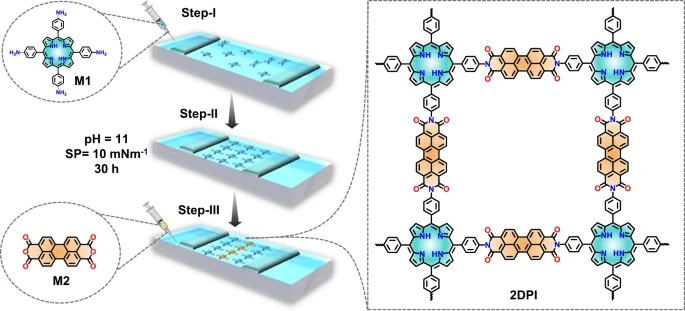 The water surface provides a highly effective platform for the synthesis of two-dimensional polymers (2DP). In this study, we present an efficient on-water surface synthesis of crystalline monolayer 2D polyimide (2DPI) through the imidization reaction between tetra (4-aminophenyl) porphyrin (M1) and perylenetracarboxylic dianhydride (M2), resulting in excellent stability and coverage over a large area (tens of cm2). We further fabricate innovative organic-inorganic hybrid van der Waals heterostructures (vdWHs) by combining with exfoliated few-layer molybdenum sulfide (MoS2). High-resolution transmission electron microscopy (HRTEM) reveals face-to-face stacking between MoS2 and 2DPI within the vdWH. This stacking configuration facilitates remarkable charge transfer and noticeable n-type doping effects from monolayer 2DPI to MoS2, as corroborated by Raman spectroscopy, photoluminescence measurements, and field-effect transistor (FET) characterizations. Notably, the 2DPI-MoS2 vdWH exhibits an impressive electron mobility of 50 cm2/V·s, signifying a substantial improvement over pristine MoS2 (8 cm2/V·s). This study unveils the immense potential of integrating 2D polymers to enhance semiconductor device functionality through tailored vdWHs, thereby opening up exciting new avenues for exploring unique interfacial physical phenomena.
The water surface provides a highly effective platform for the synthesis of two-dimensional polymers (2DP). In this study, we present an efficient on-water surface synthesis of crystalline monolayer 2D polyimide (2DPI) through the imidization reaction between tetra (4-aminophenyl) porphyrin (M1) and perylenetracarboxylic dianhydride (M2), resulting in excellent stability and coverage over a large area (tens of cm2). We further fabricate innovative organic-inorganic hybrid van der Waals heterostructures (vdWHs) by combining with exfoliated few-layer molybdenum sulfide (MoS2). High-resolution transmission electron microscopy (HRTEM) reveals face-to-face stacking between MoS2 and 2DPI within the vdWH. This stacking configuration facilitates remarkable charge transfer and noticeable n-type doping effects from monolayer 2DPI to MoS2, as corroborated by Raman spectroscopy, photoluminescence measurements, and field-effect transistor (FET) characterizations. Notably, the 2DPI-MoS2 vdWH exhibits an impressive electron mobility of 50 cm2/V·s, signifying a substantial improvement over pristine MoS2 (8 cm2/V·s). This study unveils the immense potential of integrating 2D polymers to enhance semiconductor device functionality through tailored vdWHs, thereby opening up exciting new avenues for exploring unique interfacial physical phenomena.
Site-selective chemical reactions by on-water surface sequential assembly
A. Prasoon, X. Yu, M. Hambsch, D. Bodesheim, K. Liu, A. Zacarias, N. N. Nguyen, T. Seki, A. Dianat, A. Croy, G. Cuniberti, P. Fontaine, Y. Nagata, S. C. B. Mannsfeld, R. Dong, M. Bonn, X. Feng
Nat. Commun., 2023, 14, 8313. Link to article (open access).
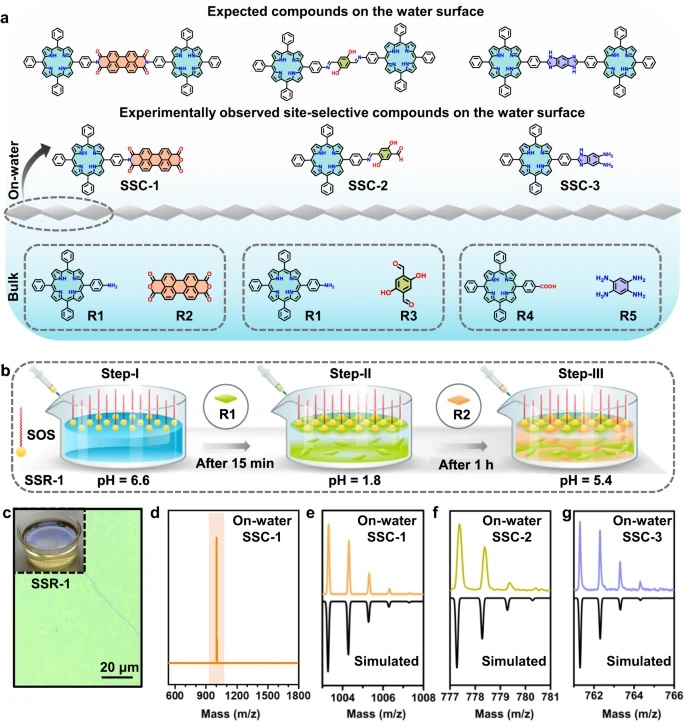 Controlling site-selectivity and reactivity in chemical reactions continues to be a key challenge in modern synthetic chemistry. Here, we demonstrate the discovery of site-selective chemical reactions on the water surface via a sequential assembly approach. A negatively charged surfactant monolayer on the water surface guides the electrostatically driven, epitaxial, and aligned assembly of reagent amino-substituted porphyrin molecules, resulting in a well-defined J-aggregated structure. This constrained geometry of the porphyrin molecules prompts the subsequent directional alignment of the perylenetetracarboxylic dianhydride reagent, enabling the selective formation of a one-sided imide bond between porphyrin and reagent. Surface-specific in-situ spectroscopies reveal the underlying mechanism of the dynamic interface that promotes multilayer growth of the site-selective imide product. The site-selective reaction on the water surface is further demonstrated by three reversible and irreversible chemical reactions, such as imide-, imine-, and 1, 3-diazole (imidazole)- bonds involving porphyrin molecules. This unique sequential assembly approach enables site-selective chemical reactions that can bring on-water surface synthesis to the forefront of modern organic chemistry.
Controlling site-selectivity and reactivity in chemical reactions continues to be a key challenge in modern synthetic chemistry. Here, we demonstrate the discovery of site-selective chemical reactions on the water surface via a sequential assembly approach. A negatively charged surfactant monolayer on the water surface guides the electrostatically driven, epitaxial, and aligned assembly of reagent amino-substituted porphyrin molecules, resulting in a well-defined J-aggregated structure. This constrained geometry of the porphyrin molecules prompts the subsequent directional alignment of the perylenetetracarboxylic dianhydride reagent, enabling the selective formation of a one-sided imide bond between porphyrin and reagent. Surface-specific in-situ spectroscopies reveal the underlying mechanism of the dynamic interface that promotes multilayer growth of the site-selective imide product. The site-selective reaction on the water surface is further demonstrated by three reversible and irreversible chemical reactions, such as imide-, imine-, and 1, 3-diazole (imidazole)- bonds involving porphyrin molecules. This unique sequential assembly approach enables site-selective chemical reactions that can bring on-water surface synthesis to the forefront of modern organic chemistry.
π-Extended Helical Multilayer Nanographenes with Layer-Dependent Chiroptical Properties
W. Niu, Y. Fu, Z.-L. Qiu, C. J. Schürmann, S. Obermann, F. Liu, A. A. Popov, H. Komber, J. Ma, X. Feng
J. Am. Chem. Soc., 2023, 145, 26824–26832. Link to article.
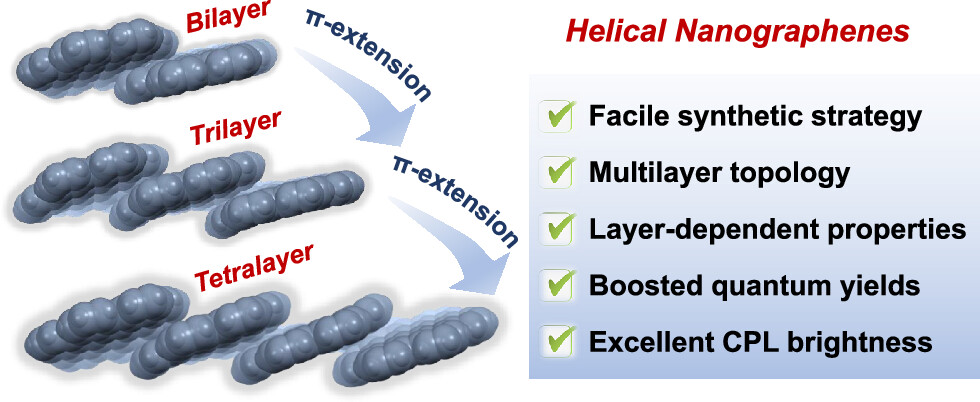 Helical nanographenes (NGs) have attracted increasing attention recently because of their intrinsic chirality and exotic chiroptical properties. However, the efficient synthesis of extended helical NGs featuring a multilayer topology is still underdeveloped, and their layer-dependent chiroptical properties remain elusive. In this study, we demonstrate a modular synthetic strategy to construct a series of novel helical NGs (1–3) with a multilayer topology through a consecutive Diels–Alder reaction and regioselective cyclodehydrogenation from the readily accessible phenanthrene-based precursors bearing ethynyl groups. The resultant NGs exhibit bilayer, trilayer, and tetralayer structures with elongated π extension and rigid helical backbones, as unambiguously confirmed by single-crystal X-ray or electron diffraction analysis. We find that the photophysical properties of these helical NGs are notably influenced by the degree of π extension, which varies with the number of layers, leading to obvious redshifted absorption, a fast rising molar extinction coefficient (ε), and markedly boosted fluorescence quantum yield (Φf). Moreover, the embedded [7]helicene subunits in these NGs result in stable chirality, enabling both chiral resolution and exploration of their layer-dependent chiroptical properties. Profiting from the good alignment of electric and magnetic dipole moments determined by the multilayer structure, the resultant NGs exhibit excellent circular dichroism and circularly polarized luminescence response with unprecedented high CPL brightness up to 168 M–1 cm–1, rendering them promising candidates for CPL emitters.
Helical nanographenes (NGs) have attracted increasing attention recently because of their intrinsic chirality and exotic chiroptical properties. However, the efficient synthesis of extended helical NGs featuring a multilayer topology is still underdeveloped, and their layer-dependent chiroptical properties remain elusive. In this study, we demonstrate a modular synthetic strategy to construct a series of novel helical NGs (1–3) with a multilayer topology through a consecutive Diels–Alder reaction and regioselective cyclodehydrogenation from the readily accessible phenanthrene-based precursors bearing ethynyl groups. The resultant NGs exhibit bilayer, trilayer, and tetralayer structures with elongated π extension and rigid helical backbones, as unambiguously confirmed by single-crystal X-ray or electron diffraction analysis. We find that the photophysical properties of these helical NGs are notably influenced by the degree of π extension, which varies with the number of layers, leading to obvious redshifted absorption, a fast rising molar extinction coefficient (ε), and markedly boosted fluorescence quantum yield (Φf). Moreover, the embedded [7]helicene subunits in these NGs result in stable chirality, enabling both chiral resolution and exploration of their layer-dependent chiroptical properties. Profiting from the good alignment of electric and magnetic dipole moments determined by the multilayer structure, the resultant NGs exhibit excellent circular dichroism and circularly polarized luminescence response with unprecedented high CPL brightness up to 168 M–1 cm–1, rendering them promising candidates for CPL emitters.
Solar-driven photodegradation of ciprofloxacin and E. coli growth inhibition using a Tm3+ upconverting nanoparticle-based polymer composite
S. Fan, J. E. Inkumsah Jnr, E. Trave, M. Gigli, T. Joshi, N. Licciardello, M. Sgarzi, G. Cuniberti
Chem. Eng. J., 2023, 476, 146877. Link to article (open access).
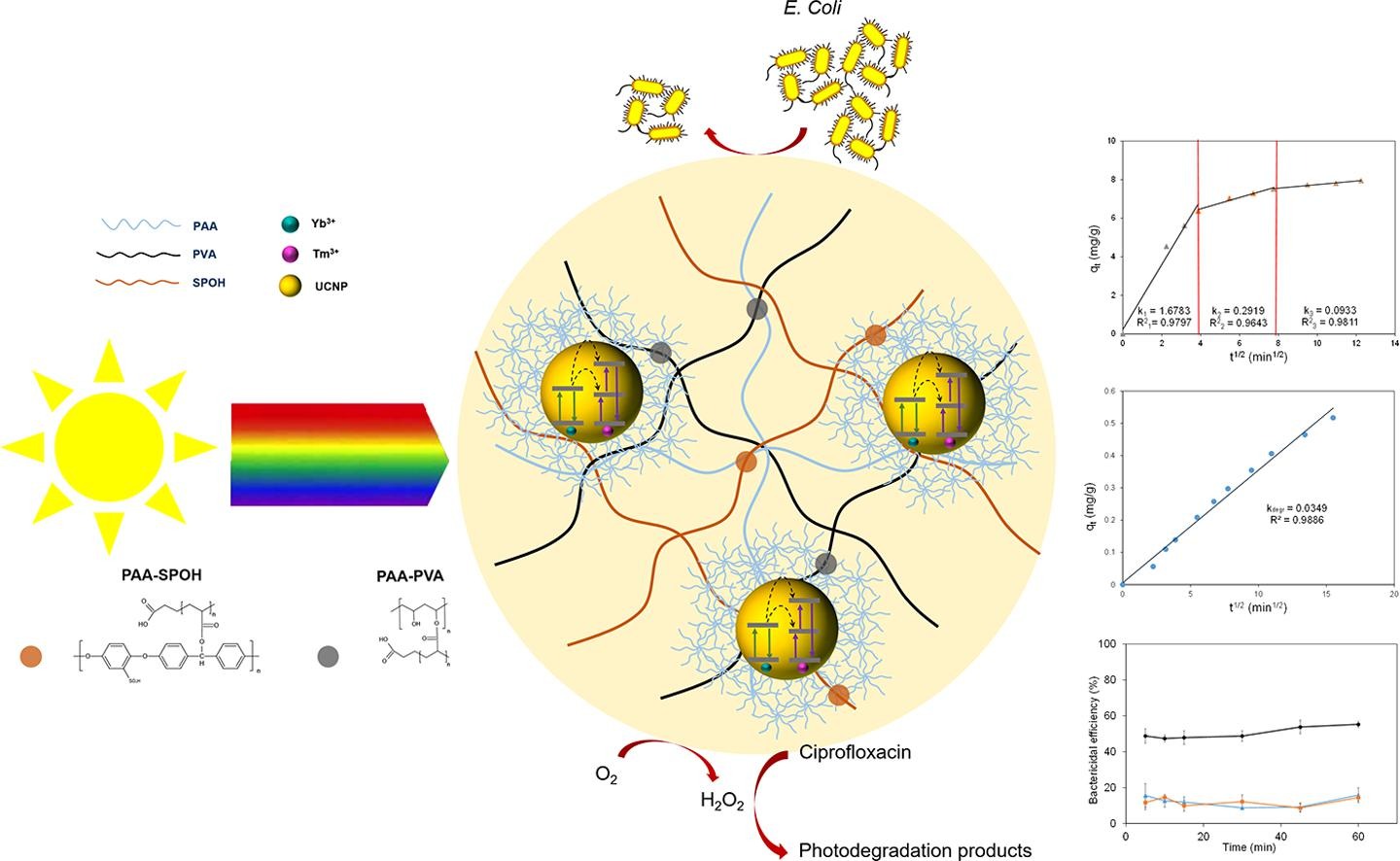 Solar-driven photocatalysis is of great interest in terms of a sustainable use of energy and its application in wastewater treatment. The UV light-driven photogeneration of H2O2 by solar irradiation is an advanced strategy for the treatment of bacteria and recalcitrant pollutants in wastewater, but suffers from low efficiencies. In this work, a solar-driven multifunctional nanocomposite consisting of Tm3+ upconverting nanoparticles, poly(vinyl alcohol), poly(acrylic acid) and hydroxylated sulfonated poly(ether ether ketone) was prepared. The components were crosslinked via a heating treatment at 170 °C, resulting in a non-leaching porous material. This nanocomposite exhibited excellent adsorption ability (89 % in 150 min) toward a 100 mg/L ciprofloxacin aqueous solution and proved to photodegrade it (50 %) upon 4 h artificial solar irradiation, exploiting photon upconversion processes. Moreover, an 80 % bactericidal effect against E. coli was registered upon sunlight irradiation. Altogether, these results suggest the feasibility of a solar-driven wastewater treatment based on upconverting nanoparticles.
Solar-driven photocatalysis is of great interest in terms of a sustainable use of energy and its application in wastewater treatment. The UV light-driven photogeneration of H2O2 by solar irradiation is an advanced strategy for the treatment of bacteria and recalcitrant pollutants in wastewater, but suffers from low efficiencies. In this work, a solar-driven multifunctional nanocomposite consisting of Tm3+ upconverting nanoparticles, poly(vinyl alcohol), poly(acrylic acid) and hydroxylated sulfonated poly(ether ether ketone) was prepared. The components were crosslinked via a heating treatment at 170 °C, resulting in a non-leaching porous material. This nanocomposite exhibited excellent adsorption ability (89 % in 150 min) toward a 100 mg/L ciprofloxacin aqueous solution and proved to photodegrade it (50 %) upon 4 h artificial solar irradiation, exploiting photon upconversion processes. Moreover, an 80 % bactericidal effect against E. coli was registered upon sunlight irradiation. Altogether, these results suggest the feasibility of a solar-driven wastewater treatment based on upconverting nanoparticles.
Pushing Up the Size Limit of Boron-doped peri-Acenes: Modular Synthesis and Characterizations
J.-J. Zhang, L. Yang, F. Liu, G. Serra, Y. Fu, A. Lucotti, A. A. Popov, M. Tommasini, J. Ma, X. Feng
Angew. Chem. Int. Ed., 2023, 62, e202312055. Link to article (open access).
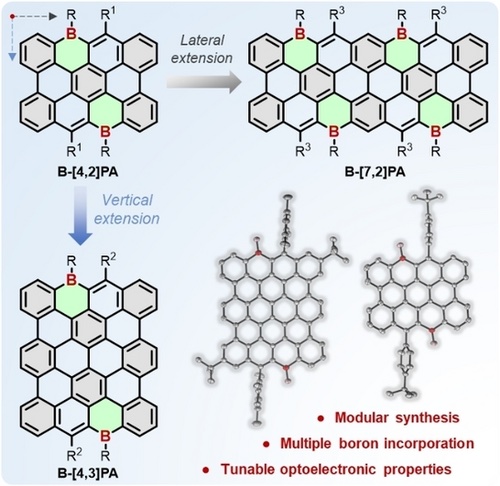 Heteroatom-doped peri-acenes (PAs) have recently attracted considerable attention considering their fascinating physical properties and chemical stability. However, the precise sole addition of boron atoms along the zigzag edges of PAs remains challenging, primarily due to the limited synthetic approach. Herein, we present a novel one-pot modular synthetic strategy toward unprecedented boron-doped PAs (B-PAs), including B-[4,2]PA (1 a-2), B-[4,3]PA (1 b-2) and B-[7,2]PA (1 c-3) derivatives, through efficient intramolecular electrophilic borylation. Their chemical structures are unequivocally confirmed with a combination of mass spectrometry, NMR, and single-crystal X-ray diffraction analysis. Notably, 1 b-2 exhibits an almost planar geometry, whereas 1 a-2 displays a distinctive bowl-like distortion. Furthermore, the optoelectronic properties of this series of B-PAs are thoroughly investigated by UV/Vis absorption and fluorescence spectroscopy combined with DFT calculation. Compared with their parent all-carbon analogs, the obtained B-PAs exhibit high stability, wide energy gaps, and high photoluminescence quantum yields of up to 84 %. This study reveals the exceptional ability of boron doping to finely tune the physicochemical properties of PAs, showcasing their potential applications in optoelectronics.
Heteroatom-doped peri-acenes (PAs) have recently attracted considerable attention considering their fascinating physical properties and chemical stability. However, the precise sole addition of boron atoms along the zigzag edges of PAs remains challenging, primarily due to the limited synthetic approach. Herein, we present a novel one-pot modular synthetic strategy toward unprecedented boron-doped PAs (B-PAs), including B-[4,2]PA (1 a-2), B-[4,3]PA (1 b-2) and B-[7,2]PA (1 c-3) derivatives, through efficient intramolecular electrophilic borylation. Their chemical structures are unequivocally confirmed with a combination of mass spectrometry, NMR, and single-crystal X-ray diffraction analysis. Notably, 1 b-2 exhibits an almost planar geometry, whereas 1 a-2 displays a distinctive bowl-like distortion. Furthermore, the optoelectronic properties of this series of B-PAs are thoroughly investigated by UV/Vis absorption and fluorescence spectroscopy combined with DFT calculation. Compared with their parent all-carbon analogs, the obtained B-PAs exhibit high stability, wide energy gaps, and high photoluminescence quantum yields of up to 84 %. This study reveals the exceptional ability of boron doping to finely tune the physicochemical properties of PAs, showcasing their potential applications in optoelectronics.
Exchange Interactions and Intermolecular Hybridization in a Spin-1/2 Nanographene Dimer
N. Krane, E. Turco, A. Bernhardt, D. Jacob, G. Gandus, D. Passerone, M. Luisier, M. Juríček, R. Fasel, J. Fernández-Rossier, P. Ruffieux
Nano Lett., 2023, 23, 9353–9359. Link to article and accepted manuscript (open access).
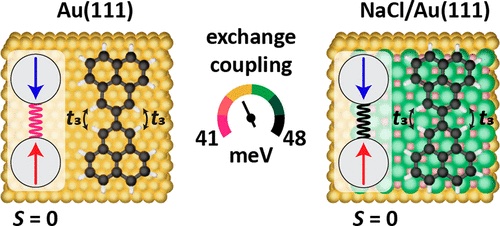 Phenalenyl is a radical nanographene with a triangular shape hosting an unpaired electron with spin S = 1/2. The open-shell nature of the phenalenyl is expected to be retained in covalently bonded networks. As a first step, we report synthesis of the phenalenyl dimer by combining in-solution synthesis and on-surface activation and its characterization on Au(111) and on a NaCl decoupling layer by means of inelastic electron tunneling spectroscopy (IETS). IETS shows inelastic steps that are identified as singlet–triplet excitation arising from interphenalenyl exchange. Spin excitation energies with and without the NaCl decoupling layer are 48 and 41 meV, respectively, indicating significant renormalization due to exchange with Au(111) electrons. Furthermore, third-neighbor hopping-induced interphenalenyl hybridization is fundamental to explaining the position-dependent bias asymmetry of the inelastic steps and activation of kinetic interphenalenyl exchange. Our results pave the way for bottom-up synthesis of S = 1/2 spin-lattices with large exchange interactions.
Phenalenyl is a radical nanographene with a triangular shape hosting an unpaired electron with spin S = 1/2. The open-shell nature of the phenalenyl is expected to be retained in covalently bonded networks. As a first step, we report synthesis of the phenalenyl dimer by combining in-solution synthesis and on-surface activation and its characterization on Au(111) and on a NaCl decoupling layer by means of inelastic electron tunneling spectroscopy (IETS). IETS shows inelastic steps that are identified as singlet–triplet excitation arising from interphenalenyl exchange. Spin excitation energies with and without the NaCl decoupling layer are 48 and 41 meV, respectively, indicating significant renormalization due to exchange with Au(111) electrons. Furthermore, third-neighbor hopping-induced interphenalenyl hybridization is fundamental to explaining the position-dependent bias asymmetry of the inelastic steps and activation of kinetic interphenalenyl exchange. Our results pave the way for bottom-up synthesis of S = 1/2 spin-lattices with large exchange interactions.
Precision Graphene Nanoribbon Heterojunctions by Chain-Growth Polymerization
J.-J. Zhang, K. Liu, Y. Xiao, X. Yu, L. Huang, H.-J. Gao, J. Ma, X. Feng
Angew. Chem. Int. Ed., 2023, 62, e202310880. Link to article (open access). Featured in Hot Topic: Carbon, Graphite, and Graphene.
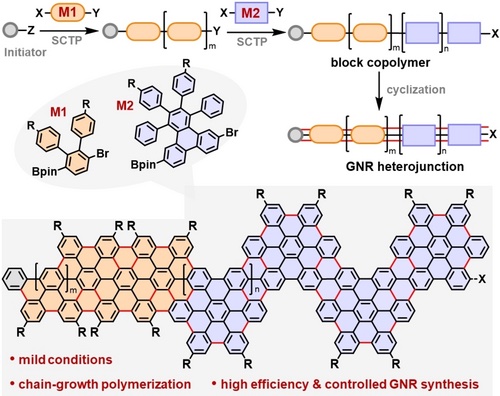 Graphene nanoribbons (GNRs) are considered promising candidates for next-generation nanoelectronics. In particular, GNR heterojunctions have received considerable attention due to their exotic topological electronic phases at the heterointerface. However, strategies for their precision synthesis remain at a nascent stage. Here, we report a novel chain-growth polymerization strategy that allows for constructing GNR heterojunction with N=9 armchair and chevron GNRs segments (9-AGNR/cGNR). The synthesis involves a controlled Suzuki–Miyaura catalyst-transfer polymerization (SCTP) between 2-(6′-bromo-4,4′′-ditetradecyl-[1,1′:2′,1′′-terphenyl]-3′-yl) boronic ester (M1) and 2-(7-bromo-9,12-diphenyl-10,11-bis(4-tetradecylphenyl)-triphenylene-2-yl) boronic ester (M2), followed by the Scholl reaction of the obtained block copolymer (poly-M1/M2) with controlled Mn (18 kDa) and narrow Đ (1.45). NMR and SEC analysis of poly-M1/M2 confirm the successful block copolymerization. The solution-mediated cyclodehydrogenation of poly-M1/M2 toward 9-AGNR/cGNR is unambiguously validated by FT-IR, Raman, and UV/Vis spectroscopies. Moreover, we also demonstrate the on-surface formation of pristine 9-AGNR/cGNR from the unsubstituted copolymer precursor, which is unambiguously characterized by scanning tunneling microscopy (STM).
Graphene nanoribbons (GNRs) are considered promising candidates for next-generation nanoelectronics. In particular, GNR heterojunctions have received considerable attention due to their exotic topological electronic phases at the heterointerface. However, strategies for their precision synthesis remain at a nascent stage. Here, we report a novel chain-growth polymerization strategy that allows for constructing GNR heterojunction with N=9 armchair and chevron GNRs segments (9-AGNR/cGNR). The synthesis involves a controlled Suzuki–Miyaura catalyst-transfer polymerization (SCTP) between 2-(6′-bromo-4,4′′-ditetradecyl-[1,1′:2′,1′′-terphenyl]-3′-yl) boronic ester (M1) and 2-(7-bromo-9,12-diphenyl-10,11-bis(4-tetradecylphenyl)-triphenylene-2-yl) boronic ester (M2), followed by the Scholl reaction of the obtained block copolymer (poly-M1/M2) with controlled Mn (18 kDa) and narrow Đ (1.45). NMR and SEC analysis of poly-M1/M2 confirm the successful block copolymerization. The solution-mediated cyclodehydrogenation of poly-M1/M2 toward 9-AGNR/cGNR is unambiguously validated by FT-IR, Raman, and UV/Vis spectroscopies. Moreover, we also demonstrate the on-surface formation of pristine 9-AGNR/cGNR from the unsubstituted copolymer precursor, which is unambiguously characterized by scanning tunneling microscopy (STM).
Charge-state lifetimes of single molecules on few monolayers of NaCl
K. Kaiser, L.-A. Lieske, J. Repp, L. Gross
Nat. Commun., 2023, 14, 4988. Link to article (open access).
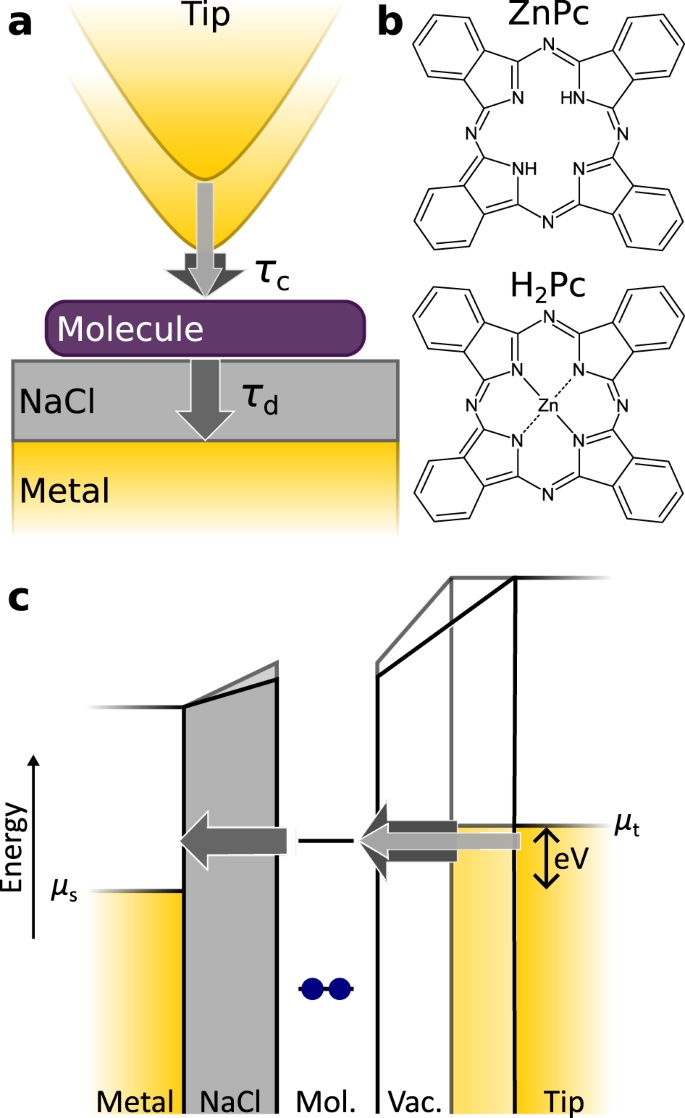 In molecular tunnel junctions, where the molecule is decoupled from the electrodes by few-monolayers-thin insulating layers, resonant charge transport takes place by sequential charge transfer to and from the molecule which implies transient charging of the molecule. The corresponding charge state transitions, which involve tunneling through the insulating decoupling layers, are crucial for understanding electrically driven processes such as electroluminescence or photocurrent generation in such a geometry. Here, we use scanning tunneling microscopy to investigate the decharging of single ZnPc and H2Pc molecules through NaCl films of 3 to 5 monolayers thickness on Cu(111) and Au(111). To this end, we approach the tip to the molecule at resonant tunnel conditions up to a regime where charge transport is limited by tunneling through the NaCl film. The resulting saturation of the tunnel current is a direct measure of the lifetimes of the anionic and cationic states, i.e., the molecule’s charge-state lifetime, and thus provides a means to study charge dynamics and, thereby, exciton dynamics. Comparison of anion and cation lifetimes on different substrates reveals the critical role of the level alignment with the insulator’s conduction and valence band, and the metal-insulator interface state.
In molecular tunnel junctions, where the molecule is decoupled from the electrodes by few-monolayers-thin insulating layers, resonant charge transport takes place by sequential charge transfer to and from the molecule which implies transient charging of the molecule. The corresponding charge state transitions, which involve tunneling through the insulating decoupling layers, are crucial for understanding electrically driven processes such as electroluminescence or photocurrent generation in such a geometry. Here, we use scanning tunneling microscopy to investigate the decharging of single ZnPc and H2Pc molecules through NaCl films of 3 to 5 monolayers thickness on Cu(111) and Au(111). To this end, we approach the tip to the molecule at resonant tunnel conditions up to a regime where charge transport is limited by tunneling through the NaCl film. The resulting saturation of the tunnel current is a direct measure of the lifetimes of the anionic and cationic states, i.e., the molecule’s charge-state lifetime, and thus provides a means to study charge dynamics and, thereby, exciton dynamics. Comparison of anion and cation lifetimes on different substrates reveals the critical role of the level alignment with the insulator’s conduction and valence band, and the metal-insulator interface state.
Room Temperature On-Surface Synthesis of a Vinylene-Linked Single Layer Covalent Organic Framework
F. G. Fabozzi, N. Severin, J. P. Rabe, S. Hecht
J. Am. Chem. Soc., 2023, 145, 18205–18209. Link to article.
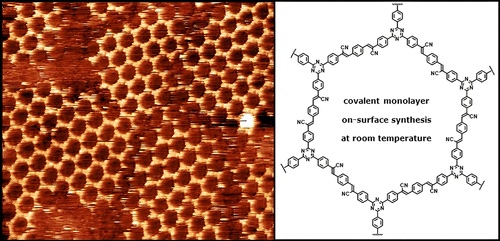 Conjugated single-layered two-dimensional covalent organic frameworks are flat and extended polymer networks with a unique combination of material properties, giving rise to potential applications in sensing, optoelectronics, and photonics. Despite their great potential, thus far only a few reactions to access such extended conjugated 2D polymers have been reported. Here, the on-surface polymerization of the first vinylene-linked single layered two-dimensional covalent organic framework using reversible Knoevenagel polycondensation under solvothermal conditions is described. Self-assembly of the two monomer building blocks at the solid−liquid interface led to the formation of extended covalent networks at room temperature without the need of additional catalysts or reagents. The described approach grants access to extended conjugated 2D polymers under unprecedentedly mild conditions and paves the way to new hybrid material systems.
Conjugated single-layered two-dimensional covalent organic frameworks are flat and extended polymer networks with a unique combination of material properties, giving rise to potential applications in sensing, optoelectronics, and photonics. Despite their great potential, thus far only a few reactions to access such extended conjugated 2D polymers have been reported. Here, the on-surface polymerization of the first vinylene-linked single layered two-dimensional covalent organic framework using reversible Knoevenagel polycondensation under solvothermal conditions is described. Self-assembly of the two monomer building blocks at the solid−liquid interface led to the formation of extended covalent networks at room temperature without the need of additional catalysts or reagents. The described approach grants access to extended conjugated 2D polymers under unprecedentedly mild conditions and paves the way to new hybrid material systems.
Curved graphene nanoribbons derived from tetrahydropyrene-based polyphenylenes via one-pot K-region oxidation and Scholl cyclization
S. Obermann, W. Zheng, J. Melidonie, S. Böckmann, S. Osella, N. Arisnabarreta, L. A. Guerrero-León, F. Hennersdorf, D. Beljonne, J. J. Weigand, M. Bonn, S. De Feyter, M. R. Hansen, H. I. Wang, J. Ma, X. Feng
Chem. Sci., 2023, 14, 8607–8614. Link to article (open access).
 Precise synthesis of graphene nanoribbons (GNRs) is of great interest to chemists and materials scientists because of their unique opto-electronic properties and potential applications in carbon-based nanoelectronics and spintronics. In addition to the tunable edge structure and width, introducing curvature in GNRs is a powerful structural feature for their chemi-physical property modification. Here, we report an efficient solution synthesis of the first pyrene-based GNR (PyGNR) with curved geometry via one-pot K-region oxidation and Scholl cyclization of its corresponding well-soluble tetrahydropyrene-based polyphenylene precursor. The efficient A2B2-type Suzuki polymerization and subsequent Scholl reaction furnishes up to ∼35 nm long curved GNRs bearing cove- and armchair-edges. The construction of model compound 1, as a cutout of PyGNR, from a tetrahydropyrene-based oligophenylene precursor proves the concept and efficiency of the one-pot K-region oxidation and Scholl cyclization, which is clearly revealed by single crystal X-ray diffraction analysis. The structure and optical properties of PyGNR are investigated by Raman, FT-IR, solid-state NMR, STM and UV-Vis analysis with the support of DFT calculations. PyGNR exhibits a narrow optical bandgap of ∼1.4 eV derived from a Tauc plot, qualifying as a low-bandgap GNR. Moreover, THz spectroscopy on PyGNR estimates its macroscopic charge mobility μ as ∼3.6 cm2 V−1 s−1, outperforming several other curved GNRs reported via conventional Scholl reaction.
Precise synthesis of graphene nanoribbons (GNRs) is of great interest to chemists and materials scientists because of their unique opto-electronic properties and potential applications in carbon-based nanoelectronics and spintronics. In addition to the tunable edge structure and width, introducing curvature in GNRs is a powerful structural feature for their chemi-physical property modification. Here, we report an efficient solution synthesis of the first pyrene-based GNR (PyGNR) with curved geometry via one-pot K-region oxidation and Scholl cyclization of its corresponding well-soluble tetrahydropyrene-based polyphenylene precursor. The efficient A2B2-type Suzuki polymerization and subsequent Scholl reaction furnishes up to ∼35 nm long curved GNRs bearing cove- and armchair-edges. The construction of model compound 1, as a cutout of PyGNR, from a tetrahydropyrene-based oligophenylene precursor proves the concept and efficiency of the one-pot K-region oxidation and Scholl cyclization, which is clearly revealed by single crystal X-ray diffraction analysis. The structure and optical properties of PyGNR are investigated by Raman, FT-IR, solid-state NMR, STM and UV-Vis analysis with the support of DFT calculations. PyGNR exhibits a narrow optical bandgap of ∼1.4 eV derived from a Tauc plot, qualifying as a low-bandgap GNR. Moreover, THz spectroscopy on PyGNR estimates its macroscopic charge mobility μ as ∼3.6 cm2 V−1 s−1, outperforming several other curved GNRs reported via conventional Scholl reaction.
Portraits of Soot Molecules Reveal Pathways to Large Aromatics, Five-/Seven-Membered Rings, and Inception through π-Radical Localization
L.-A. Lieske, M. Commodo, J. W. Martin, K. Kaiser, V. Benekou, P. Minutolo, A. D’Anna, L. Gross
ACS Nano, 2023, 17, 13563–13574. Link to article (open access).
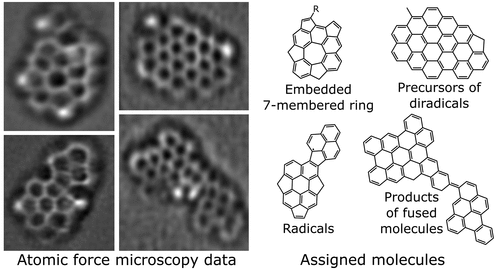 Incipient soot early in the flame was studied by high-resolution atomic force microscopy and scanning tunneling microscopy to resolve the atomic structure and orbital densities of single soot molecules prepared on bilayer NaCl on Cu(111). We resolved extended catacondensed and pentagonal-ring linked (pentalinked) species indicating how small aromatics cross-link and cyclodehydrogenate to form moderately sized aromatics. In addition, we resolved embedded pentagonal and heptagonal rings in flame aromatics. These nonhexagonal rings suggest simultaneous growth through aromatic cross-linking/cyclodehydrogenation and hydrogen abstraction acetylene addition. Moreover, we observed three classes of open-shell π-radical species. First, radicals with an unpaired π-electron delocalized along the molecule’s perimeter. Second, molecules with partially localized π-electrons at zigzag edges of a π-radical. Third, molecules with strong localization of a π-electron at pentagonal- and methylene-type sites. The third class consists of π-radicals localized enough to enable thermally stable bonds, as well as multiradical species such as diradicals in the open-shell triplet state. These π-diradicals can rapidly cluster through barrierless chain reactions enhanced by van der Waals interactions. These results improve our understanding of soot formation and the products formed by combustion and could provide insights for cleaner combustion and the production of hydrogen without CO2 emissions.
Incipient soot early in the flame was studied by high-resolution atomic force microscopy and scanning tunneling microscopy to resolve the atomic structure and orbital densities of single soot molecules prepared on bilayer NaCl on Cu(111). We resolved extended catacondensed and pentagonal-ring linked (pentalinked) species indicating how small aromatics cross-link and cyclodehydrogenate to form moderately sized aromatics. In addition, we resolved embedded pentagonal and heptagonal rings in flame aromatics. These nonhexagonal rings suggest simultaneous growth through aromatic cross-linking/cyclodehydrogenation and hydrogen abstraction acetylene addition. Moreover, we observed three classes of open-shell π-radical species. First, radicals with an unpaired π-electron delocalized along the molecule’s perimeter. Second, molecules with partially localized π-electrons at zigzag edges of a π-radical. Third, molecules with strong localization of a π-electron at pentagonal- and methylene-type sites. The third class consists of π-radicals localized enough to enable thermally stable bonds, as well as multiradical species such as diradicals in the open-shell triplet state. These π-diradicals can rapidly cluster through barrierless chain reactions enhanced by van der Waals interactions. These results improve our understanding of soot formation and the products formed by combustion and could provide insights for cleaner combustion and the production of hydrogen without CO2 emissions.
On the nucleation and fast reaction kinetics of 2D polymerisation with a 2-in-1 monomer
N. Herrmann, C. Martin, S. Eyley, Y. Li, N. Bilbao, V. Rubio-Giménez, M. Van der Auweraer, W. Thielemans, L. Chen, K. S. Mali, S. De Feyter
Chem. Commun., 2023, 59, 9211–9214. Link to article (open access).
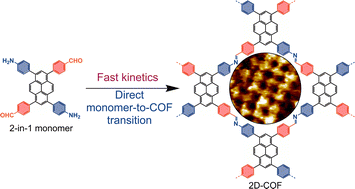 We report on the fast reaction kinetics of an imine based 2D polymer (2DP) formed from a single monomer carrying both aldehyde and amine groups. Our results point towards a direct monomer-to-crystalline polymer transition without an amorphous intermediate.
We report on the fast reaction kinetics of an imine based 2D polymer (2DP) formed from a single monomer carrying both aldehyde and amine groups. Our results point towards a direct monomer-to-crystalline polymer transition without an amorphous intermediate.
Structural Expansion of Cyclohepta[def]fluorene towards Azulene-Embedded Non-Benzenoid Nanographenes
F. Wu, A. Barragán, A. Gallardo, L. Yang, K. Biswas, D. Écija, J. I. Mendieta-Moreno, J. I. Urgel, J. Ma, X. Feng
Chem. Eur. J., 2023, 29, e202301739. Link to article (open access). Selected as a Very Important Paper. Featured in Maurizio Prato’s 70th Birthday, Society Volumes: Germany and Society Volumes: Spain.
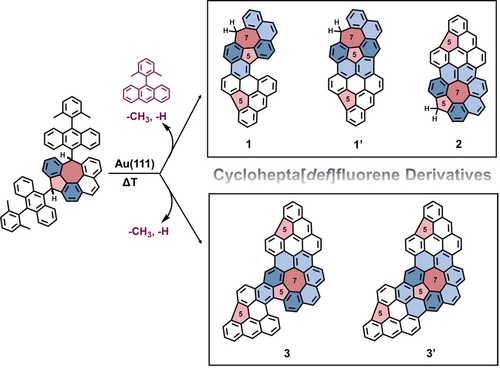 Non-benzenoid non-alternant nanographenes (NGs) have attracted increasing attention on account of their distinct electronic and structural features in comparison to their isomeric benzenoid counterparts. In this work, we present a series of unprecedented azulene-embedded NGs on Au(111) during the attempted synthesis of cyclohepta[def]fluorene-based high-spin non-Kekulé structure. Comprehensive scanning tunneling microscopy (STM) and non-contact atomic force microscopy (nc-AFM) evidence the structures and conformations of these unexpected products. The dynamics of the precursor bearing 9-(2,6-dimethylphenyl)anthracene and dihydro-dibenzo-cyclohepta[def]fluorene units and its reaction products on the surface are analyzed by density functional theory (DFT) and molecular dynamics (MD) simulations. Our study sheds light on the fundamental understanding of precursor design for the fabrication of π-extended non-benzenoid NGs on a metal surface.
Non-benzenoid non-alternant nanographenes (NGs) have attracted increasing attention on account of their distinct electronic and structural features in comparison to their isomeric benzenoid counterparts. In this work, we present a series of unprecedented azulene-embedded NGs on Au(111) during the attempted synthesis of cyclohepta[def]fluorene-based high-spin non-Kekulé structure. Comprehensive scanning tunneling microscopy (STM) and non-contact atomic force microscopy (nc-AFM) evidence the structures and conformations of these unexpected products. The dynamics of the precursor bearing 9-(2,6-dimethylphenyl)anthracene and dihydro-dibenzo-cyclohepta[def]fluorene units and its reaction products on the surface are analyzed by density functional theory (DFT) and molecular dynamics (MD) simulations. Our study sheds light on the fundamental understanding of precursor design for the fabrication of π-extended non-benzenoid NGs on a metal surface.
Bottom-up Solution Synthesis of Graphene Nanoribbons with Precisely Engineered Nanopores
W. Niu, Y. Fu, G. Serra, K. Liu, J. Droste, Y. Lee, Z. Ling, F. Xu, J. D. Cojal González, A. Lucotti, J. P. Rabe, M. R. Hansen, W. Pisula, P. W. M. Blom, C.-A. Palma, M. Tommasini, Y. Mai, J. Ma, X. Feng
Angew. Chem. Int. Ed., 2023, 62, e202305737. Link to article (open access). Selected as a Hot Paper. TUD and cfaed press releases.
 The incorporation of nanopores into graphene nanostructures has been demonstrated as an efficient tool in tuning their band gaps and electronic structures. However, precisely embedding the uniform nanopores into graphene nanoribbons (GNRs) at the atomic level remains underdeveloped especially for in-solution synthesis due to the lack of efficient synthetic strategies. Herein we report the first case of solution-synthesized porous GNR (pGNR) with a fully conjugated backbone via the efficient Scholl reaction of tailor-made polyphenylene precursor (P1) bearing pre-installed hexagonal nanopores. The resultant pGNR features periodic subnanometer pores with a uniform diameter of 0.6 nm and an adjacent-pores-distance of 1.7 nm. To solidify our design strategy, two porous model compounds (1 a, 1 b) containing the same pore size as the shortcuts of pGNR, are successfully synthesized. The chemical structure and photophysical properties of pGNR are investigated by various spectroscopic analyses. Notably, the embedded periodic nanopores largely reduce the π-conjugation degree and alleviate the inter-ribbon π–π interactions, compared to the nonporous GNRs with similar widths, affording pGNR with a notably enlarged band gap and enhanced liquid-phase processability.
The incorporation of nanopores into graphene nanostructures has been demonstrated as an efficient tool in tuning their band gaps and electronic structures. However, precisely embedding the uniform nanopores into graphene nanoribbons (GNRs) at the atomic level remains underdeveloped especially for in-solution synthesis due to the lack of efficient synthetic strategies. Herein we report the first case of solution-synthesized porous GNR (pGNR) with a fully conjugated backbone via the efficient Scholl reaction of tailor-made polyphenylene precursor (P1) bearing pre-installed hexagonal nanopores. The resultant pGNR features periodic subnanometer pores with a uniform diameter of 0.6 nm and an adjacent-pores-distance of 1.7 nm. To solidify our design strategy, two porous model compounds (1 a, 1 b) containing the same pore size as the shortcuts of pGNR, are successfully synthesized. The chemical structure and photophysical properties of pGNR are investigated by various spectroscopic analyses. Notably, the embedded periodic nanopores largely reduce the π-conjugation degree and alleviate the inter-ribbon π–π interactions, compared to the nonporous GNRs with similar widths, affording pGNR with a notably enlarged band gap and enhanced liquid-phase processability.
DFTBephy: A DFTB-based approach for electron–phonon coupling calculations
A. Croy, E. Unsal, R. Biele, A. Pecchia
J. Comput. Electron., 2023, 22, 1231–1239. Link to article (open access).
 The calculation of the electron–phonon coupling from first principles is computationally very challenging and remains mostly out of reach for systems with a large number of atoms. Semi-empirical methods, like density functional tight binding (DFTB), provide a framework for obtaining quantitative results at moderate computational costs. Herein, we present a new method based on the DFTB approach for computing electron–phonon couplings and relaxation times. It interfaces with phonopy for vibrational modes and dftb+ to calculate transport properties. We derive the electron–phonon coupling within a non-orthogonal tight-binding framework and apply them to graphene as a test case.
The calculation of the electron–phonon coupling from first principles is computationally very challenging and remains mostly out of reach for systems with a large number of atoms. Semi-empirical methods, like density functional tight binding (DFTB), provide a framework for obtaining quantitative results at moderate computational costs. Herein, we present a new method based on the DFTB approach for computing electron–phonon couplings and relaxation times. It interfaces with phonopy for vibrational modes and dftb+ to calculate transport properties. We derive the electron–phonon coupling within a non-orthogonal tight-binding framework and apply them to graphene as a test case.
The Role of Superadsorbent Polymers on Covalent Organic Frameworks-Based Solid Electrolytes: Investigation of the Ionic Conductivity and Relaxation
S. Gullace, L. Cusin, F. Richard, N. Israfilov, A. Ciesielski, P. Samorì
Adv. Mater. Interfaces, 2023, 10, 2300124. Link to article (open access).
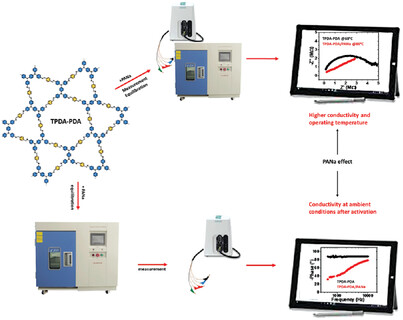
The scarcity of fossil fuels calls for immediate action toward the development of clean and renewable energy resources. In this context, proton exchange membrane fuel cells (PEMFCs) are gaining ever-increasing attention as clean technology. Although covalent organic frameworks (COFs) do not usually exhibit high intrinsic proton conductivity (σ), they have been recently proposed as solid polymer electrolytes in PEMFCs, thanks to their high crystallinity and stability to acids and bases. Here, a simple strategy is presented to improve the performance of poor COF-based proton conductors through addition of sodium polyacrylate (PANa) superadsorbent polymer. Electrochemical impedance spectroscopy investigations after activation at high temperature and relative humidity (RH) provide insights into the role of PANa, whose presence is key to preserve high σ at low RH. The humidity-dependent X-ray diffraction study reveals a strengthening of the stacking interaction along the COF (100) plane direction with increasing humidity, through the formation of H-bonding, thus promoting proton hopping. The study of the dielectric properties as a function of PANa content enables to determine a Debye relaxation regime for the COF/PANa blend with a maximum relaxation frequency of 1513 and 6606 Hz for the pristine COF and the COF/PANa blend, respectively, at their maximum operating temperatures.
Nanographene-Based Heterojunctions for High-Performance Organic Phototransistor Memory Devices
S. Bai, L. Yang, K. Haase, J. Wolansky, Z. Zhang, H. Tseng, F. Talnack, J. Kress, J. Perez Andrade, J. Benduhn, J. Ma, X. Feng, M. Hambsch, S. C. B. Mannsfeld
Adv. Sci., 2023, 10, 2300057. Link to article (open access).
 Organic phototransistors can enable many important applications such as nonvolatile memory, artificial synapses, and photodetectors in next-generation optical communication and wearable electronics. However, it is still a challenge to achieve a big memory window (threshold voltage response ∆Vth) for phototransistors. Here, a nanographene-based heterojunction phototransistor memory with large ∆Vth responses is reported. Exposure to low intensity light (25.7 µW cm−2) for 1 s yields a memory window of 35 V, and the threshold voltage shift is found to be larger than 140 V under continuous light illumination. The device exhibits both good photosensitivity (3.6 × 105) and memory properties including long retention time (>1.5 × 105 s), large hysteresis (45.35 V), and high endurance for voltage-erasing and light-programming. These findings demonstrate the high application potential of nanographenes in the field of optoelectronics. In addition, the working principle of these hybrid nanographene-organic structured heterojunction phototransistor memory devices is described which provides new insight into the design of high-performance organic phototransistor devices.
Organic phototransistors can enable many important applications such as nonvolatile memory, artificial synapses, and photodetectors in next-generation optical communication and wearable electronics. However, it is still a challenge to achieve a big memory window (threshold voltage response ∆Vth) for phototransistors. Here, a nanographene-based heterojunction phototransistor memory with large ∆Vth responses is reported. Exposure to low intensity light (25.7 µW cm−2) for 1 s yields a memory window of 35 V, and the threshold voltage shift is found to be larger than 140 V under continuous light illumination. The device exhibits both good photosensitivity (3.6 × 105) and memory properties including long retention time (>1.5 × 105 s), large hysteresis (45.35 V), and high endurance for voltage-erasing and light-programming. These findings demonstrate the high application potential of nanographenes in the field of optoelectronics. In addition, the working principle of these hybrid nanographene-organic structured heterojunction phototransistor memory devices is described which provides new insight into the design of high-performance organic phototransistor devices.
On-surface synthesis and edge states of NBN-doped zigzag graphene nanoribbons
X. Chang, L. Huang, Y. Gao, Y. Fu, J. Ma, H. Yang, J. Liu, X. Fu, X. Lin, X. Feng, S. Du, H.-J. Gao
Nano Res., 2023, 16, 10436–10442. Link to article and accepted manuscript (open access).
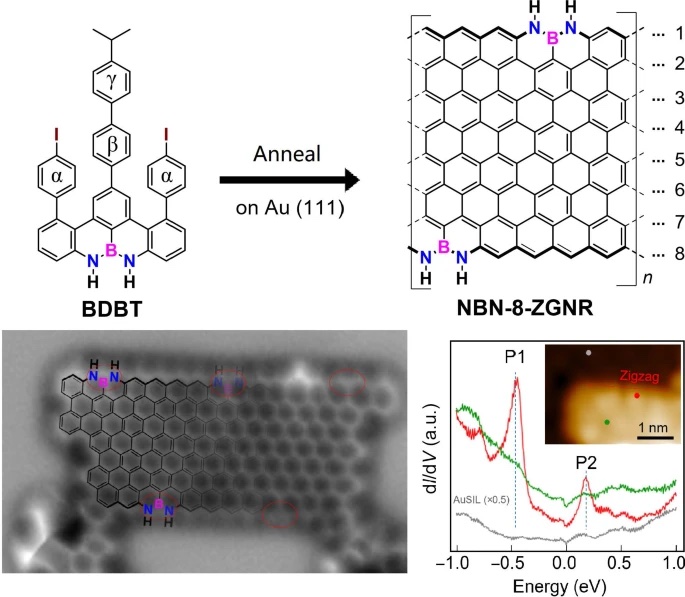 Zigzag graphene nanoribbons (ZGNRs) with spin-polarized edge states have potential applications in carbon-based spintronics. The electronic structure of ZGNRs can be effectively tuned by different widths or dopants, which requires delicately designed monomers. Here, we report the successful synthesis of ZGNR with a width of eight carbon zigzag lines and nitrogen-boron-nitrogen (NBN) motifs decorated along the zigzag edges (NBN-8-ZGNR) on Au (111) surface, which starts from a specially designed U-shaped monomer with preinstalled NBN units at the zigzag edge. Chemical-bond-resolved non-contact atomic force microscopy (nc-AFM) imaging confirms the zigzag-terminated edges and the existence of NBN dopants. The electronic states distributed along the zigzag edges have been revealed after a silicon-layer intercalation at the interface of NBN-8-ZGNR and Au (111). Our work enriches the ZGNR family with a new dopant and larger width, which provides more candidates for future carbon-based nanoelectronic and spintronic applications.
Zigzag graphene nanoribbons (ZGNRs) with spin-polarized edge states have potential applications in carbon-based spintronics. The electronic structure of ZGNRs can be effectively tuned by different widths or dopants, which requires delicately designed monomers. Here, we report the successful synthesis of ZGNR with a width of eight carbon zigzag lines and nitrogen-boron-nitrogen (NBN) motifs decorated along the zigzag edges (NBN-8-ZGNR) on Au (111) surface, which starts from a specially designed U-shaped monomer with preinstalled NBN units at the zigzag edge. Chemical-bond-resolved non-contact atomic force microscopy (nc-AFM) imaging confirms the zigzag-terminated edges and the existence of NBN dopants. The electronic states distributed along the zigzag edges have been revealed after a silicon-layer intercalation at the interface of NBN-8-ZGNR and Au (111). Our work enriches the ZGNR family with a new dopant and larger width, which provides more candidates for future carbon-based nanoelectronic and spintronic applications.
Observation of the Magnetic Ground State of the Two Smallest Triangular Nanographenes
E. Turco, A. Bernhardt, N. Krane, L. Valenta, R. Fasel, M. Juríček, P. Ruffieux
JACS Au, 2023, 3, 1358–1364. Link to article (open access). COVER PAGE.
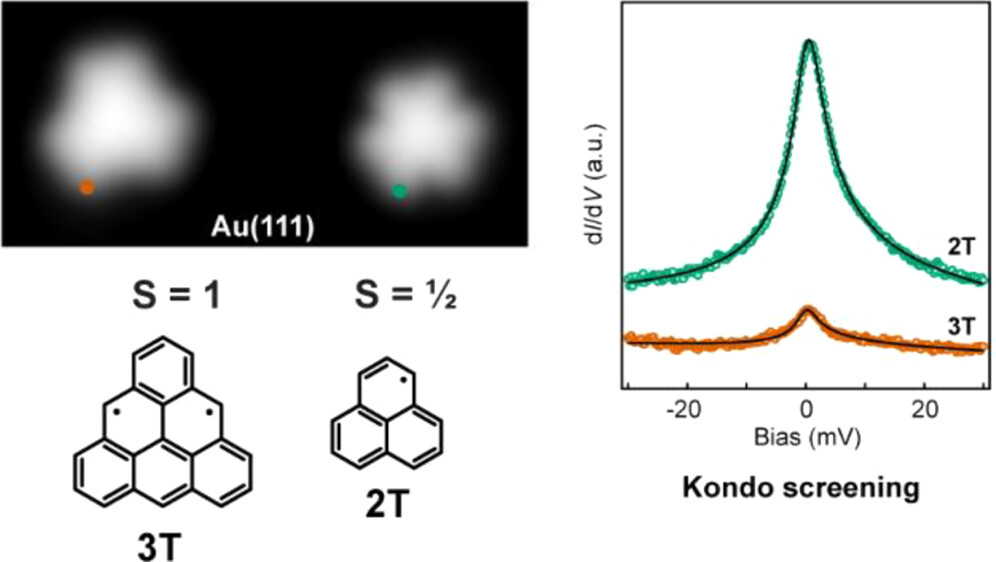 Fusion of three benzene rings in a triangular fashion gives rise to the smallest open-shell graphene fragment, the phenalenyl radical, whose π-extension leads to an entire family of non-Kekulé triangular nanographenes with high-spin ground states. Here, we report the first synthesis of unsubstituted phenalenyl on a Au(111) surface, which is achieved by combining in-solution synthesis of the hydro-precursor and on-surface activation by atomic manipulation, using the tip of a scanning tunneling microscope. Single-molecule structural and electronic characterizations confirm its open-shell S = 1/2 ground state that gives rise to Kondo screening on the Au(111) surface. In addition, we compare the phenalenyl’s electronic properties with those of triangulene, the second homologue in the series, whose S = 1 ground state induces an underscreened Kondo effect. Our results set a new lower size limit in the on-surface synthesis of magnetic nanographenes that can serve as building blocks for the realization of new exotic quantum phases of matter.
Fusion of three benzene rings in a triangular fashion gives rise to the smallest open-shell graphene fragment, the phenalenyl radical, whose π-extension leads to an entire family of non-Kekulé triangular nanographenes with high-spin ground states. Here, we report the first synthesis of unsubstituted phenalenyl on a Au(111) surface, which is achieved by combining in-solution synthesis of the hydro-precursor and on-surface activation by atomic manipulation, using the tip of a scanning tunneling microscope. Single-molecule structural and electronic characterizations confirm its open-shell S = 1/2 ground state that gives rise to Kondo screening on the Au(111) surface. In addition, we compare the phenalenyl’s electronic properties with those of triangulene, the second homologue in the series, whose S = 1 ground state induces an underscreened Kondo effect. Our results set a new lower size limit in the on-surface synthesis of magnetic nanographenes that can serve as building blocks for the realization of new exotic quantum phases of matter.
Modular Synthesis of Structurally Diverse Azulene-Embedded Polycyclic Aromatic Hydrocarbons by Knoevenagel-Type Condensation
R. Liu, Y. Fu, F. Wu, F. Liu, J.-J. Zhang, L. Yang, A. A. Popov, J. Ma, X. Feng
Angew. Chem. Int. Ed., 2023, 62, e202219091. Link to article (open access).
 The research interest in azulene-embedded polycyclic aromatic hydrocarbons (PAHs) has significantly increased recently, but the lack of efficient synthetic strategies impedes the investigation of their structure-property relationships and further opto-electronic applications. Here we report a modular synthetic strategy towards diverse azulene-embedded PAHs by a tandem Suzuki coupling and base-promoted Knoevenagel-type condensation with good yields and great structural versatility, including non-alternant thiophene-rich PAHs, butterfly- or Z-shaped PAHs bearing two azulene units, and the first example of a two-azulene-embedded double [5]helicene. The structural topology, aromaticity and photophysical properties were investigated by NMR, X-ray crystallography analysis and UV/Vis absorption spectroscopy assisted by DFT calculations. This strategy provides a new platform for rapidly synthesizing unexplored non-alternant PAHs or even graphene nanoribbons with multiple azulene units.
The research interest in azulene-embedded polycyclic aromatic hydrocarbons (PAHs) has significantly increased recently, but the lack of efficient synthetic strategies impedes the investigation of their structure-property relationships and further opto-electronic applications. Here we report a modular synthetic strategy towards diverse azulene-embedded PAHs by a tandem Suzuki coupling and base-promoted Knoevenagel-type condensation with good yields and great structural versatility, including non-alternant thiophene-rich PAHs, butterfly- or Z-shaped PAHs bearing two azulene units, and the first example of a two-azulene-embedded double [5]helicene. The structural topology, aromaticity and photophysical properties were investigated by NMR, X-ray crystallography analysis and UV/Vis absorption spectroscopy assisted by DFT calculations. This strategy provides a new platform for rapidly synthesizing unexplored non-alternant PAHs or even graphene nanoribbons with multiple azulene units.
A photo-responsive organic electrochemical transistor
N. Turetta, W. Danowski, L. Cusin, P. A. Livio, R. Hallani, I. McCulloch, P. Samorì
J. Mater. Chem. C, 2023, 11, 7982–7988. Link to article (open access). Selected as a Hot Paper.
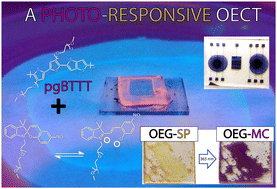 The design of novel organic electrochemical transistor (OECT) channel materials that can be controlled by a whole range of external stimuli is key towards the emergence of unprecedented technologies in bioelectronics. Like the established multiresponsive field-effect transistors, multiresponsive OECTs can in principle be realised via blending, by combining multiple components with each one imparting a specific function to the device. Here we report the first example of an optically switchable OECT which is capable of undergoing a reversible modulation of its ON current by up to 30% upon irradiation with UV and visible light. By investigating the electrical characteristics of the channel material, in conjunction with the electronic characterisation performed by a macroscopic Kelvin probe technique and photoemission yield spectroscopy in air, we gained distinct insight into the electrochemical doping process occurring within the blend upon light irradiation. Such a proof-of-concept work opens perspectives towards the implementation of complex neuromorphic operations and algorithms in OECTs.
The design of novel organic electrochemical transistor (OECT) channel materials that can be controlled by a whole range of external stimuli is key towards the emergence of unprecedented technologies in bioelectronics. Like the established multiresponsive field-effect transistors, multiresponsive OECTs can in principle be realised via blending, by combining multiple components with each one imparting a specific function to the device. Here we report the first example of an optically switchable OECT which is capable of undergoing a reversible modulation of its ON current by up to 30% upon irradiation with UV and visible light. By investigating the electrical characteristics of the channel material, in conjunction with the electronic characterisation performed by a macroscopic Kelvin probe technique and photoemission yield spectroscopy in air, we gained distinct insight into the electrochemical doping process occurring within the blend upon light irradiation. Such a proof-of-concept work opens perspectives towards the implementation of complex neuromorphic operations and algorithms in OECTs.
Photocatalytic degradation of methylene blue at nanostructured ZnO thin films
A. Kulis-Kapuscinska, M. Kwoka, M. A. Borysiewicz, T. Wojciechowski, N. Licciardello, M. Sgarzi, G. Cuniberti
Nanotechnology, 2023, 34, 155702. Link to article (open access).
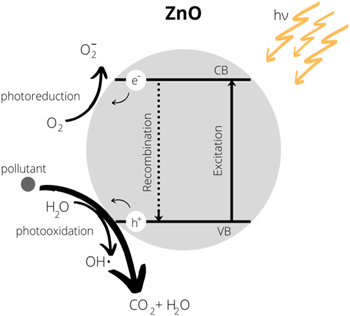 The photocatalytic degradation of the wastewater dye pollutant methylene blue (MB) at ZnO nanostructured porous thin films, deposited by direct current reactive magnetron sputtering on Si substrates, was studied. It was observed that over 4 photocatalytic cycles (0.3 mg · l−1 MB solution, 540 minUV irradiation), the rate constant k of MB degradation decreased by ∼50%, varying in the range (1.54 ÷ 0.78) · 10–9 (mol·l−1·min−1). For a deeper analysis of the photodegradation mechanism, detailed information on the nanostructured ZnO surface morphology and local surface and subsurface chemistry (nonstoichiometry) were obtained by using scanning electron microscopy (SEM) and x-ray photoelectron spectroscopy (XPS) as complementary analytical methods. The SEM studies revealed that at the surface of the nanostructured ZnO thin films a coral reef structure containing polycrystalline coral dendrites is present, and that, after the photocatalytic experiments, the sizes of individual crystallites increased, varying in the range 43 ÷ 76 nm for the longer axis, and in the range 28 ÷ 58 nm for the shorter axis. In turn, the XPS studies showed a slight non-stoichiometry, mainly defined by the relative [O]/[Zn] concentration of ca. 1.4, whereas [C]/[Zn] was ca. 1.2, both before and after the photocatalytic experiments. This phenomenon was directly related to the presence of superficial ZnO lattice oxygen atoms that can participate in the oxidation of the adsorbed MB molecules, as well as to the presence of surface hydroxyl groups acting as hole-acceptors to produce OH· radicals, which can be responsible for the generation of superoxide ions. In addition, after experiments, the XPS measurements revealed the presence of carboxyl and carbonyl functional groups, ascribable to the oxidation by-products formed during the photodegradation of MB.
The photocatalytic degradation of the wastewater dye pollutant methylene blue (MB) at ZnO nanostructured porous thin films, deposited by direct current reactive magnetron sputtering on Si substrates, was studied. It was observed that over 4 photocatalytic cycles (0.3 mg · l−1 MB solution, 540 minUV irradiation), the rate constant k of MB degradation decreased by ∼50%, varying in the range (1.54 ÷ 0.78) · 10–9 (mol·l−1·min−1). For a deeper analysis of the photodegradation mechanism, detailed information on the nanostructured ZnO surface morphology and local surface and subsurface chemistry (nonstoichiometry) were obtained by using scanning electron microscopy (SEM) and x-ray photoelectron spectroscopy (XPS) as complementary analytical methods. The SEM studies revealed that at the surface of the nanostructured ZnO thin films a coral reef structure containing polycrystalline coral dendrites is present, and that, after the photocatalytic experiments, the sizes of individual crystallites increased, varying in the range 43 ÷ 76 nm for the longer axis, and in the range 28 ÷ 58 nm for the shorter axis. In turn, the XPS studies showed a slight non-stoichiometry, mainly defined by the relative [O]/[Zn] concentration of ca. 1.4, whereas [C]/[Zn] was ca. 1.2, both before and after the photocatalytic experiments. This phenomenon was directly related to the presence of superficial ZnO lattice oxygen atoms that can participate in the oxidation of the adsorbed MB molecules, as well as to the presence of surface hydroxyl groups acting as hole-acceptors to produce OH· radicals, which can be responsible for the generation of superoxide ions. In addition, after experiments, the XPS measurements revealed the presence of carboxyl and carbonyl functional groups, ascribable to the oxidation by-products formed during the photodegradation of MB.
Supramolecular engineering of cathode materials for aqueous zinc-ion hybrid supercapacitors: novel thiophene-bridged donor–acceptor sp2 carbon-linked polymers
H. Peng, V. Montes-García, J. Raya, H. Wang, H. Guo, F. Richard, P. Samorì, A. Ciesielski
J. Mater. Chem. A, 2023, 11, 2718–2725. Link to article (open access). Selected as a Hot Paper.
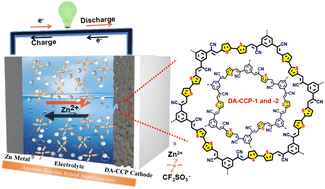 Rechargeable aqueous zinc-ion hybrid supercapacitors (Zn-HSCs) are promising candidates as large-scale energy storage devices owing to their high electrochemical performance, safety, long life, and low price. The development of nanostructured electrode materials featuring multiple active sites capable of interacting with Zn ions represents an efficient strategy to boost their electrochemical performance. In this work, we report for the first time the use of donor–acceptor carbon-linked conjugated polymers (DA-CCPs) as cathodes in aqueous Zn-HSCs. We have synthesized two novel DA-CCPs via Knoevenagel polymerization between electron-accepting 2,2′,2′′-(benzene-1,3,5-triyl)triacetonitrile and electron-donating 2,5-thiophene dicarboxaldehyde or [2,2′-bithiophene]-5,5′-dicarboxaldehyde, yielding DA-CCP-1 and DA-CCP-2, respectively. DA-CCP-2, which possesses an extra-thiophene unit in the backbone, exhibits improved electrochemical characteristics when compared to DA-CCP-1, and performance surpassing those of other reported cathode materials for aqueous Zn2+ energy storage systems. DA-CCP-1 and -2 based electrodes exhibited an outstanding energy density of 80.6 and 196.3 W h kg−1 respectively, representing the highest value ever reached for conjugated polymers to date. This study not only offers new perspectives for the rational design and precise synthesis of DA-CCPs but it also broadens the choice of cathodes for high-performance aqueous Zn-HSCs.
Rechargeable aqueous zinc-ion hybrid supercapacitors (Zn-HSCs) are promising candidates as large-scale energy storage devices owing to their high electrochemical performance, safety, long life, and low price. The development of nanostructured electrode materials featuring multiple active sites capable of interacting with Zn ions represents an efficient strategy to boost their electrochemical performance. In this work, we report for the first time the use of donor–acceptor carbon-linked conjugated polymers (DA-CCPs) as cathodes in aqueous Zn-HSCs. We have synthesized two novel DA-CCPs via Knoevenagel polymerization between electron-accepting 2,2′,2′′-(benzene-1,3,5-triyl)triacetonitrile and electron-donating 2,5-thiophene dicarboxaldehyde or [2,2′-bithiophene]-5,5′-dicarboxaldehyde, yielding DA-CCP-1 and DA-CCP-2, respectively. DA-CCP-2, which possesses an extra-thiophene unit in the backbone, exhibits improved electrochemical characteristics when compared to DA-CCP-1, and performance surpassing those of other reported cathode materials for aqueous Zn2+ energy storage systems. DA-CCP-1 and -2 based electrodes exhibited an outstanding energy density of 80.6 and 196.3 W h kg−1 respectively, representing the highest value ever reached for conjugated polymers to date. This study not only offers new perspectives for the rational design and precise synthesis of DA-CCPs but it also broadens the choice of cathodes for high-performance aqueous Zn-HSCs.
Unveiling Charge-Transport Mechanisms in Electronic Devices Based on Defect-Engineered MoS2 Covalent Networks
S. Ippolito, F. Urban, W. Zheng, O. Mazzarisi, C. Valentini, A. G. Kelly, S. M. Gali, M. Bonn, D. Beljonne, F. Corberi, J. N. Coleman, H. I. Wang, P. Samorì
Adv. Mater., 2023, 35, 2211157. Link to article (open access). COVER PAGE.
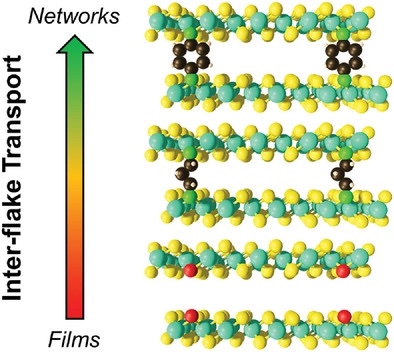 Device performance of solution-processed 2D semiconductors in printed electronics has been limited so far by structural defects and high interflake junction resistance. Covalently interconnected networks of transition metal dichalcogenides potentially represent an efficient strategy to overcome both limitations simultaneously. Yet, the charge-transport properties in such systems have not been systematically researched. Here, the charge-transport mechanisms of printed devices based on covalent MoS2 networks are unveiled via multiscale analysis, comparing the effects of aromatic versus aliphatic dithiolated linkers. Temperature-dependent electrical measurements reveal hopping as the dominant transport mechanism: aliphatic systems lead to 3D variable range hopping, unlike the nearest neighbor hopping observed for aromatic linkers. The novel analysis based on percolation theory attributes the superior performance of devices functionalized with π-conjugated molecules to the improved interflake electronic connectivity and formation of additional percolation paths, as further corroborated by density functional calculations. Valuable guidelines for harnessing the charge-transport properties in MoS2 devices based on covalent networks are provided.
Device performance of solution-processed 2D semiconductors in printed electronics has been limited so far by structural defects and high interflake junction resistance. Covalently interconnected networks of transition metal dichalcogenides potentially represent an efficient strategy to overcome both limitations simultaneously. Yet, the charge-transport properties in such systems have not been systematically researched. Here, the charge-transport mechanisms of printed devices based on covalent MoS2 networks are unveiled via multiscale analysis, comparing the effects of aromatic versus aliphatic dithiolated linkers. Temperature-dependent electrical measurements reveal hopping as the dominant transport mechanism: aliphatic systems lead to 3D variable range hopping, unlike the nearest neighbor hopping observed for aromatic linkers. The novel analysis based on percolation theory attributes the superior performance of devices functionalized with π-conjugated molecules to the improved interflake electronic connectivity and formation of additional percolation paths, as further corroborated by density functional calculations. Valuable guidelines for harnessing the charge-transport properties in MoS2 devices based on covalent networks are provided.
Supramolecular Engineering of Cathode Materials for Aqueous Zinc-ion Energy Storage Devices: Novel Benzothiadiazole Functionalized Two-Dimensional Olefin-Linked COFs
H. Peng, S. Huang, V. Montes-García, D. Pakulski, H. Guo, F. Richard, X. Zhuang, P. Samorì, A. Ciesielski
Angew. Chem. Int. Ed., 2023, 62, e202216136. Link to article (open access).
 Two-dimensional covalent organic frameworks (COFs) have emerged as promising materials for energy storage applications exhibiting enhanced electrochemical performance. While most of the reported organic cathode materials for zinc-ion batteries use carbonyl groups as electrochemically-active sites, their high hydrophilicity in aqueous electrolytes represents a critical drawback. Herein, we report a novel and structurally robust olefin-linked COF-TMT-BT synthesized via the aldol condensation between 2,4,6-trimethyl-1,3,5-triazine (TMT) and 4,4′-(benzothiadiazole-4,7-diyl)dibenzaldehyde (BT), where benzothiadiazole units are explored as novel electrochemically-active groups. Our COF-TMT-BT exhibits an outstanding Zn2+ storage capability, delivering a state-of-the-art capacity of 283.5 mAh g−1 at 0.1 A g−1. Computational and experimental analyses reveal that the charge-storage mechanism in COF-TMT-BT electrodes is based on the supramolecularly engineered and reversible Zn2+ coordination by the benzothiadiazole units.
Two-dimensional covalent organic frameworks (COFs) have emerged as promising materials for energy storage applications exhibiting enhanced electrochemical performance. While most of the reported organic cathode materials for zinc-ion batteries use carbonyl groups as electrochemically-active sites, their high hydrophilicity in aqueous electrolytes represents a critical drawback. Herein, we report a novel and structurally robust olefin-linked COF-TMT-BT synthesized via the aldol condensation between 2,4,6-trimethyl-1,3,5-triazine (TMT) and 4,4′-(benzothiadiazole-4,7-diyl)dibenzaldehyde (BT), where benzothiadiazole units are explored as novel electrochemically-active groups. Our COF-TMT-BT exhibits an outstanding Zn2+ storage capability, delivering a state-of-the-art capacity of 283.5 mAh g−1 at 0.1 A g−1. Computational and experimental analyses reveal that the charge-storage mechanism in COF-TMT-BT electrodes is based on the supramolecularly engineered and reversible Zn2+ coordination by the benzothiadiazole units.
Helical Bilayer Nonbenzenoid Nanographene Bearing a [10]Helicene with Two Embedded Heptagons
L. Yang, Y.-Y. Ju, M. A. Medel, Y. Fu, H. Komber, E. Dmitrieva, J.-J. Zhang, S. Obermann, A. G. Campaña, J. Ma, X. Feng
Angew. Chem. Int. Ed., 2023, 62, e202216193. Link to article (open access).
 The precision synthesis of helical bilayer nanographenes (NGs) with new topology is of substantial interest because of their exotic physicochemical properties. However, helical bilayer NGs bearing non-hexagonal rings remain synthetically challenging. Here we present the efficient synthesis of the first helical bilayer nonbenzenoid nanographene (HBNG1) from a tailor-made azulene-embedded precursor, which contains a novel [10]helicene backbone with two embedded heptagons. Single-crystal X-ray analysis reveals its highly twisted bilayer geometry with a record small interlayer distance of 3.2 Å among the reported helical bilayer NGs. Notably, the close interlayer distance between the two layers offers intramolecular through-space conjugation as revealed by in situ spectroelectrochemistry studies together with DFT simulations. Furthermore, the chiroptical properties of the P/M enantiomers of HBNG1 are also evaluated by circular dichroism and circularly polarized luminescence.
The precision synthesis of helical bilayer nanographenes (NGs) with new topology is of substantial interest because of their exotic physicochemical properties. However, helical bilayer NGs bearing non-hexagonal rings remain synthetically challenging. Here we present the efficient synthesis of the first helical bilayer nonbenzenoid nanographene (HBNG1) from a tailor-made azulene-embedded precursor, which contains a novel [10]helicene backbone with two embedded heptagons. Single-crystal X-ray analysis reveals its highly twisted bilayer geometry with a record small interlayer distance of 3.2 Å among the reported helical bilayer NGs. Notably, the close interlayer distance between the two layers offers intramolecular through-space conjugation as revealed by in situ spectroelectrochemistry studies together with DFT simulations. Furthermore, the chiroptical properties of the P/M enantiomers of HBNG1 are also evaluated by circular dichroism and circularly polarized luminescence.
Indium Selenide/Indium Tin Oxide Hybrid Films for Solution-Processed Photoelectrochemical-Type Photodetectors in Aqueous Media
G. Bianca, M. I. Zappia, S. Bellani, M. Ghini, N. Curreli, J. Buha, V. Galli, M. Prato, A. Soll, Z. Sofer, G. Lanzani, I. Kriegel, F. Bonaccorso
Adv. Mater. Interfaces, 2023, 10, 2201635. Link to article (open access).
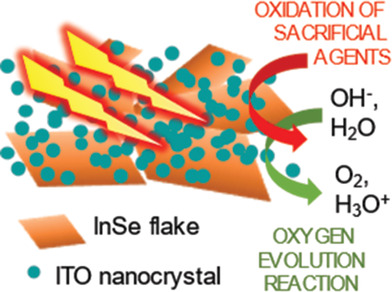 2D metal monochalcogenides have recently attracted interest for photoelectrochemical (PEC) applications in aqueous electrolytes. Their optical bandgap in the visible and near-infrared spectral region is adequate for energy conversion and photodetection/sensing. Their large surface-to-volume ratio guarantees that the charge carriers are photogenerated at the material/electrolyte interface, where redox reactions occur, minimizing recombination processes. However, solution-processed photoelectrodes based on these materials exhibit energy conversion efficiencies that are far from the current state of the art expressed by established technologies. This work reports a systematic morphological, spectroscopic, and PEC characterization of solution-processed films of photoactive InSe flakes for PEC-type photodetectors. By optimizing the thickness and hybridizing InSe flakes with electrically conductive Sn:In2O3 (ITO) nanocrystals, photoanodes with a significant photoanodic response in both acidic and alkaline media are designed, reaching responsivity up to 60.0 mA W−1 (external quantum efficiency = 16.4%) at +0.4 V versus RHE under visible illumination. In addition, a strategy based on the use of sacrificial agents (i.e., 2-propanol and Na2SO3) is proposed to improve the stability of the InSe and ITO/InSe photodetectors. Our data confirm the potential of 2D InSe for PEC energy conversion and sensing applications, remarking the challenges related to InSe stability during anodic operation.
2D metal monochalcogenides have recently attracted interest for photoelectrochemical (PEC) applications in aqueous electrolytes. Their optical bandgap in the visible and near-infrared spectral region is adequate for energy conversion and photodetection/sensing. Their large surface-to-volume ratio guarantees that the charge carriers are photogenerated at the material/electrolyte interface, where redox reactions occur, minimizing recombination processes. However, solution-processed photoelectrodes based on these materials exhibit energy conversion efficiencies that are far from the current state of the art expressed by established technologies. This work reports a systematic morphological, spectroscopic, and PEC characterization of solution-processed films of photoactive InSe flakes for PEC-type photodetectors. By optimizing the thickness and hybridizing InSe flakes with electrically conductive Sn:In2O3 (ITO) nanocrystals, photoanodes with a significant photoanodic response in both acidic and alkaline media are designed, reaching responsivity up to 60.0 mA W−1 (external quantum efficiency = 16.4%) at +0.4 V versus RHE under visible illumination. In addition, a strategy based on the use of sacrificial agents (i.e., 2-propanol and Na2SO3) is proposed to improve the stability of the InSe and ITO/InSe photodetectors. Our data confirm the potential of 2D InSe for PEC energy conversion and sensing applications, remarking the challenges related to InSe stability during anodic operation.
Precise tuning of interlayer electronic coupling in layered conductive metal-organic frameworks
Y. Lu, Y. Zhang, C.-Y. Yang, S. Revuelta, H. Qi, C. Huang, W. Jin, Z. Li, V. Vega-Mayoral, Y. Liu, X. Huang, D. Pohl, M. Položij, S. Zhou, E. Cánovas, T. Heine, S. Fabiano, X. Feng, R. Dong
Nat. Commun., 2022, 13, 7240. Link to article (open access). TUD and cfaed press releases.
 Two-dimensional conjugated metal-organic frameworks (2D c-MOFs) have attracted increasing interests for (opto)-electronics and spintronics. They generally consist of van der Waals stacked layers and exhibit layer-depended electronic properties. While considerable efforts have been made to regulate the charge transport within a layer, precise control of electronic coupling between layers has not yet been achieved. Herein, we report a strategy to precisely tune interlayer charge transport in 2D c-MOFs via side-chain induced control of the layer spacing. We design hexaiminotriindole ligands allowing programmed functionalization with tailored alkyl chains (HATI_CX, X = 1,3,4; X refers to the carbon numbers of the alkyl chains) for the synthesis of semiconducting Ni3(HATI_CX)2. The layer spacing of these MOFs can be precisely varied from 3.40 to 3.70 Å, leading to widened band gap, suppressed carrier mobilities, and significant improvement of the Seebeck coefficient. With this demonstration, we further achieve a record-high thermoelectric power factor of 68 ± 3 nW m−1 K−2 in Ni3(HATI_C3)2, superior to the reported holes-dominated MOFs.
Two-dimensional conjugated metal-organic frameworks (2D c-MOFs) have attracted increasing interests for (opto)-electronics and spintronics. They generally consist of van der Waals stacked layers and exhibit layer-depended electronic properties. While considerable efforts have been made to regulate the charge transport within a layer, precise control of electronic coupling between layers has not yet been achieved. Herein, we report a strategy to precisely tune interlayer charge transport in 2D c-MOFs via side-chain induced control of the layer spacing. We design hexaiminotriindole ligands allowing programmed functionalization with tailored alkyl chains (HATI_CX, X = 1,3,4; X refers to the carbon numbers of the alkyl chains) for the synthesis of semiconducting Ni3(HATI_CX)2. The layer spacing of these MOFs can be precisely varied from 3.40 to 3.70 Å, leading to widened band gap, suppressed carrier mobilities, and significant improvement of the Seebeck coefficient. With this demonstration, we further achieve a record-high thermoelectric power factor of 68 ± 3 nW m−1 K−2 in Ni3(HATI_C3)2, superior to the reported holes-dominated MOFs.
High-energy density aqueous supercapacitors: The role of electrolyte pH and KI redox additive
M. Eredia, S. Bellani, M. I. Zappia, L. Gabatel, V. Galli, A. Bagheri, H. Beydaghi, G. Bianca, I. Conticello, V. Pellegrini, F. Bonaccorso
APL Mater., 2022, 10, 101102. Link to article (open access). Selected as an Editor’s Pick. Featured in Special Topic: Materials Challenges for Supercapacitors.
 Supercapacitors (SCs), including the most established electrochemical double layer capacitors (EDLCs), are energy storage systems that can be charged in the second timescale, while sustaining a great number of re-charge cycles without losing efficiency. Undoubtedly, their major drawback is their insufficient energy density compared to batteries. Meanwhile, the reduction of the SC costs using cheap and sustainable electrolytes is also a trivial criterion to be considered in the competition race of the energy storage technologies. In this work, we report an extended characterization of aqueous SCs, screening acidic, neutral and alkaline electrolytes, as well as the addition of KI as a prototypical redox additive, and performing both two- and three-electrode configuration measurements. By using near-neutral electrolytes, our aqueous EDLCs can reach a maximum cell voltage superior to 2 V, enabling energy densities higher than 18 W h kg−1 (comparable or approaching those of lead acid and Ni–Cd batteries) at a power density up to almost 7 kW kg−1 (significantly superior to those of competing battery technologies). The introduction of redox additives can significantly increase the capacity of the SCs. However, compared to EDLCs, both the cell voltage and the energy efficiency of the SCs decrease because of partially irreversible faradaic redox reactions and overpotentials of kinetically limited redox reactions. While debunking the myth that aqueous SCs exhibit low energy density, our study also remarks the importance of adequately assessing aqueous SCs, showing the current challenges of advanced SC architectures alternative to EDLCs.
Supercapacitors (SCs), including the most established electrochemical double layer capacitors (EDLCs), are energy storage systems that can be charged in the second timescale, while sustaining a great number of re-charge cycles without losing efficiency. Undoubtedly, their major drawback is their insufficient energy density compared to batteries. Meanwhile, the reduction of the SC costs using cheap and sustainable electrolytes is also a trivial criterion to be considered in the competition race of the energy storage technologies. In this work, we report an extended characterization of aqueous SCs, screening acidic, neutral and alkaline electrolytes, as well as the addition of KI as a prototypical redox additive, and performing both two- and three-electrode configuration measurements. By using near-neutral electrolytes, our aqueous EDLCs can reach a maximum cell voltage superior to 2 V, enabling energy densities higher than 18 W h kg−1 (comparable or approaching those of lead acid and Ni–Cd batteries) at a power density up to almost 7 kW kg−1 (significantly superior to those of competing battery technologies). The introduction of redox additives can significantly increase the capacity of the SCs. However, compared to EDLCs, both the cell voltage and the energy efficiency of the SCs decrease because of partially irreversible faradaic redox reactions and overpotentials of kinetically limited redox reactions. While debunking the myth that aqueous SCs exhibit low energy density, our study also remarks the importance of adequately assessing aqueous SCs, showing the current challenges of advanced SC architectures alternative to EDLCs.
Functionalized Metallic 2D Transition Metal Dichalcogenide-Based Solid-State Electrolyte for Flexible All-Solid-State Supercapacitors
A. Bagheri, S. Bellani, H. Beydaghi, M. Eredia, L. Najafi, G. Bianca, M. I. Zappia, M. Safarpour, M. Najafi, E. Mantero, Z. Sofer, G. Hou, V. Pellegrini, X. Feng, F. Bonaccorso
ACS Nano, 2022, 16, 16426–16442. Link to article (open access).
 Highly efficient and durable flexible solid-state supercapacitors (FSSSCs) are emerging as low-cost devices for portable and wearable electronics due to the elimination of leakage of toxic/corrosive liquid electrolytes and their capability to withstand elevated mechanical stresses. Nevertheless, the spread of FSSSCs requires the development of durable and highly conductive solid-state electrolytes, whose electrochemical characteristics must be competitive with those of traditional liquid electrolytes. Here, we propose an innovative composite solid-state electrolyte prepared by incorporating metallic two-dimensional group-5 transition metal dichalcogenides, namely, liquid-phase exfoliated functionalized niobium disulfide (f-NbS2) nanoflakes, into a sulfonated poly(ether ether ketone) (SPEEK) polymeric matrix. The terminal sulfonate groups in f-NbS2 nanoflakes interact with the sulfonic acid groups of SPEEK by forming a robust hydrogen bonding network. Consequently, the composite solid-state electrolyte is mechanically/dimensionally stable even at a degree of sulfonation of SPEEK as high as 70.2%. At this degree of sulfonation, the mechanical strength is 38.3 MPa, and thanks to an efficient proton transport through the Grotthuss mechanism, the proton conductivity is as high as 94.4 mS cm–1 at room temperature. To elucidate the importance of the interaction between the electrode materials (including active materials and binders) and the solid-state electrolyte, solid-state supercapacitors were produced using SPEEK and poly(vinylidene fluoride) as proton conducting and nonconducting binders, respectively. The use of our solid-state electrolyte in combination with proton-conducting SPEEK binder and carbonaceous electrode materials (mixture of activated carbon, single/few-layer graphene, and carbon black) results in a solid-state supercapacitor with a specific capacitance of 116 F g–1 at 0.02 A g–1, optimal rate capability (76 F g–1 at 10 A g–1), and electrochemical stability during galvanostatic charge/discharge cycling and folding/bending stresses.
Highly efficient and durable flexible solid-state supercapacitors (FSSSCs) are emerging as low-cost devices for portable and wearable electronics due to the elimination of leakage of toxic/corrosive liquid electrolytes and their capability to withstand elevated mechanical stresses. Nevertheless, the spread of FSSSCs requires the development of durable and highly conductive solid-state electrolytes, whose electrochemical characteristics must be competitive with those of traditional liquid electrolytes. Here, we propose an innovative composite solid-state electrolyte prepared by incorporating metallic two-dimensional group-5 transition metal dichalcogenides, namely, liquid-phase exfoliated functionalized niobium disulfide (f-NbS2) nanoflakes, into a sulfonated poly(ether ether ketone) (SPEEK) polymeric matrix. The terminal sulfonate groups in f-NbS2 nanoflakes interact with the sulfonic acid groups of SPEEK by forming a robust hydrogen bonding network. Consequently, the composite solid-state electrolyte is mechanically/dimensionally stable even at a degree of sulfonation of SPEEK as high as 70.2%. At this degree of sulfonation, the mechanical strength is 38.3 MPa, and thanks to an efficient proton transport through the Grotthuss mechanism, the proton conductivity is as high as 94.4 mS cm–1 at room temperature. To elucidate the importance of the interaction between the electrode materials (including active materials and binders) and the solid-state electrolyte, solid-state supercapacitors were produced using SPEEK and poly(vinylidene fluoride) as proton conducting and nonconducting binders, respectively. The use of our solid-state electrolyte in combination with proton-conducting SPEEK binder and carbonaceous electrode materials (mixture of activated carbon, single/few-layer graphene, and carbon black) results in a solid-state supercapacitor with a specific capacitance of 116 F g–1 at 0.02 A g–1, optimal rate capability (76 F g–1 at 10 A g–1), and electrochemical stability during galvanostatic charge/discharge cycling and folding/bending stresses.
Vinylene-Linked 2D Conjugated Covalent Organic Frameworks by Wittig Reactions
Y. Liu, S. Fu, D. L. Pastoetter, A. H. Khan, Y. Zhang, A. Dianat, S. Xu, Z. Liao, M. Richter, M. Yu, M. Položij, E. Brunner, G. Cuniberti, T. Heine, M. Bonn, H. I. Wang, X. Feng
Angew. Chem. Int. Ed., 2022, 61, e202209762. Link to article (open access).
 Vinylene-linked two-dimensional covalent organic frameworks (V-2D-COFs) have shown great promise in electronics and optoelectronics. However, only a few reactions for V-2D-COFs have been developed hitherto. Besides the kinetically low reversibility of C=C bond formation, another underlying issue facing the synthesis of V-2D-COFs is the attainment of high (E)-alkene selectivity to ensure the appropriate symmetry of 2D frameworks. Here, we tailor the E/Z selectivity of the Wittig reaction by employing a proper catalyst (i.e., Cs2CO3) to obtain more stable intermediates and elevating the temperature across the reaction barrier. Subsequently, the Wittig reaction is innovatively utilized for the synthesis of four crystalline V-2D-COFs by combining aldehydes and ylides. Importantly, the efficient conjugation and decent crystallinity of the resultant V-2D-COFs are demonstrated by their high charge carrier mobilities over 10 cm2 V−1 s−1, as revealed by non-contact terahertz (THz) spectroscopy.
Vinylene-linked two-dimensional covalent organic frameworks (V-2D-COFs) have shown great promise in electronics and optoelectronics. However, only a few reactions for V-2D-COFs have been developed hitherto. Besides the kinetically low reversibility of C=C bond formation, another underlying issue facing the synthesis of V-2D-COFs is the attainment of high (E)-alkene selectivity to ensure the appropriate symmetry of 2D frameworks. Here, we tailor the E/Z selectivity of the Wittig reaction by employing a proper catalyst (i.e., Cs2CO3) to obtain more stable intermediates and elevating the temperature across the reaction barrier. Subsequently, the Wittig reaction is innovatively utilized for the synthesis of four crystalline V-2D-COFs by combining aldehydes and ylides. Importantly, the efficient conjugation and decent crystallinity of the resultant V-2D-COFs are demonstrated by their high charge carrier mobilities over 10 cm2 V−1 s−1, as revealed by non-contact terahertz (THz) spectroscopy.
Carbon-α-Fe2O3 Composite Active Material for High-Capacity Electrodes with High Mass Loading and Flat Current Collector for Quasi-Symmetric Supercapacitors
M. Najafi, S. Bellani, V. Galli, M. I. Zappia, A. Bagheri, M. Safarpour, H. Beydaghi, M. Eredia, L. Pasquale, R. Carzino, S. Lauciello, J.-K. Panda, R. Brescia, L. Gabatel, V. Pellegrini, F. Bonaccorso
Electrochem, 2022, 3, 463–478. Link to article (open access). Featured in Topical Collection “Feature Papers in Electrochemistry”.
 In this work, we report the synthesis of an active material for supercapacitors (SCs), namely α-Fe2O3/carbon composite (C-Fe2O3) made of elongated nanoparticles linearly connected into a worm-like morphology, by means of electrospinning followed by a calcination/carbonization process. The resulting active material powder can be directly processed in the form of slurry to produce SC electrodes with mass loadings higher than 1 mg cm−2 on practical flat current collectors, avoiding the need for bulky porous substrate, as often reported in the literature. In aqueous electrolyte (6 M KOH), the so-produced C-Fe2O3 electrodes display capacity as high as ~140 mAh g−1 at a scan rate of 2 mV s−1, while showing an optimal rate capability (capacity of 32.4 mAh g−1 at a scan rate of 400 mV s−1). Thanks to their poor catalytic activity towards water splitting reactions, the electrode can operate in a wide potential range (−1.6 V–0.3 V vs. Hg/HgO), enabling the realization of performant quasi-symmetric SCs based on electrodes with the same chemical composition (but different active material mass loadings), achieving energy density approaching 10 Wh kg−1 in aqueous electrolytes.
In this work, we report the synthesis of an active material for supercapacitors (SCs), namely α-Fe2O3/carbon composite (C-Fe2O3) made of elongated nanoparticles linearly connected into a worm-like morphology, by means of electrospinning followed by a calcination/carbonization process. The resulting active material powder can be directly processed in the form of slurry to produce SC electrodes with mass loadings higher than 1 mg cm−2 on practical flat current collectors, avoiding the need for bulky porous substrate, as often reported in the literature. In aqueous electrolyte (6 M KOH), the so-produced C-Fe2O3 electrodes display capacity as high as ~140 mAh g−1 at a scan rate of 2 mV s−1, while showing an optimal rate capability (capacity of 32.4 mAh g−1 at a scan rate of 400 mV s−1). Thanks to their poor catalytic activity towards water splitting reactions, the electrode can operate in a wide potential range (−1.6 V–0.3 V vs. Hg/HgO), enabling the realization of performant quasi-symmetric SCs based on electrodes with the same chemical composition (but different active material mass loadings), achieving energy density approaching 10 Wh kg−1 in aqueous electrolytes.
MoS2 Defect Healing for High-Performance Chemical Sensing of Polycyclic Aromatic Hydrocarbons
F. J. Urbanos, S. Gullace, P. Samorì
ACS Nano, 2022, 16, 11234–11243. Link to article and accepted manuscript (open access).
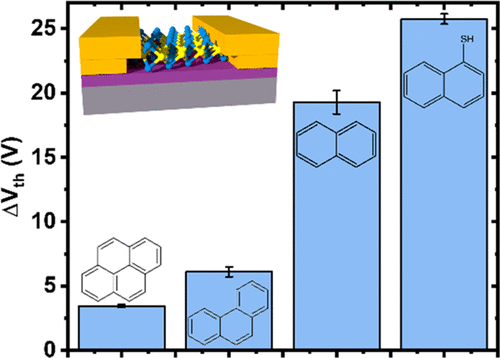
The increasing population and industrial development are responsible for environmental pollution. Among toxic chemicals, polycyclic aromatic hydrocarbons (PAHs) are highly carcinogenic contaminants resulting from the incomplete combustion of organic materials. Two-dimensional materials, such as transition metal dichalcogenides (TMDCs), are ideal sensory scaffolds, combining high surface-to-volume ratio with physical and chemical properties that are strongly susceptible to environmental changes. TMDCs can be integrated in field-effect transistors (FETs), which can operate as high-performance chemical detectors of (non)covalent interaction with small molecules. Here, we have developed MoS2-based FETs as platforms for PAHs sensing, relying on the affinity of the planar polyaromatic molecules for the basal plane of MoS2 and the structural defects in its lattice. X-ray photoelectron spectroscopy analysis, photoluminescence measurements, and transfer characteristics showed a notable reduction in the defectiveness of MoS2 and a p-type doping upon exposure to PAHs solutions, with a magnitude determined by the correlation between the ionization energies (EI) of the PAH and that of MoS2. Naphthalene, endowed with the higher EI among the studied PAHs, exhibited the highest output. We observed a log–log correlation between MoS2 doping and naphthalene concentration in water in a wide range (10–9–10–6 M), as well as a reversible response to the analyte. Naphthalene concentrations as low as 0.128 ppb were detected, being below the limits imposed by health regulations for drinking water. Furthermore, our MoS2 devices can reversibly detect vapors of naphthalene with both an electrical and optical readout, confirming that our architecture could operate as a dual sensing platform.
In-Plane Oriented Two-Dimensional Conjugated Metal–Organic Framework Films for High-Performance Humidity Sensing
S. Park, Z. Zhang, H. Qi, B. Liang, J. Mahmood, H.-J. Noh, M. Hambsch, M. Wang, M. Wang, K. H. Ly, Z. Wang, I. M. Weidinger, S. Zhou, J.-B. Baek, U. Kaiser, S. C. B. Mannsfeld, X. Feng, R. Dong
ACS Materials Lett., 2022, 4, 1146–1153. Link to article.
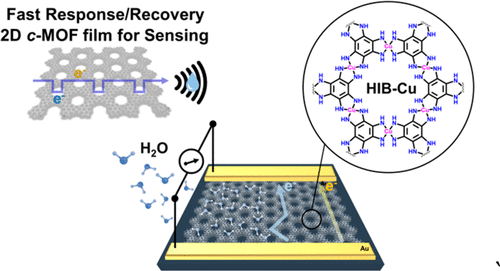
Two-dimensional conjugated metal–organic frameworks (2D c-MOFs) have emerged as a new generation of conducting MOFs for electronics. However, controlled synthesis of thin-film samples with high crystallinity and defined layer orientation, which is beneficial for achieving high-performance devices and reliable structure–property relationship, has remained a challenge. Here, we develop a surfactant-directed two-step synthesis of layered 2D c-MOF films based on benzene and triphenylene ligands linked by copper-bis(diimino) complexes (HIB-Cu and HITP-Cu, respectively). The achieved layered 2D c-MOF films are featured as free-standing, in-plane oriented, and polycrystalline films with domain size up to ∼8000 nm2 and a tunable thickness in the range of 8–340 nm. Benefiting from the intrinsic electrical conductivity and quasi-one-dimensional pore channels, a HIB-Cu film based chemiresistive sensor is constructed, displaying effective humidity sensing with a response as fast as ∼21 s, superior to the reported MOF-powder-based chemiresistive sensors (in the orders of minutes).
Novel thiophene-based donor–acceptor scaffolds as cathodes for rechargeable aqueous zinc-ion hybrid supercapacitors
H. Peng, Y. Zheng, C. Antheaume, P. Samorì, A. Ciesielski
Chem. Commun., 2022, 58, 6689–6692. Link to article (open access).
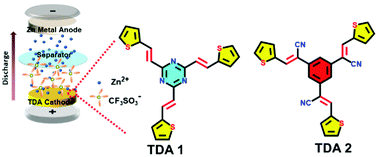
Well-defined π-conjugated thiophene donor–acceptor molecules play an important role in different fields ranging from synthetic chemistry to materials science. Their chemical structure provides specific electronic and physicochemical properties, which can be further tuned by the introduction of functional groups. Herein, we design and synthesize two novel thiophene-based π-conjugated donor–acceptor molecules TDA-1 and TDA-2 through Aldol and Knoevenagel condensations. In our proof-of-concept study we report for the first time on the use of small organic molecules employed in aqueous zinc-ion hybrid supercapacitors (Zn-HSCs),which exhibit capacitance as high as 206.7 and 235.2 F g−1 for TDA-1, and TDA-2, respectively.
Exploring the similarity of single-layer covalent organic frameworks using electronic structure calculations
A. Raptakis, A. Croy, A. Dianat, R. Gutierrez, G. Cuniberti
RSC Adv., 2022, 12, 12283–12291. Link to article (open access).
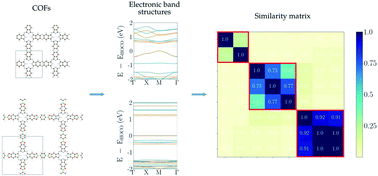
Two-dimensional Covalent Organic Frameworks (2D COFs) have attracted considerable interest because of their potential for a broad range of applications. Different combinations of the monomeric units can lead to potentially novel materials with varying physico-chemical properties. In this study, we investigate the electronic properties of various 2D COFs with square lattice topology based on a tight-binding density functional theory approach. We first classify the 2D COFs into different classes according to the degree of π-conjugation. Interestingly, this classification is recovered by using a similarity measure based on specific features of the electronic band-structure of the COFs. Further, we study the effect of aromaticity on the electronic structure of fully-conjugated COFs. Our results show that the conjugation and aromaticity are keys in the electronic band-structure of COFs.
Transition metal dichalcogenides as catalysts for the hydrogen evolution reaction: The emblematic case of “inert” ZrSe2 as catalyst for electrolyzers
L. Najafi, S. Bellani, M. I. Zappia, M. Serri, R. Oropesa-Nuñez, A. Bagheri, H. Beydaghi, R. Brescia, L. Pasquale, D. V. Shinde, Y. Zuo, F. Drago, K. Mosina, Z. Sofer, L. Manna, F. Bonaccorso
Nano Select, 2022, 3, 1069–1081. Link to article (open access).

The development of earth-abundant electrocatalysts (ECs) operating at high current densities in water splitting electrolyzers is pivotal for the widespread use of the current green hydrogen production plants. Transition metal dichalcogenides (TMDs) have emerged as promising alternatives to the most efficient noble metal ECs, leading to a wealth of research. Some strategies based on material nanostructuring and hybridization, introduction of defects and chemical/physical modifications appeared as universal approaches to provide catalytic properties to TMDs, regardless of the specific material. In this work, we show that even a theoretically poorly catalytic (and poorly studied) TMD, namely zirconium diselenide (ZrSe2), can act as an efficient EC for the hydrogen evolution reaction (HER) when exfoliated in the form of two-dimensional (2D) few-layer flakes. We critically show the difficulties of explaining the catalytic mechanisms of the resulting ECs in the presence of complex structural and chemical modifications, which are nevertheless evaluated extensively. By doing so, we also highlight the easiness of transforming 2D TMDs into effective HER-ECs. To strengthen our message in practical environments, we report ZrSe2-based acidic (proton exchange membrane [PEM]) and alkaline water electrolyzers operating at 400 mA cm–2 at a voltage of 1.88 and 1.92 V, respectively, thus competing with commercial technologies.
Sulfonated NbS2-based proton-exchange membranes for vanadium redox flow batteries
H. Beydaghi, S. Bellani, L. Najafi, R. Oropesa-Nuñez, G. Bianca, A. Bagheri, I. Conticello, B. Martín-García, S. Kashefi, M. Serri, L. Liao, Z. Sofer, V. Pellegrini, F. Bonaccorso
Nanoscale, 2022, 14, 6152–6161. Link to article (open access).
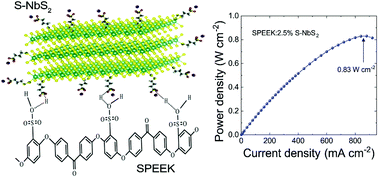
In this work, novel proton-exchange membranes (PEMs) based on sulfonated poly(ether ether ketone) (SPEEK) and two-dimensional (2D) sulfonated niobium disulphide (S-NbS2) nanoflakes are synthesized by a solution-casting method and used in vanadium redox flow batteries (VRFBs). The NbS2 nanoflakes are produced by liquid-phase exfoliation of their bulk counterpart and chemically functionalized with terminal sulfonate groups to improve dimensional and chemical stabilities, proton conductivity (σ) and fuel barrier properties of the as-produced membranes. The addition of S-NbS2 nanoflakes to SPEEK decreases the vanadium ion permeability from 5.42 × 10−7 to 2.34 × 10−7 cm2 min−1. Meanwhile, it increases the membrane σ and selectivity up to 94.35 mS cm−2 and 40.32 × 104 S min cm−3, respectively. The cell assembled with the optimized membrane incorporating 2.5 wt% of S-NbS2 nanoflakes (SPEEK:2.5% S-NbS2) exhibits high efficiency metrics, i.e., coulombic efficiency between 98.7 and 99.0%, voltage efficiency between 90.2 and 73.2% and energy efficiency between 89.3 and 72.8% within the current density range of 100–300 mA cm−2, delivering a maximum power density of 0.83 W cm−2 at a current density of 870 mA cm−2. The SPEEK:2.5% S-NbS2 membrane-based VRFBs show a stable behavior over 200 cycles at 200 mA cm−2. This study opens up an effective avenue for the production of advanced SPEEK-based membranes for VRFBs.
Observing polymerization in 2D dynamic covalent polymers
G. Zhan, Z.-F. Cai, K. Strutyński, L. Yu, N. Herrmann, M. Martínez-Abadía, M. Melle-Franco, A. Mateo-Alonso, S. De Feyter
Nature, 2022, 603, 835–840. Link to article and accepted manuscript (open access). Highlighted in Chemistry World and Phys.org.
 The quality of crystalline two-dimensional (2D) polymers is intimately related to the elusive polymerization and crystallization processes. Understanding the mechanism of such processes at the (sub)molecular level is crucial to improve predictive synthesis and to tailor material properties for applications in catalysis and (opto)electronics, among others. We characterize a model boroxine 2D dynamic covalent polymer, by using in situ scanning tunnelling microscopy, to unveil both qualitative and quantitative details of the nucleation–elongation processes in real time and under ambient conditions. Sequential data analysis enables observation of the amorphous-to-crystalline transition, the time-dependent evolution of nuclei, the existence of ‘non-classical’ crystallization pathways and, importantly, the experimental determination of essential crystallization parameters with excellent accuracy, including critical nucleus size, nucleation rate and growth rate. The experimental data have been further rationalized by atomistic computer models, which, taken together, provide a detailed picture of the dynamic on-surface polymerization process. Furthermore, we show how 2D crystal growth can be affected by abnormal grain growth. This finding provides support for the use of abnormal grain growth (a typical phenomenon in metallic and ceramic systems) to convert a polycrystalline structure into a single crystal in organic and 2D material systems.
The quality of crystalline two-dimensional (2D) polymers is intimately related to the elusive polymerization and crystallization processes. Understanding the mechanism of such processes at the (sub)molecular level is crucial to improve predictive synthesis and to tailor material properties for applications in catalysis and (opto)electronics, among others. We characterize a model boroxine 2D dynamic covalent polymer, by using in situ scanning tunnelling microscopy, to unveil both qualitative and quantitative details of the nucleation–elongation processes in real time and under ambient conditions. Sequential data analysis enables observation of the amorphous-to-crystalline transition, the time-dependent evolution of nuclei, the existence of ‘non-classical’ crystallization pathways and, importantly, the experimental determination of essential crystallization parameters with excellent accuracy, including critical nucleus size, nucleation rate and growth rate. The experimental data have been further rationalized by atomistic computer models, which, taken together, provide a detailed picture of the dynamic on-surface polymerization process. Furthermore, we show how 2D crystal growth can be affected by abnormal grain growth. This finding provides support for the use of abnormal grain growth (a typical phenomenon in metallic and ceramic systems) to convert a polycrystalline structure into a single crystal in organic and 2D material systems.
Solution Synthesis and Characterization of a Long and Curved Graphene Nanoribbon with Hybrid Cove–Armchair–Gulf Edge Structures
L. Yang, J. Ma, W. Zheng, S. Osella, J. Droste, H. Komber, K. Liu, S. Böckmann, D. Beljonne, M. R. Hansen, M. Bonn, H. I. Wang, J. Liu, X. Feng
Adv. Sci., 2022, 9, 2200708. Link to article (open access). Featured in Special Issue: Functional Carbon‐Rich Materials — Anniversary Issue for Klaus Müllen and Hot Topic: Carbon, Graphite, and Graphene.
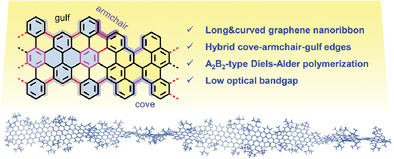
Curved graphene nanoribbons (GNRs) with hybrid edge structures have recently attracted increasing attention due to their unique band structures and electronic properties as a result of their nonplanar conformation. This work reports the solution synthesis of a long and curved multi-edged GNR (cMGNR) with unprecedented cove–armchair–gulf edge structures. The synthesis involves an efficient A2B2-type Diels–Alder polymerization between a diethynyl-substituted prefused bichrysene monomer (3b) and a dicyclopenta[e,l]pyrene-5,11-dione derivative (6) followed by FeCl3-mediated Scholl oxidative cyclodehydrogenation of the obtained polyarylenes (P1). Model compounds 1a and 1b are first synthesized to examine the suitability and efficiency of the corresponding polymers for the Scholl reaction. The successful formation of cMGNR from polymer P1 bearing prefused bichrysene units is confirmed by FTIR, Raman, and solid-state NMR analyses. The cove-edge structure of the cMGNR imparts the ribbon with a unique nonplanar conformation as revealed by density functional theory (DFT) simulation, which effectively enhances its dispersibility in solution. The cMGNR has a narrow optical bandgap of 1.61 eV, as estimated from the UV–vis absorption spectrum, which is among the family of low-bandgap solution-synthesized GNRs. Moreover, the cMGNR exhibits a carrier mobility of ≈2 cm2 V−1 s−1 inferred from contact-free terahertz spectroscopy.
Combination of Knoevenagel Polycondensation and Water-Assisted Dynamic Michael-Addition-Elimination for the Synthesis of Vinylene-Linked 2D Covalent Organic Frameworks
S. Xu, Z. Liao, A. Dianat, S.-W. Park, M. A. Addicoat, Y. Fu, D. L. Pastoetter, F. G. Fabozzi, Y. Liu, G. Cuniberti, M. Richter, S. Hecht, X. Feng
Angew. Chem. Int. Ed., 2022, 61, e202202492. Link to article (open access).

Vinylene-linked two-dimensional conjugated covalent organic frameworks (V-2D-COFs), belonging to the class of two-dimensional conjugated polymers, have attracted increasing attention due to their extended π-conjugation over the 2D backbones associated with high chemical stability. The Knoevenagel polycondensation has been demonstrated as a robust synthetic method to provide cyano (CN)-substituted V-2D-COFs with unique optoelectronic, magnetic, and redox properties. Despite the successful synthesis, it remains elusive for the relevant polymerization mechanism, which leads to relatively low crystallinity and poor reproducibility. In this work, we demonstrate the novel synthesis of CN-substituted V-2D-COFs via the combination of Knoevenagel polycondensation and water-assisted dynamic Michael-addition-elimination, abbreviated as KMAE polymerization. The existence of C=C bond exchange between two diphenylacrylonitriles (M1 and M6) is firstly confirmed via in situ high-temperature NMR spectroscopy study of model reactions. Notably, the intermediate M4 synthesized via Michael-addition can proceed the Michael-elimination quantitatively, leading to an efficient C=C bond exchange, unambiguously confirming the dynamic nature of Michael-addition-elimination. Furthermore, the addition of water can significantly promote the reaction rate of Michael-addition-elimination for highly efficient C=C bond exchange within 5 mins. As a result, the KMAE polymerization provides a highly efficient strategy for the synthesis of CN-substituted V-2D-COFs with high crystallinity, as demonstrated by four examples of V-2D-COF-TFPB-PDAN, V-2D-COF-TFPT-PDAN, V-2D-COF-TFPB-BDAN, and V-2D-COF-HATN-BDAN, based on the simulated and experimental powder X-ray diffraction (PXRD) patterns as well as N2-adsorption–desorption measurements. Moreover, high-resolution transmission electron microscopy (HR-TEM) analysis shows crystalline domain sizes ranging from 20 to 100 nm for the newly synthesized V-2D-COFs.
Reverse-Bias and Temperature Behaviors of Perovskite Solar Cells at Extended Voltage Range
L. Najafi, S. Bellani, L. Gabatel, M. I. Zappia, A. Di Carlo, F. Bonaccorso
ACS Appl. Energy Mater., 2022, 5, 1378–1384. Link to article (open access).
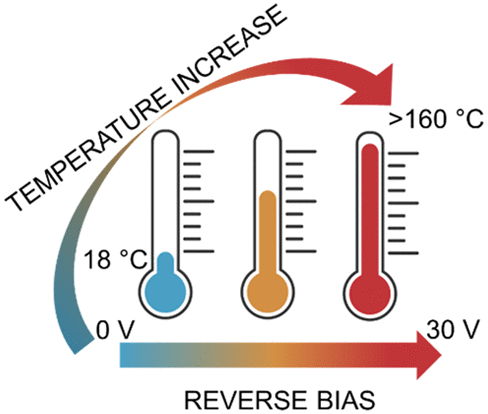
Perovskite solar cells have reached certified power conversion efficiency over 25%, enabling the realization of efficient large-area modules and even solar farms. It is therefore essential to deal with technical aspects, including the reverse-bias operation and hot-spot effects, which are crucial for the practical implementation of any photovoltaic technology. Here, we analyze the reverse bias (from 2.5 to 30 V) and temperature behavior of mesoscopic cells through infrared thermal imaging coupled with current density measurements. We show that the occurrence of local heating (hot-spots) and arc faults, caused by local shunts, must be considered during cell and module designing.
Control of Crystallinity of Vinylene-Linked Two-Dimensional Conjugated Polymers by Rational Monomer Design
D. L. Pastoetter, Y. Liu, M. A. Addicoat, S. Paasch, A. Dianat, D. Bodesheim, A. L. Waentig, S. Xu, M. Borrelli, A. Croy, M. Richter, E. Brunner, G. Cuniberti, X. Feng
Chem. Eur. J., 2022, 28, e202104502. Link to article (open access). Featured in Society Volumes: Germany.

The interest in two-dimensional conjugated polymers (2D CPs) has increased significantly in recent years. In particular, vinylene-linked 2D CPs with fully in-plane sp2-carbon-conjugated structures, high thermal and chemical stability, have become the focus of attention. Although the Horner-Wadsworth-Emmons (HWE) reaction has been recently demonstrated in synthesizing vinylene-linked 2D CPs, it remains largely unexplored due to the challenge in synthesis. In this work, we reveal the control of crystallinity of 2D CPs during the solvothermal synthesis of 2D-poly(phenylene-quinoxaline-vinylene)s (2D-PPQVs) and 2D-poly(phenylene-vinylene)s through the HWE polycondensation. The employment of fluorinated phosphonates and rigid aldehyde building blocks is demonstrated as crucial factors in enhancing the crystallinity of the obtained 2D CPs. Density functional theory (DFT) calculations reveal the critical role of the fluorinated phosphonate in enhancing the reversibility of the (semi)reversible C−C single bond formation.
High-Performance Humidity Sensing in π-Conjugated Molecular Assemblies through the Engineering of Electron/Proton Transport and Device Interfaces
N. Turetta, M.-A. Stoeckel, R. Furlan de Oliveira, F. Devaux, A. Greco, C. Cendra, S. Gullace, M. Gicevičius, B. Chattopadhyay, J. Liu, G. Schweicher, H. Sirringhaus, A. Salleo, M. Bonn, E. H. G. Backus, Y. H. Geerts, P. Samorì
J. Am. Chem. Soc., 2022, 144, 2546–2555. Link to article and accepted manuscript (open access).
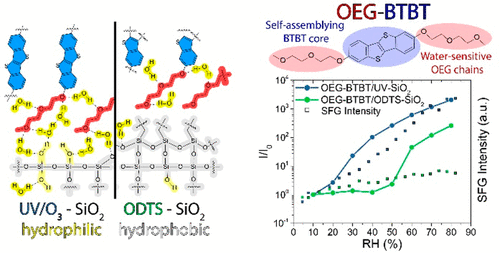
The development of systems capable of responding to environmental changes, such as humidity, requires the design and assembly of highly sensitive and efficiently transducing elements. Such a challenge can be mastered only by disentangling the role played by each component of the responsive system, thus ultimately achieving high performance by optimizing the synergistic contribution of all functional elements. Here, we designed and synthesized a novel [1]benzothieno[3,2-b][1]benzothiophene derivative equipped with hydrophilic oligoethylene glycol lateral chains (OEG-BTBT) that can electrically transduce subtle changes in ambient humidity with high current ratios (>104) at low voltages (2 V), reaching state-of-the-art performance. Multiscale structural, spectroscopical, and electrical characterizations were employed to elucidate the role of each device constituent, viz., the active material’s BTBT core and OEG side chains, and the device interfaces. While the BTBT molecular core promotes the self-assembly of (semi)conducting crystalline films, its OEG side chains are prone to adsorb ambient moisture. These chains act as hotspots for hydrogen bonding with atmospheric water molecules that locally dissociate when a bias voltage is applied, resulting in a mixed electronic/protonic long-range conduction throughout the film. Due to the OEG-BTBT molecules’ orientation with respect to the surface and structural defects within the film, water molecules can access the humidity-sensitive sites of the SiO2 substrate surface, whose hydrophilicity can be tuned for an improved device response. The synergistic chemical engineering of materials and interfaces is thus key for designing highly sensitive humidity-responsive electrical devices whose mechanism relies on the interplay of electron and proton transport.
Visualization and identification of single meteoritic organic molecules by atomic force microscopy
K. Kaiser, F. Schulz, J. F. Maillard, F. Hermann, I. Pozo, D. Peña, H. J. Cleaves II, A. S. Burton, G. Danger, C. Afonso, S. Sandford, L. Gross
Meteorit. Planet. Sci., 2022, 57, 644–656. Link to article (open access). COVER PAGE. Highlighted in IBM Research Blog, C&EN, Chemistry World and Le Parisien. YouTube video.
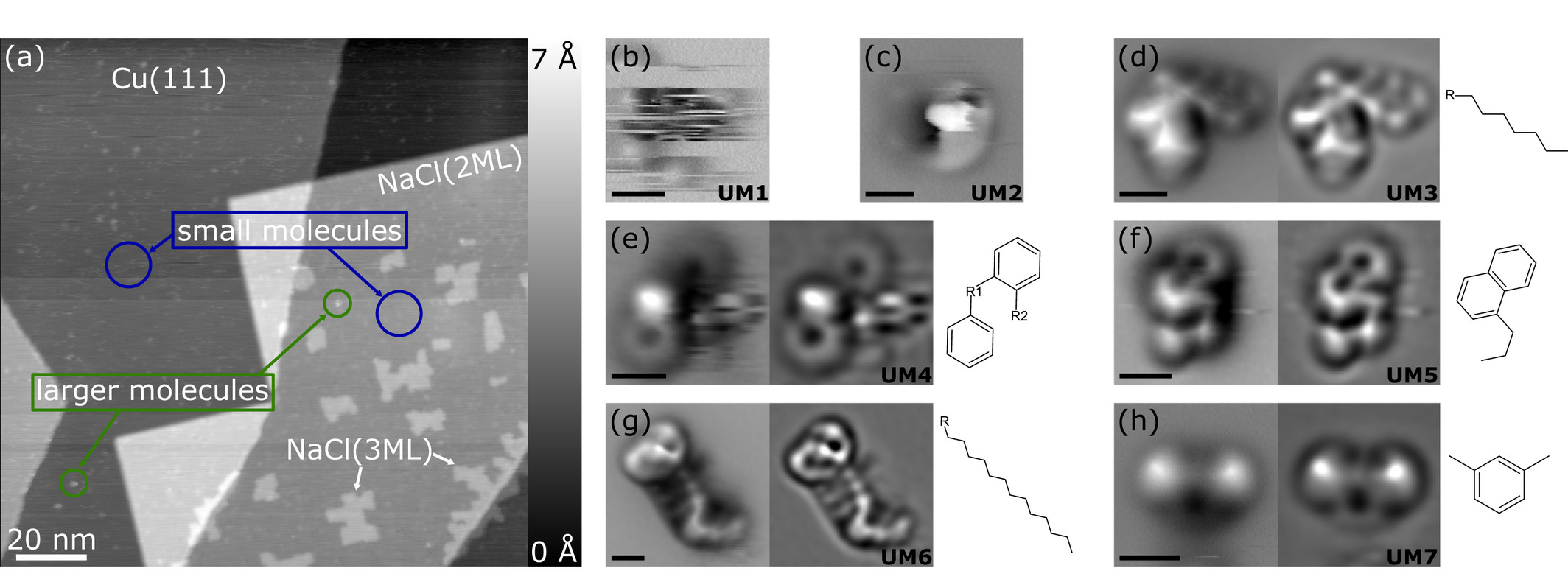 Using high-resolution atomic force microscopy (AFM) with CO-functionalized tips, we atomically resolved individual molecules from Murchison meteorite samples. We analyzed powdered Murchison meteorite material directly, as well as processed extracts that we prepared to facilitate characterization by AFM. From the untreated Murchison sample, we resolved very few molecules, as the sample contained mostly small molecules that could not be identified by AFM. By contrast, using a procedure based on several trituration and extraction steps with organic solvents, we isolated a fraction enriched in larger organic compounds. The treatment increased the fraction of molecules that could be resolved by AFM, allowing us to identify organic constituents and molecular moieties, such as polycyclic aromatic hydrocarbons and aliphatic chains. The AFM measurements are complemented by high-resolution mass spectrometry analysis of Murchison fractions. We provide a proof of principle that AFM can be used to image and identify individual organic molecules from meteorites and propose a method for extracting and preparing meteorite samples for their investigation by AFM. We discuss the challenges and prospects of this approach to study extraterrestrial samples based on single-molecule identification.
Using high-resolution atomic force microscopy (AFM) with CO-functionalized tips, we atomically resolved individual molecules from Murchison meteorite samples. We analyzed powdered Murchison meteorite material directly, as well as processed extracts that we prepared to facilitate characterization by AFM. From the untreated Murchison sample, we resolved very few molecules, as the sample contained mostly small molecules that could not be identified by AFM. By contrast, using a procedure based on several trituration and extraction steps with organic solvents, we isolated a fraction enriched in larger organic compounds. The treatment increased the fraction of molecules that could be resolved by AFM, allowing us to identify organic constituents and molecular moieties, such as polycyclic aromatic hydrocarbons and aliphatic chains. The AFM measurements are complemented by high-resolution mass spectrometry analysis of Murchison fractions. We provide a proof of principle that AFM can be used to image and identify individual organic molecules from meteorites and propose a method for extracting and preparing meteorite samples for their investigation by AFM. We discuss the challenges and prospects of this approach to study extraterrestrial samples based on single-molecule identification.
Cove-Edged Graphene Nanoribbons with Incorporation of Periodic Zigzag-Edge Segments
X. Wang, J. Ma, W. Zheng, S. Osella, N. Arisnabarreta, J. Droste, G. Serra, O. Ivasenko, A. Lucotti, D. Beljonne, M. Bonn, X. Liu, M. R. Hansen, M. Tommasini, S. De Feyter, J. Liu, H. I. Wang, X. Feng
J. Am. Chem. Soc., 2022, 144, 228–235. Link to article and accepted manuscript (open access).
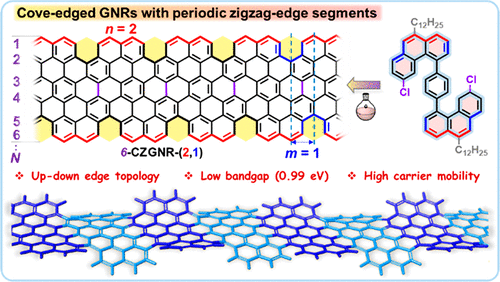
Structurally precision graphene nanoribbons (GNRs) are promising candidates for next-generation nanoelectronics due to their intriguing and tunable electronic structures. GNRs with hybrid edge structures often confer them unique geometries associated with exotic physicochemical properties. Herein, a novel type of cove-edged GNRs with periodic short zigzag-edge segments is demonstrated. The bandgap of this GNR family can be tuned using an interplay between the length of the zigzag segments and the distance of two adjacent cove units along the opposite edges, which can be converted from semiconducting to nearly metallic. A family member with periodic cove-zigzag edges based on N = 6 zigzag-edged GNR, namely 6-CZGNR-(2,1), is successfully synthesized in solution through the Scholl reaction of a unique snakelike polymer precursor (10) that is achieved by the Yamamoto coupling of a structurally flexible S-shaped phenanthrene-based monomer (1). The efficiency of cyclodehydrogenation of polymer 10 toward 6-CZGNR-(2,1) is validated by FT-IR, Raman, and UV–vis spectroscopies, as well as by the study of two representative model compounds (2 and 3). Remarkably, the resultant 6-CZGNR-(2,1) exhibits an extended and broad absorption in the near-infrared region with a record narrow optical bandgap of 0.99 eV among the reported solution-synthesized GNRs. Moreover, 6-CZGNR-(2,1) exhibits a high macroscopic carrier mobility of ∼20 cm2 V–1 s–1 determined by terahertz spectroscopy, primarily due to the intrinsically small effective mass (m*e = m*h = 0.17 m0), rendering this GNR a promising candidate for nanoelectronics.
Topochemical Transformation of Two-Dimensional VSe2 into Metallic Nonlayered VO2 for Water Splitting Reactions in Acidic and Alkaline Media
L. Najafi, R. Oropesa-Nuñez, S. Bellani, B. Martín-García, L. Pasquale, M. Serri, F. Drago, J. Luxa, Z. Sofer, D. Sedmidubský, R. Brescia, S. Lauciello, M. I. Zappia, D. V. Shinde, L. Manna, F. Bonaccorso
ACS Nano, 2022, 16, 351–367. Link to article (open access).
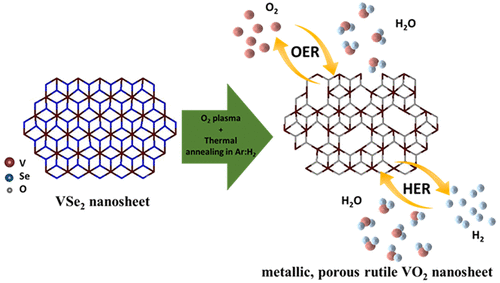
The engineering of the structural and morphological properties of nanomaterials is a fundamental aspect to attain desired performance in energy storage/conversion systems and multifunctional composites. We report the synthesis of room temperature-stable metallic rutile VO2 (VO2 (R)) nanosheets by topochemically transforming liquid-phase exfoliated VSe2 in a reductive Ar–H2 atmosphere. The as-produced VO2 (R) represents an example of two-dimensional (2D) nonlayered materials, whose bulk counterparts do not have a layered structure composed by layers held together by van der Waals force or electrostatic forces between charged layers and counterbalancing ions amid them. By pretreating the VSe2 nanosheets by O2 plasma, the resulting 2D VO2 (R) nanosheets exhibit a porous morphology that increases the material specific surface area while introducing defective sites. The as-synthesized porous (holey)-VO2 (R) nanosheets are investigated as metallic catalysts for the water splitting reactions in both acidic and alkaline media, reaching a maximum mass activity of 972.3 A g–1 at −0.300 V vs RHE for the hydrogen evolution reaction (HER) in 0.5 M H2SO4 (faradaic efficiency = 100%, overpotential for the HER at 10 mA cm–2 = 0.184 V) and a mass activity (calculated for a non 100% faradaic efficiency) of 745.9 A g–1 at +1.580 V vs RHE for the oxygen evolution reaction (OER) in 1 M KOH (overpotential for the OER at 10 mA cm–2 = 0.209 V). By demonstrating proof-of-concept electrolyzers, our results show the possibility to synthesize special material phases through topochemical conversion of 2D materials for advanced energy-related applications.
On-water surface synthesis of charged two-dimensional polymer single crystals via the irreversible Katritzky reaction
Z. Wang, Z. Zhang, H. Qi, A. Ortega-Guerrero, L. Wang, K. Xu, M. Wang, S. Park, F. Hennersdorf, A. Dianat, A. Croy, H. Komber, G. Cuniberti, J. J. Weigand, U. Kaiser, R. Dong, X. Feng
Nat. Synth., 2022, 1, 69–76. Link to article and accepted manuscript (open access).
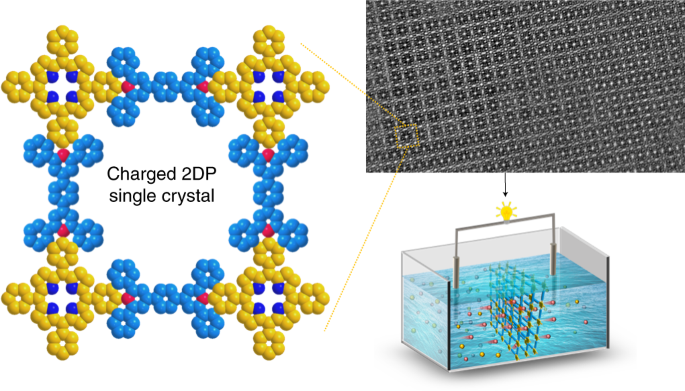
Two-dimensional polymers (2DPs) and their layer-stacked 2D covalent organic frameworks (2D COFs) are classes of structurally defined crystalline polymeric materials with exotic physical and chemical properties. Yet, synthesizing 2DP and 2D COF single crystals via irreversible reactions remains challenging. Here we report the synthesis of charged 2DP (C2DP) single crystals through an irreversible Katritzky reaction, under pH control, on a water surface. The periodically ordered 2DPs comprise aromatic pyridinium cations and counter BF4− anions. The C2DP crystals, which are composed of linked porphyrin and pyrylium monomers (C2DP-Por), have a tunable thickness of 2–30 nm and a lateral domain size up to 120 μm2. Single crystals with a square lattice (a = b = 30.5 Å) are resolved by imaging and diffraction methods with near-atomic precision. Furthermore, the integration of C2DP-Por crystals in an osmotic power generator device shows an excellent chloride ion selectivity with a coefficient value reaching ~0.9 and an output power density of 4 W m−2, superior to those of graphene and boron nitride.
Viologen-Immobilized 2D Polymer Film Enabling Highly Efficient Electrochromic Device for Solar-Powered Smart Window
Z. Wang, X. Jia, P. Zhang, Y. Liu, H. Qi, P. Zhang, U. Kaiser, S. Reineke, R. Dong, X. Feng
Adv. Mater., 2022, 34, 2106073. Link to article (open access). TUD and cfaed press releases.
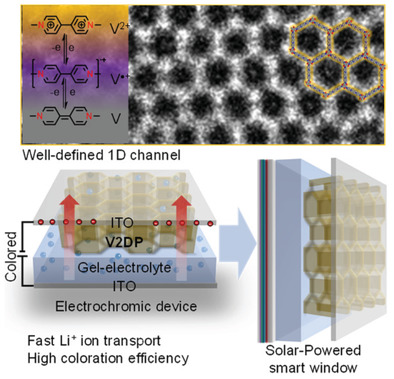
Electrochromic devices (ECDs) have emerged as a unique class of optoelectronic devices for the development of smart windows. However, current ECDs typically suffer from low coloration efficiency (CE) and high energy consumption, which have thus hindered their practical applications, especially as components in solar-powered EC windows. Here, the high-performance ECDs with a fully crystalline viologen-immobilized 2D polymer (V2DP) thin film as the color-switching layer is demonstrated. The high density of vertically oriented pore channels (pore size ≈ 4.5 nm; pore density ≈ 5.8 × 1016 m-2) in the synthetic V2DP film enables high utilization of redox-active viologen moieties and benefits for Li+ ion diffusion/transport. As a result, the as-fabricated ECDs achieve a rapid switching speed (coloration, 2.8 s; bleaching, 1.2 s), and a high CE (989 cm2 C-1), and low energy consumption (21.1 µW cm-2). Moreover, it is managed to fabricate transmission-tunable, self-sustainable EC window prototypes by vertically integrating the V2DP ECDs with transparent solar cells. This work sheds light on designing electroactive 2D polymers with molecular precision for optoelectronics and paves a practical route toward developing self-powered EC windows to offset the electricity consumption of buildings.
Quantum Capacitance through Molecular Infiltration of 7,7,8,8-Tetracyanoquinodimethane in Metal–Organic Framework/Covalent Organic Framework Hybrids
H. Peng, S. Huang, D. Tranca, F. Richard, W. Baaziz, X. Zhuang, P. Samorì, A. Ciesielski
ACS Nano, 2021, 15, 18580–18589. Link to article and accepted manuscript (open access).
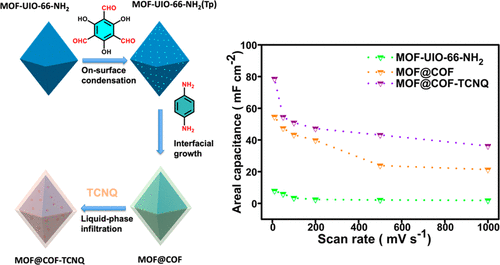
Metal–organic frameworks (MOFs) and covalent organic frameworks (COFs) have been extensively investigated during the last two decades. More recently, a family of hybrid materials (i.e., MOF@COF) has emerged as particularly appealing for gas separation and storage, catalysis, sensing, and drug delivery. MOF@COF hybrids combine the unique characteristics of both MOF and COF components and exhibit peculiar properties including high porosity and large surface area. In this work, we show that the infiltration of redox-active 7,7,8,8-tetracyanoquinodimethane (TCNQ) molecules into the pores of MOF@COF greatly improves the characteristics of the latter, thereby attaining high-performance energy storage devices. Density functional theory (DFT) calculations were employed to guide the design of a MOF@COF-TCNQ hybrid with the TCNQ functional units incorporated in the pores of MOF@COF. To demonstrate potential application of our hybrids, the as-synthesized MOF@COF-TCNQ hybrid has been employed as an active material in supercapacitors. Electrochemical energy storage analysis revealed outstanding supercapacitor performance, as evidenced by a specific areal capacitance of 78.36 mF cm–2 and a high stack volumetric energy density of 4.46 F cm–3, with a capacitance retention of 86.4% after 2000 cycles completed at 0.2 A cm–2. DFT calculation results strongly indicate that the high capacitance of MOF@COF-TCNQ has a quantum capacitance origin. Our liquid-phase infiltration protocol of MOF@COF hybrids with redox-active molecules represents a efficacious approach to design functional porous hybrids.
Field-effect-transistor-based ion sensors: ultrasensitive mercury(II) detection via healing MoS2 defects
F. J. Urbanos, S. Gullace, P. Samorì
Nanoscale, 2021, 13, 19682–19689. Link to article and accepted manuscript (open access).
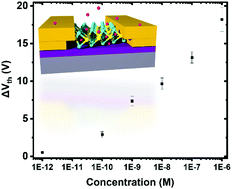
The contamination of water with heavy metal ions represents a harsh environmental problem resulting from societal development. Among various hazardous compounds, mercury ions (Hg2+) surely belong to the most poisonous ones. Their accumulation in the human body results in health deterioration, affecting vital organs and eventually leading to chronic diseases, and, in the worst-case scenario, early death. High selectivity and sensitivity for the analyte of choice can be achieved in chemical sensing using suitable active materials capable of interacting at the supramolecular level with the chosen species. Among them, 2D transition metal dichalcogenides (TMDCs) have attracted great attention as sensory materials because of their unique physical and chemical properties, which are highly susceptible to environmental changes. In this work, we have fabricated MoS2-based field-effect transistors (FETs) and exploited them as platforms for Hg2+ sensing, relying on the affinity of heavy metal ions for both point defects in TMDCs and sulphur atoms in the MoS2 lattice. X-ray photoelectron spectroscopy characterization showed both a significant reduction of the defectiveness of MoS2 when exposed to Hg2+ with increasing concentration and a shift in the binding energy of 0.2 eV suggesting p-type doping of the 2D semiconductor. The efficient defect healing has been confirmed also by low-temperature photoluminescence measurements by monitoring the attenuation of defect-related bands after Hg2+ exposure. Transfer characteristics in MoS2 FETs provided further evidence that Hg2+ acts as a p-dopant of MoS2. Interestingly, we observed a strict correlation of doping with the concentration of Hg2+, following a semi-log trend. Hg2+ concentrations as low as 1 pM can be detected, being way below the limits imposed by health regulations. Electrical characterization also revealed that our sensor can be efficiently washed and used multiple times. Moreover, the developed devices displayed a markedly high selectivity for Hg2+ against other metal ions as ruled by soft/soft interaction among chemical systems with appropriate redox potentials, being a generally applicable approach to develop chemical sensing devices combining high sensitivity, selectivity and reversibility, to meet technological needs.
3D printed silicon-few layer graphene anode for advanced Li-ion batteries
H. Beydaghi, S. Abouali, S. B. Thorat, A. E. Del Rio Castillo, S. Bellani, S. Lauciello, S. Gentiluomo, V. Pellegrini, F. Bonaccorso
RSC Adv., 2021, 11, 35051–35060. Link to article (open access).
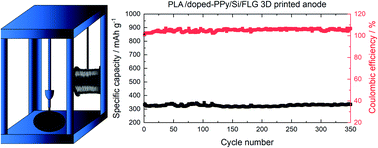
The printing of three-dimensional (3D) porous electrodes for Li-ion batteries is considered a key driver for the design and realization of advanced energy storage systems. While different 3D printing techniques offer great potential to design and develop 3D architectures, several factors need to be addressed to print 3D electrodes, maintaining an optimal trade-off between electrochemical and mechanical performances. Herein, we report the first demonstration of 3D printed Si-based electrodes fabricated using a simple and cost-effective fused deposition modelling (FDM) method, and implemented as anodes in Li-ion batteries. To fulfil the printability requirement while maximizing the electrochemical performance, the composition of the FDM filament has been engineered using polylactic acid as the host polymeric matrix, a mixture of carbon black-doped polypyrrole and wet-jet milling exfoliated few-layer graphene flakes as conductive additives, and Si nanoparticles as the active material. The creation of a continuous conductive network and the control of the structural properties at the nanoscale enabled the design and realization of flexible 3D printed anodes, reaching a specific capacity up to ∼345 mA h g−1 at the current density of 20 mA g−1, together with a capacity retention of 96% after 350 cycles. The obtained results are promising for the fabrication of flexible polymeric-based 3D energy storage devices to meet the challenges ahead for the design of next-generation electronic devices.
NBN-Doped Bis-Tetracene and Peri-Tetracene: Synthesis and Characterization
Y. Fu, X. Chang, H. Yang, E. Dmitrieva, Y. Gao, J. Ma, L. Huang, J. Liu, H. Lu, Z. Cheng, S. Du, H.-J. Gao, X. Feng
Angew. Chem. Int. Ed., 2021, 60, 26115–26121. Link to article (open access). Selected as a Very Important Paper. TUD, cfaed and ChemistryViews press releases.

Combining solution-based and surface-assisted synthesis, we demonstrate the first synthesis of NBN-doped bis-tetracene (NBN-BT) and peri-tetracene (NBN-PT). The chemical structures are clearly elucidated by high-resolution scanning tunneling microscopy (STM) in combination with noncontact atomic force microscopy (nc-AFM). Scanning tunneling spectroscopy (STS) characterizations reveal that NBN-BT and NBN-PT possess higher energy gaps than bis-tetracene and peri-tetracene. Interestingly, NBN-BT can undergo stepwise one-electron oxidation and convert into its corresponding radical cation and then to its dication. The energy gap of the NBN-BT dication is similar to that of bis-tetracene, indicating their isoelectronic relationship. Moreover, a similar energy gap between the NBN-PT dication and peri-tetracene can be predicted by DFT calculations. This work provides a novel synthesis along with characterizations of multi-NBN-doped zigzag-edged peri-acenes with tunable electronic properties.
Solution-processed two-dimensional materials for next-generation photovoltaics
S. Bellani, A. Bartolotta, A. Agresti, G. Calogero, G. Grancini, A. Di Carlo, E. Kymakis, Francesco Bonaccorso
Chem. Soc. Rev., 2021, 50, 11870–11965. Link to article (open access). Featured in Themed Collection: Electrochemistry in Energy Storage and Conversion.
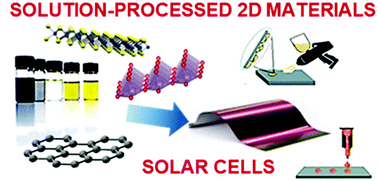
In the ever-increasing energy demand scenario, the development of novel photovoltaic (PV) technologies is considered to be one of the key solutions to fulfil the energy request. In this context, graphene and related two-dimensional (2D) materials (GRMs), including nonlayered 2D materials and 2D perovskites, as well as their hybrid systems, are emerging as promising candidates to drive innovation in PV technologies. The mechanical, thermal, and optoelectronic properties of GRMs can be exploited in different active components of solar cells to design next-generation devices. These components include front (transparent) and back conductive electrodes, charge transporting layers, and interconnecting/recombination layers, as well as photoactive layers. The production and processing of GRMs in the liquid phase, coupled with the ability to “on-demand” tune their optoelectronic properties exploiting wet-chemical functionalization, enable their effective integration in advanced PV devices through scalable, reliable, and inexpensive printing/coating processes. Herein, we review the progresses in the use of solution-processed 2D materials in organic solar cells, dye-sensitized solar cells, perovskite solar cells, quantum dot solar cells, and organic–inorganic hybrid solar cells, as well as in tandem systems. We first provide a brief introduction on the properties of 2D materials and their production methods by solution-processing routes. Then, we discuss the functionality of 2D materials for electrodes, photoactive layer components/additives, charge transporting layers, and interconnecting layers through figures of merit, which allow the performance of solar cells to be determined and compared with the state-of-the-art values. We finally outline the roadmap for the further exploitation of solution-processed 2D materials to boost the performance of PV devices.
On-Surface Synthesis and Characterization of Super-nonazethrene
E. Turco, S. Mishra, J. Melidonie, K. Eimre, S. Obermann, C. A. Pignedoli, R. Fasel, X. Feng, P. Ruffieux
J. Phys. Chem. Lett., 2021, 12, 8314–8319. Link to article and accepted manuscript (open access).
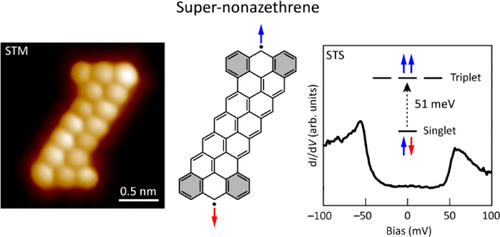
Beginning with the early work of Clar et al. in 1955, zethrenes and their laterally extended homologues, super-zethrenes, have been intensively studied in the solution phase and widely investigated as optical and charge transport materials. Superzethrenes are also considered to exhibit an open-shell ground state and may thus serve as model compounds to investigate nanoscale π-magnetism. However, their synthesis is extremely challenging due to their high reactivity. We report here the on-surface synthesis of the hitherto largest zethrene homologue—super-nonazethrene—on Au(111). Using single-molecule scanning tunneling microscopy and spectroscopy, we show that super-nonazethrene exhibits an open-shell singlet ground state featuring a large spin polarization-driven electronic gap of 1 eV. Consistent with the emergence of an open-shell ground state, high-resolution tunneling spectroscopy reveals singlet–triplet spin excitations in super-nonazethrene, characterized by a strong intramolecular magnetic exchange coupling of 51 meV. Given the paucity of zethrene chemistry on surfaces, our results therefore provide unprecedented access to large, open-shell zethrene compounds amenable to scanning probe measurements, with potential application in molecular spintronics.
Harnessing selectivity in chemical sensing via supramolecular interactions: from functionalization of nanomaterials to device applications
R. Furlan de Oliveira, V. Montes-García, A. Ciesielski, P. Samorì
Mater. Horiz., 2021, 8, 2685–2708. Link to article and accepted manuscript (open access).
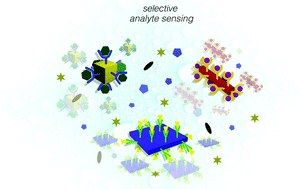
Chemical sensing is a strategic field of science and technology ultimately aiming at improving the quality of our lives and the sustainability of our Planet. Sensors bear a direct societal impact on well-being, which includes the quality and composition of the air we breathe, the water we drink, and the food we eat. Pristine low-dimensional materials are widely exploited as highly sensitive elements in chemical sensors, although they suffer from lack of intrinsic selectivity towards specific analytes. Here, we showcase the most recent strategies on the use of (supra)molecular interactions to harness the selectivity of suitably functionalized 0D, 1D, and 2D low-dimensional materials for chemical sensing. We discuss how the design and selection of receptors via machine learning and artificial intelligence hold a disruptive potential in chemical sensing, where selectivity is achieved by the design and high-throughput screening of large libraries of molecules exhibiting a set of affinity parameters that dictates the analyte specificity. We also discuss the importance of achieving selectivity along with other relevant characteristics in chemical sensing, such as high sensitivity, response speed, and reversibility, as milestones for true practical applications. Finally, for each distinct class of low-dimensional material, we present the most suitable functionalization strategies for their incorporation into efficient transducers for chemical sensing.
Interfacial Synthesis of Layer-Oriented 2D Conjugated Metal–Organic Framework Films toward Directional Charge Transport
Z. Wang, L. S. Walter, M. Wang, P. St. Petkov, B. Liang, H. Qi, N. N. Nguyen, M. Hambsch, H. Zhong, M. Wang, S. Park, L. Renn, K. Watanabe, T. Taniguchi, S. C. B. Mannsfeld, T. Heine, U. Kaiser, S. Zhou, R. T. Weitz, X. Feng, R. Dong
J. Am. Chem. Soc., 2021, 143, 13624–13632. Link to article and accepted manuscript (open access). COVER PAGE. TUD press release.
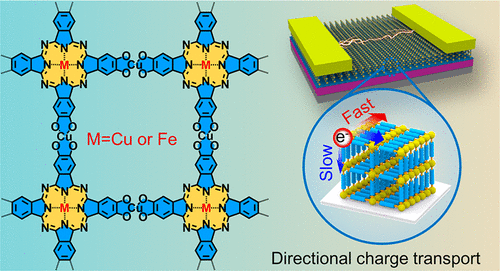
The development of layer-oriented two-dimensional conjugated metal–organic frameworks (2D c-MOFs) enables access to direct charge transport, dial-in lateral/vertical electronic devices, and the unveiling of transport mechanisms but remains a significant synthetic challenge. Here we report the novel synthesis of metal-phthalocyanine-based p-type semiconducting 2D c-MOF films (Cu2[PcM–O8], M = Cu or Fe) with an unprecedented edge-on layer orientation at the air/water interface. The edge-on structure formation is guided by the preorganization of metal-phthalocyanine ligands, whose basal plane is perpendicular to the water surface due to their π–π interaction and hydrophobicity. Benefiting from the unique layer orientation, we are able to investigate the lateral and vertical conductivities by DC methods and thus demonstrate an anisotropic charge transport in the resulting Cu2[PcCu–O8] film. The directional conductivity studies combined with theoretical calculation identify that the intrinsic conductivity is dominated by charge transfer along the interlayer pathway. Moreover, a macroscopic (cm2 size) Hall-effect measurement reveals a Hall mobility of ∼4.4 cm2 V–1 s–1 for the obtained Cu2[PcCu–O8] film. The orientation control in semiconducting 2D c-MOFs will enable the development of various optoelectronic applications and the exploration of unique transport properties.
Dependence of the polycarbonate mechanical performances on boron nitride flakes morphology
E. Lago, P. S. Toth, S. Gentiluomo, S. B. Thorat, V. Pellegrini, F. Bonaccorso
J. Phys. Mater., 2021, 4, 045002. Link to article (open access).
 A key requirement for the exploitation of two-dimensional (2D)-crystals in the field of composites relies on their large-scale production. In this respect, liquid phase exfoliation of layered-crystals is emerging as one of the most promising approaches for the scalable production of high-quality 2D-crystals. However, the dependence of the 2D crystal flakes morphology, i.e. thickness and lateral size, on the mechanical properties of the polymer composites is not fully understood yet. Herein, we tackle this issue by designing an environmentally friendly approach, based on the exfoliation of bulk hexagonal-boron nitride (h-BN), widely used as filler in polymer composites for its high intrinsic stiffness, i.e. approaching 1 TPa, in a water/surfactant solution with controlled thickness and lateral size by using cascade ultra-centrifugation. Our approach allows us to obtain two populations of flakes with aspect ratio, i.e. lateral size over thickness, equal to 250 and 350, respectively. The h-BN flakes with tuned aspect ratio are subsequently used as filler in a polycarbonate (PC) matrix by exploiting solution blending in 1,3-dioxolane, a solvent with Hansen's solubility parameters matching the ones of h-BN, thus enhancing the dispersion of the filler inside the matrix, as evaluated by Raman mapping. We tested the composite mechanical properties finding that flakes with higher aspect ratio show superior reinforcements in terms of both ultimate tensile strength and Young's modulus, compared with their lower aspect ratio counterparts. As example, at 0.1 wt% of loading, the difference in reinforcement in terms of Young's Modulus is of 56 MPa, being the increment, compared to pristine PC, of ~22% for composites produced with higher aspect ratio fillers, whereas it is instead of only ~17% for lower aspect ratio fillers.
A key requirement for the exploitation of two-dimensional (2D)-crystals in the field of composites relies on their large-scale production. In this respect, liquid phase exfoliation of layered-crystals is emerging as one of the most promising approaches for the scalable production of high-quality 2D-crystals. However, the dependence of the 2D crystal flakes morphology, i.e. thickness and lateral size, on the mechanical properties of the polymer composites is not fully understood yet. Herein, we tackle this issue by designing an environmentally friendly approach, based on the exfoliation of bulk hexagonal-boron nitride (h-BN), widely used as filler in polymer composites for its high intrinsic stiffness, i.e. approaching 1 TPa, in a water/surfactant solution with controlled thickness and lateral size by using cascade ultra-centrifugation. Our approach allows us to obtain two populations of flakes with aspect ratio, i.e. lateral size over thickness, equal to 250 and 350, respectively. The h-BN flakes with tuned aspect ratio are subsequently used as filler in a polycarbonate (PC) matrix by exploiting solution blending in 1,3-dioxolane, a solvent with Hansen's solubility parameters matching the ones of h-BN, thus enhancing the dispersion of the filler inside the matrix, as evaluated by Raman mapping. We tested the composite mechanical properties finding that flakes with higher aspect ratio show superior reinforcements in terms of both ultimate tensile strength and Young's modulus, compared with their lower aspect ratio counterparts. As example, at 0.1 wt% of loading, the difference in reinforcement in terms of Young's Modulus is of 56 MPa, being the increment, compared to pristine PC, of ~22% for composites produced with higher aspect ratio fillers, whereas it is instead of only ~17% for lower aspect ratio fillers.
Two-Dimensional Gallium Sulfide Nanoflakes for UV-Selective Photoelectrochemical-type Photodetectors
M. I. Zappia, G. Bianca, S. Bellani, N. Curreli, Z. Sofer, M. Serri, L. Najafi, M. Piccinni, R. Oropesa-Nuñez, P. Marvan, V. Pellegrini, I. Kriegel, M. Prato, A. Cupolillo, F. Bonaccorso
J. Phys. Chem. C, 2021, 125, 11857–11866. Link to article (open access).
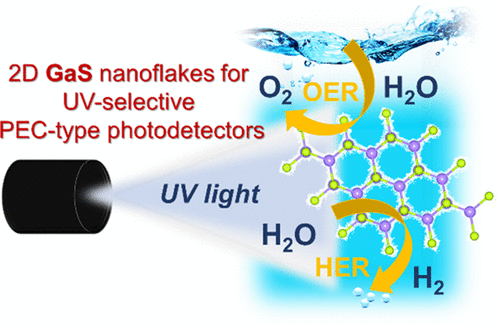
Two-dimensional (2D) transition-metal monochalcogenides have been recently predicted to be potential photo(electro)catalysts for water splitting and photoelectrochemical (PEC) reactions. Differently from the most established InSe, GaSe, GeSe, and many other monochalcogenides, bulk GaS has a large band gap of ∼2.5 eV, which increases up to more than 3.0 eV with decreasing its thickness due to quantum confinement effects. Therefore, 2D GaS fills the void between 2D small-band-gap semiconductors and insulators, resulting of interest for the realization of van der Waals type-I heterojunctions in photocatalysis, as well as the development of UV light-emitting diodes, quantum wells, and other optoelectronic devices. Based on theoretical calculations of the electronic structure of GaS as a function of layer number reported in the literature, we experimentally demonstrate, for the first time, the PEC properties of liquid-phase exfoliated GaS nanoflakes. Our results indicate that solution-processed 2D GaS-based PEC-type photodetectors outperform the corresponding solid-state photodetectors. In fact, the 2D morphology of the GaS flakes intrinsically minimizes the distance between the photogenerated charges and the surface area at which the redox reactions occur, limiting electron–hole recombination losses. The latter are instead deleterious for standard solid-state configurations. Consequently, PEC-type 2D GaS photodetectors display a relevant UV-selective photoresponse. In particular, they attain responsivities of 1.8 mA W–1 in 1 M H2SO4 [at 0.8 V vs reversible hydrogen electrode (RHE)], 4.6 mA W–1 in 1 M Na2SO4 (at 0.9 V vs RHE), and 6.8 mA W–1 in 1 M KOH (at 1.1. V vs RHE) under 275 nm illumination wavelength with an intensity of 1.3 mW cm–2. Beyond the photodetector application, 2D GaS-based PEC-type devices may find application in tandem solar PEC cells in combination with other visible-sensitive low-band-gap materials, including transition-metal monochalcogenides recently established for PEC solar energy conversion applications.
Graphene-Based Electrodes in a Vanadium Redox Flow Battery Produced by Rapid Low-Pressure Combined Gas Plasma Treatments
S. Bellani, L. Najafi, M. Prato, R. Oropesa-Nuñez, B. Martín-García, L. Gagliani, E. Mantero, L. Marasco, G. Bianca, M. I. Zappia, C. Demirci, S. Olivotto, G. Mariucci, V. Pellegrini, M. Schiavetti, F. Bonaccorso
Chem. Mater., 2021, 33, 4106–4121. Link to article (open access).
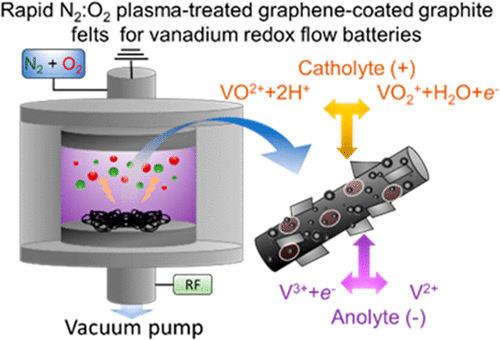
The development of high-power density vanadium redox flow batteries (VRFBs) with high energy efficiencies (EEs) is crucial for the widespread dissemination of this energy storage technology. In this work, we report the production of novel hierarchical carbonaceous nanomaterials for VRFB electrodes with high catalytic activity toward the vanadium redox reactions (VO2+/VO2+ and V2+/V3+). The electrode materials are produced through a rapid (minute timescale) low-pressure combined gas plasma treatment of graphite felts (GFs) in an inductively coupled radio frequency reactor. By systematically studying the effects of either pure gases (O2 and N2) or their combination at different gas plasma pressures, the electrodes are optimized to reduce their kinetic polarization for the VRFB redox reactions. To further enhance the catalytic surface area of the electrodes, single-/few-layer graphene, produced by highly scalable wet-jet milling exfoliation of graphite, is incorporated into the GFs through an infiltration method in the presence of a polymeric binder. Depending on the thickness of the proton-exchange membrane (Nafion 115 or Nafion XL), our optimized VRFB configurations can efficiently operate within a wide range of charge/discharge current densities, exhibiting energy efficiencies up to 93.9%, 90.8%, 88.3%, 85.6%, 77.6%, and 69.5% at 25, 50, 75, 100, 200, and 300 mA cm–2, respectively. Our technology is cost-competitive when compared to commercial ones (additional electrode costs < 100 € m–2) and shows EEs rivalling the record-high values reported for efficient systems to date. Our work remarks on the importance to study modified plasma conditions or plasma methods alternative to those reported previously (e.g., atmospheric plasmas) to improve further the electrode performances of the current VRFB systems.
Multiscale Modeling Strategy of 2D Covalent Organic Frameworks Confined at an Air–Water Interface
A. Ortega-Guerrero, H. Sahabudeen, A. Croy, A. Dianat, R. Dong, X. Feng, G. Cuniberti
ACS Appl. Mater. Interfaces, 2021, 13, 26411–26420. Link to article and accepted manuscript (open access).
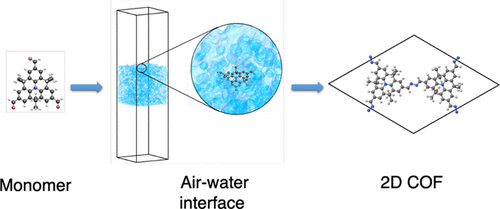
Two-dimensional covalent organic frameworks (2D COFs) have attracted attention as versatile active materials in many applications. Recent advances have demonstrated the synthesis of monolayer 2D COF via an air–water interface. However, the interfacial 2D polymerization mechanism has been elusive. In this work, we have used a multiscale modeling strategy to study dimethylmethylene-bridged triphenylamine building blocks confined at the air–water interface to form a 2D COF via Schiff-base reaction. A synergy between the computational investigations and experiments allowed the synthesis of a 2D-COF with one of the linkers considered. Our simulations complement the experimental characterization and show the preference of the building blocks to be at the interface with a favorable orientation for the polymerization. The air–water interface is shown to be a key factor to stabilize a flat conformation when a dimer molecule is considered. The structural and electronic properties of the monolayer COFs based on the two monomers are calculated and show a semiconducting nature with direct bandgaps. Our strategy provides a first step toward the in silico polymerization of 2D COFs at air–water interfaces capturing the initial steps of the synthesis up to the prediction of electronic properties of the 2D material.
Surface-Modified Phthalocyanine-Based Two-Dimensional Conjugated Metal–Organic Framework Films for Polarity-Selective Chemiresistive Sensing
M. Wang, Z. Zhang, H. Zhong, X. Huang, W. Li, M. Hambsch, P. Zhang, Z. Wang, P. St. Petkov, T. Heine, S. C. B. Mannsfeld, X. Feng, R. Dong
Angew. Chem. Int. Ed., 2021, 60, 18666–18672. Link to article (open access). Selected as a Hot Paper. Featured in Hot Topic: Surfaces and Interfaces and Metal-Organic Frameworks: Special Collection 2020.

2D conjugated metal–organic frameworks (2D c-MOFs) are emerging as electroactive materials for chemiresistive sensors, but selective sensing with fast response/recovery is a challenge. Phthalocyanine-based Ni2[MPc(NH)8] 2D c-MOF films are presented as active layers for polarity-selective chemiresisitors toward water and volatile organic compounds (VOCs). Surface-hydrophobic modification by grafting aliphatic alkyl chains on 2D c-MOF films decreases diffused analytes into the MOF backbone, resulting in a considerably accelerated recovery progress (from ca. 50 to ca. 10 s) during humidity sensing. Toward VOCs, the sensors deliver a polarity-selective response among alcohols but no signal for low-polarity aprotic hydrocarbons. The octadecyltrimethoxysilane-modified Ni2[MPc(NH)8] based sensor displays high-performance methanol sensing with fast response (36 s)/recovery (13 s) and a detection limit as low as 10 ppm, surpassing reported room-temperature chemiresistors.
Low-Temperature Graphene-Based Paste for Large-Area Carbon Perovskite Solar Cells
P. Mariani, L. Najafi, G. Bianca, M. I. Zappia, L. Gabatel, A. Agresti, S. Pescetelli, A. Di Carlo, S. Bellani, F. Bonaccorso
ACS Appl. Mater. Interfaces, 2021, 13, 22368–22380. Link to article (open access).
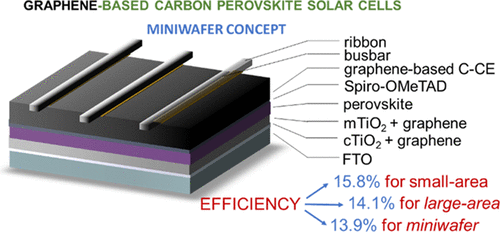
Carbon perovskite solar cells (C-PSCs), using carbon-based counter electrodes (C-CEs), promise to mitigate instability issues while providing solution-processed and low-cost device configurations. In this work, we report the fabrication and characterization of efficient paintable C-PSCs obtained by depositing a low-temperature-processed graphene-based carbon paste atop prototypical mesoscopic and planar n–i–p structures. Small-area (0.09 cm2) mesoscopic C-PSCs reach a power conversion efficiency (PCE) of 15.81% while showing an improved thermal stability under the ISOS-D-2 protocol compared to the reference devices based on Au CEs. The proposed graphene-based C-CEs are applied to large-area (1 cm2) mesoscopic devices and low-temperature-processed planar n–i–p devices, reaching PCEs of 13.85 and 14.06%, respectively. To the best of our knowledge, these PCE values are among the highest reported for large-area C-PSCs in the absence of back-contact metallization or additional stacked conductive components or a thermally evaporated barrier layer between the charge-transporting layer and the C-CE (strategies commonly used for the record-high efficiency C-PSCs). In addition, we report a proof-of-concept of metallized miniwafer-like area C-PSCs (substrate area = 6.76 cm2, aperture area = 4.00 cm2), reaching a PCE on active area of 13.86% and a record-high PCE on aperture area of 12.10%, proving the metallization compatibility with our C-PSCs. Monolithic wafer-like area C-PSCs can be feasible all-solution-processed configurations, more reliable than prototypical perovskite solar (mini)modules based on the serial connection of subcells, since they mitigate hysteresis-induced performance losses and hot-spot-induced irreversible material damage caused by reverse biases.
Synthetic tuning of the quantum properties of open-shell radicaloids
F. Lombardi, J. Ma, D. I. Alexandropoulos, H. Komber, J. Liu, W. K. Myers, X. Feng, L. Bogani
Chem, 2021, 7, 1363–1378. Link to article and accepted manuscript (open access). TUD press release.

Open-shell molecular radicaloids could constitute the key to molecular quantum information and quantum sensing technologies. The effect of their morphology on the quantum properties is anyway unknown, hampering the development of synthetic strategies. Herein, we establish the links between morphology and quantum properties, using three related radicaloids based on meta-quinodimethane. We unravel the roles of the π-conjugated backbone and those of the side groups on the spin-flip and quantum coherence times. The temperature regions are identified where different structural parts of the molecule or solvent become the dominant decoherence channel. The record quantum coherence values obtained at room temperature are still well below the intrinsic limits of radicaloids, and we discuss the directions to optimize the quantum performance.
Inverted perovskite solar cells with enhanced lifetime and thermal stability enabled by a metallic tantalum disulfide buffer layer
K. Chatzimanolis, K. Rogdakis, D. Tsikritzis, N. Tzoganakis, M. Tountas, M. Krassas, S. Bellani, L. Najafi, B. Martín-García, R. Oropesa-Nuñez, M. Prato, G. Bianca, I. Plutnarova, Z. Sofer, F. Bonaccorso, E. Kymakis
Nanoscale Adv., 2021, 3, 3124–3135. Link to article (open access).
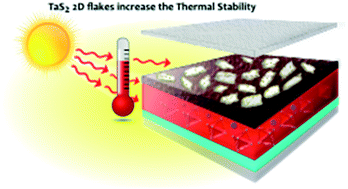
Perovskite solar cells (PSCs) have proved their potential for delivering high power conversion efficiencies (PCE) alongside low fabrication cost and high versatility. The stability and the PCE of PSCs can readily be improved by implementing engineering approaches that entail the incorporation of two-dimensional (2D) materials across the device's layered configuration. In this work, two-dimensional (2D) 6R-TaS2 flakes were exfoliated and incorporated as a buffer layer in inverted PSCs, enhancing the device's PCE, lifetime and thermal stability. A thin buffer layer of 6R-TaS2 flakes was formed on top of the electron transport layer to facilitate electron extraction, thus improving the overall device performance. The optimized devices reach a PCE of 18.45%, representing a 12% improvement compared to the reference cell. The lifetime stability measurements of the devices under ISOS-L2, ISOS-D1, ISOS-D1I and ISOS-D2I protocols revealed that the TaS2 buffer layer retards the intrinsic, thermally activated degradation processes of the PSCs. Notably, the devices retain more than the 80% of their initial PCE over 330 h under continuous 1 Sun illumination at 65 °C.
Vinylene-Linked Two-Dimensional Covalent Organic Frameworks: Synthesis and Functions
S. Xu, M. Richter X. Feng
Acc. Mater. Res., 2021, 2, 252–265. Link to article and accepted manuscript (open access). TUD press release.
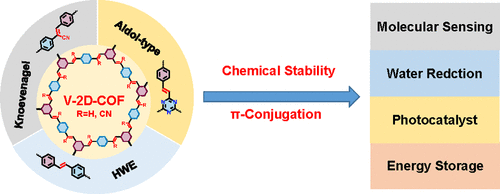
Two-dimensional covalent organic frameworks (2D COFs) with covalently bonded repeat units and crystalline, porous framework backbones have attracted immense attention since the first 2D COFs were reported by Yaghi’s group in 2005. The extended single-layer structures of 2D COFs are also generally considered to be the 2D polymers. The precise incorporation of molecular building blocks into ordered frameworks enables the synthesis of novel organic materials with designable and predictable properties for specific applications, such as in optoelectronics, energy storage, and conversion. In particular, the 2D π-conjugated COFs (2D-c-COFs) represent a unique class of 2D conjugated polymers that have 2D molecular-periodic structures with extended in-plane π-conjugations. In the 2D-c-COFs, the conjugated skeletons and π–π stacking interactions can provide the pathways for electron transport, while the porous channel can enable the loading of active sites for catalysis and sensing. Thus far, the synthesis of 2D-c-COFs has been mostly limited to Schiff base chemistry based on the condensation reaction between amine and aldehyde/ketone monomers because the construction of 2D COFs as thermodynamically controlled products generally requires a highly reversible reaction for error-correction processes. However, the high reversibility of imine linkages would conversely endow moderate π-electron delocalization due to the polarized carbon–nitrogen bonds and poor stability against strong acids/bases.
To achieve robust and highly conjugated 2D-c-COFs, a series of synthesis strategies have been developed, including a one-step reversible reaction with a bond-forming–bond braking–bond reforming function, a quasi-reversible reaction combing reversible and irreversible processes, and postmodifications converting labile bonds to a robust linkage. Among all of the reported 2D-c-COFs, vinylene-linked (also sp2-carbon-linked) 2D covalent organic frameworks (V-2D-COFs) with high in-plane π-conjugation have attracted increasing interest after we reported the first V-2D-COFs via a Knoevenagel polycondensation in 2016. Although C═C bonds have low reversibility, making the synthesis of V-2D-COFs quite challenging, there have been around 40 V-2D-COFs reported over the past 5 years, which demonstrated the merits of V-2D-COFs combining with unique optoelectronic, redox, and magnetic properties.
In this Account, we will summarize the development of V-2D-COFs, covering the important aspects of synthesis methods, design strategies, unique physical properties, and functions. First, the solvothermal synthesis of V-2D-COFs using different reaction methodologies and design principles will be presented, including Knoevenagel polycondensation, other aldol-type polycondensations, and Horner–Wadsworth–Emmons (HWE) polycondensation. Second, we will discuss the optoelectronic and magnetic properties of V-2D-COFs. Finally, the promising applications of V-2D-COF in the fields of sensing, photocatalysis, energy storage, and conversion will be demonstrated, which benefit from their robust vinylene-linked skeleton, full in-plane π-conjugation, and tailorable structures. We anticipate that this Account will provide an intensive understanding of the synthesis of V-2D-COFs and inspire the further development of this emerging class of conjugated organic crystalline materials with unique physicochemical properties and applications across different areas.
Sulfur-Doped Nanographenes Containing Multiple Subhelicenes
W. Niu, Y. Fu, H. Komber, J. Ma, X. Feng, Y. Mai, J. Liu
Org. Lett., 2021, 23, 2069–2073. Link to article and accepted manuscript (open access).
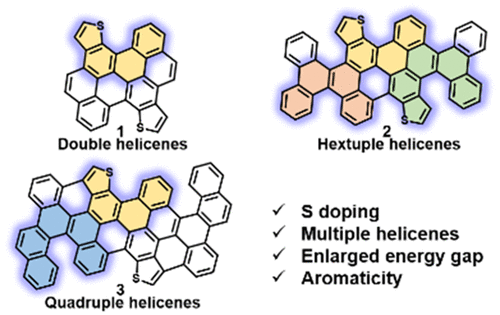
In this work, we describe the synthesis and characterization of three novel sulfur-doped nanographenes (NGs) (1–3) containing multiple subhelicenes, including carbo[4]helicenes, thieno[4]helicenes, carbo[5]helicenes, and thieno[5]helicenes. Density functional theory calculations reveal that the helicene substructures in 1–3 possess dihedral angles from 15° to 34°. The optical energy gaps of 1–3 are estimated to be 2.67, 2.45, and 2.30 eV, respectively. These three sulfur-doped NGs show enlarged energy gaps compared to those of their pristine carbon analogues.
Two‐Step Thermal Annealing: An Effective Route for 15 % Efficient Quasi‐2D Perovskite Solar Cells
V. Romano, L. Najafi, A. A. Sutanto, G. Schileo, V. Queloz, S. Bellani, M. Prato, S. Marras, M. K. Nazeeruddin, G. D’Angelo, F. Bonaccorso, G. Grancini
ChemPlusChem, 2021, 86, 1044–1048. Link to article and accepted manuscript (open access). COVER PAGE. Cover Profile. Featured in Hot Topic: Solar Cells, Perovskite Materials and Devices, Society Volumes: Italy and Society Volumes: Switzerland.

Low-dimensional perovskites (LDP) are nowadays recognized as promising materials for the realization of highly performing photovoltaic cells. However, issues related to film morphology, composition, crystal quality and material homogeneity limit the device performances and reproducibility. In this work, we implement a robust method for the deposition of a LDP mixing methylammonium (MA) and phenylethylammonium (PEA) cations to create the mixed system (PEA)2MA39Pb40I121 by using a two-step thermal annealing treatment (at 60 and 100 °C). Our approach results in LDP films with high crystal quality and enhanced carrier lifetime, which double the power conversion efficiency of reference devices, reaching up to 15 %.
Chemical Conversion and Locking of the Imine Linkage: Enhancing the Functionality of Covalent Organic Frameworks
L. Cusin, H. Peng, A. Ciesielski, P. Samorì
Angew. Chem. Int. Ed., 2021, 60, 14236–14250. Link to article and accepted manuscript (open access).

Imine-based covalent organic frameworks (COFs) are a widely studied class of functional, crystalline, and porous nanostructures which combine a relatively facile crystallization with tuneable compositions and porosities. However, the imine linkage constitutes an intrinsic limitation due to its reduced stability in harsh chemical conditions and its unsuitability for in-plane π-conjugation in COFs. Urgent solutions are therefore required in order to exploit the full potential of these materials, thereby enabling their technological application in electronics, sensing, and energy storage devices. In this context, the advent of a new generation of linkages derived from the chemical conversion and locking of the imine bond represents a cornerstone for the synthesis of new COFs. A marked increase in the framework robustness is in fact often combined with the incorporation of novel functionalities including, for some of these reactions, an extension of the in-plane π-conjugation. This Minireview describes the most enlightening examples of one-pot reactions and post-synthetic modifications towards the chemical locking of the imine bond in COFs.
Functionalized metallic transition metal dichalcogenide (TaS2) for nanocomposite membranes in direct methanol fuel cells
H. Beydaghi, L. Najafi, S. Bellani, A. Bagheri, B. Martín-García, P. Salarizadeh, K. Hooshyari, S. Naderizadeh, M. Serri, L. Pasquale, B. Wu, R. Oropesa-Nuñez, Z. Sofer, V. Pellegrini, F. Bonaccorso
J. Mater. Chem. A, 2021, 9, 6368–6381. Link to article and accepted manuscript (open access).
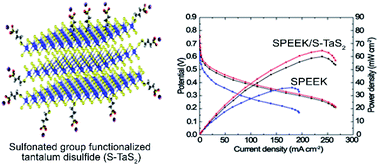
In this work, we designed a novel nanocomposite proton-exchange membrane (PEM) based on sulfonated poly(ether ether ketone) (SPEEK) and tantalum disulfide functionalized with terminal sulfonate groups (S-TaS2). The PEMs are prepared through a solution-casting method and exploited in direct methanol fuel cells (DMFCs). Two-dimensional S-TaS2 nanoflakes were prepared as a functional additive to produce the novel nanocomposite membrane for DMFCs due to their potential as a fuel barrier and an excellent proton conductor. To optimize the degree of sulfonation (DS) of SPEEK and the weight percentage (wt%) of S-TaS2 nanoflakes in PEMs, we used the central composite design of the response surface method. The optimum PEM was obtained for SPEEK DS of 1.9% and a weight fraction (wt%) of S-TaS2 nanoflakes of 70.2%. The optimized membrane shows a water uptake of 45.72%, a membrane swelling of 9.64%, a proton conductivity of 96.24 mS cm−1, a methanol permeability of 2.66 × 10−7 cm2 s−1, and a selectivity of 36.18 × 104 S s cm−3. Moreover, SPEEK/S-TaS2 membranes show superior thermal and chemical stabilities compared to those of pristine SPEEK. The DMFC fabricated with the SPEEK/S-TaS2 membrane has reached the maximum power densities of 64.55 mW cm−2 and 161.18 mW cm−2 at 30 °C and 80 °C, respectively, which are ∼78% higher than the values obtained with the pristine SPEEK membrane. Our results demonstrate that SPEEK/S-TaS2 membranes have a great potential for DMFC applications.
Two-dimensional conjugated metal–organic frameworks (2D c-MOFs): chemistry and function for MOFtronics
M. Wang, R. Dong, X. Feng
Chem. Soc. Rev., 2021, 50, 2764–2793. Link to article (open access).
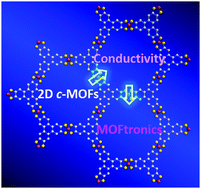 The 21st century has seen a reinvention of how modern electronics impact our daily lives; silicon-electronics and organic electronics are currently at the core of modern electronics. Recent advances have demonstrated that conductive metal–organic frameworks (MOFs), as another unique class of electronic materials, are emerging to provide additional possibility for multifunctional electronic devices that brings us “MOFtronics”. Typically, two-dimensional conjugated MOFs (2D c-MOFs) are a novel class of layer-stacked MOFs with in-plane extended π-conjugation that exhibit unique properties such as intrinsic porosity, crystallinity, stability, and electrical conductivity as well as tailorable band gaps. Benefiting from their unique features and high conductivity, 2D c-MOFs have displayed great potential for multiple high-performance (opto)electronic, magnetic, and energy devices. In this review article, we introduce the chemical and synthetic methodologies of 2D c-MOFs, intrinsic influences on their electronic structures and charge transport properties, as well as multifunctional applications of this class of materials for MOFtronics and potential power sources for MOFtronics. We highlight the benefits and limitations of thus-far developed 2D c-MOFs from synthesis to function and offer our perspectives in regard to the challenges to be addressed.
The 21st century has seen a reinvention of how modern electronics impact our daily lives; silicon-electronics and organic electronics are currently at the core of modern electronics. Recent advances have demonstrated that conductive metal–organic frameworks (MOFs), as another unique class of electronic materials, are emerging to provide additional possibility for multifunctional electronic devices that brings us “MOFtronics”. Typically, two-dimensional conjugated MOFs (2D c-MOFs) are a novel class of layer-stacked MOFs with in-plane extended π-conjugation that exhibit unique properties such as intrinsic porosity, crystallinity, stability, and electrical conductivity as well as tailorable band gaps. Benefiting from their unique features and high conductivity, 2D c-MOFs have displayed great potential for multiple high-performance (opto)electronic, magnetic, and energy devices. In this review article, we introduce the chemical and synthetic methodologies of 2D c-MOFs, intrinsic influences on their electronic structures and charge transport properties, as well as multifunctional applications of this class of materials for MOFtronics and potential power sources for MOFtronics. We highlight the benefits and limitations of thus-far developed 2D c-MOFs from synthesis to function and offer our perspectives in regard to the challenges to be addressed.
Predicting the bulk modulus of single-layer covalent organic frameworks with square-lattice topology from molecular building-block properties
A. Raptakis, A. Dianat, A. Croy, G. Cuniberti
Nanoscale, 2021, 13, 1077–1085. Link to article (open access).
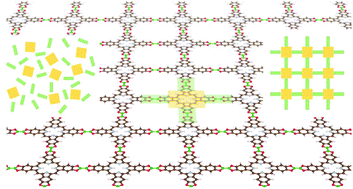
Two-dimensional Covalent Organic Frameworks (2D COFs) have attracted a lot of interest because of their potential for a broad range of applications. Different combinations of their molecular building blocks can lead to new materials with different physical and chemical properties. In this study, the elasticity of different single-layer tetrabenzoporphyrin (H2-TBPor) and phthalocyanine (H2-Pc) based 2D COFs is numerically investigated using a density-functional based tight-binding approach. Specifically, we calculate the 2D bulk modulus and the equivalent spring constants of the respective molecular building-blocks. Using a spring network model we are able to predict the 2D bulk modulus based on the properties of the isolated molecules. This provides a path to optimize elastic properties of 2D COFs.
High-Mobility Semiconducting Two-Dimensional Conjugated Covalent Organic Frameworks with p-Type Doping
M. Wang, M. Wang, H.-H. Lin, M. Ballabio, H. Zhong, M. Bonn, S. Zhou, T. Heine, E. Cánovas, R. Dong, X. Feng
J. Am. Chem. Soc., 2020, 142, 21622–21627. Link to article and accepted manuscript (open access). TUD press release.
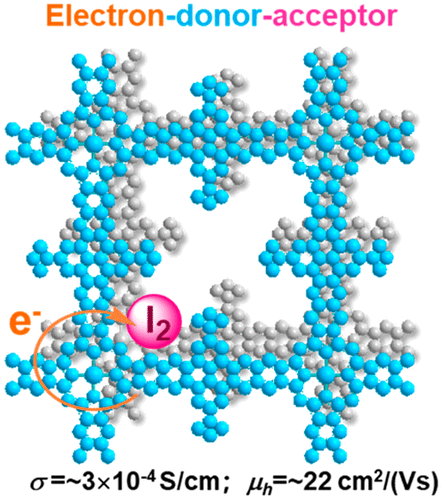
Two-dimensional conjugated covalent organic frameworks (2D c-COFs) are emerging as a unique class of semiconducting 2D conjugated polymers for (opto)electronics and energy storage. Doping is one of the common, reliable strategies to control the charge carrier transport properties, but the precise mechanism underlying COF doping has remained largely unexplored. Here we demonstrate molecular iodine doping of a metal–phthalocyanine-based pyrazine-linked 2D c-COF. The resultant 2D c-COF ZnPc-pz-I2 maintains its structural integrity and displays enhanced conductivity by 3 orders of magnitude, which is the result of elevated carrier concentrations. Remarkably, Hall effect measurements reveal enhanced carrier mobility reaching ∼22 cm2 V–1 s–1 for ZnPc-pz-I2, which represents a record value for 2D c-COFs in both the direct-current and alternating-current limits. This unique transport phenomenon with largely increased mobility upon doping can be traced to increased scattering time for free charge carriers, indicating that scattering mechanisms limiting the mobility are mitigated by doping. Our work provides a guideline on how to assess doping effects in COFs and highlights the potential of 2D c-COFs to display high conductivities and mobilities toward novel (opto)electronic devices.
Microwave‐Induced Structural Engineering and Pt Trapping in 6R‐TaS2 for the Hydrogen Evolution Reaction
L. Najafi, S. Bellani, R. Oropesa‐Nuñez, R. Brescia, M. Prato, L. Pasquale, C. Demirci, F. Drago, B. Martín‐García, J. Luxa, L. Manna, Z. Sofer, F. Bonaccorso
Small, 2020, 16, 2003372. Link to article (open access). Featured in Hot Topic: Water Splitting.

The nanoengineering of the structure of transition metal dichalcogenides (TMDs) is widely pursued to develop viable catalysts for the hydrogen evolution reaction (HER) alternative to the precious metallic ones. Metallic group‐5 TMDs have been demonstrated to be effective catalysts for the HER in acidic media, making affordable real proton exchange membrane water electrolysers. Their key‐plus relies on the fact that both their basal planes and edges are catalytically active for the HER. In this work, the 6R phase of TaS2 is “rediscovered” and engineered. A liquid‐phase microwave treatment is used to modify the structural properties of the 6R‐TaS2 nanoflakes produced by liquid‐phase exfoliation. The fragmentation of the nanoflakes and their evolution from monocrystalline to partly polycrystalline structures improve the HER‐activity, lowering the overpotential at cathodic current of 10 mA cm−2 from 0.377 to 0.119 V. Furthermore, 6R‐TaS2 nanoflakes act as ideal support to firmly trap Pt species, which achieve a mass activity (MA) up 10 000 A gPt−1 at overpotential of 50 mV (20 000 A gPt−1 at overpotentials of 72 mV), representing a 20‐fold increase of the MA of Pt measured for the Pt/C reference, and approaching the state‐of‐the‐art of the Pt mass activity.
Thiophene‐Bridged Donor–Acceptor sp2‐Carbon‐Linked 2D Conjugated Polymers as Photocathodes for Water Reduction
S. Xu, H. Sun, M. Addicoat, B. P. Biswal, F. He, S. Park, S. Paasch, T. Zhang, W. Sheng, E. Brunner, Y. Hou, M. Richter, X. Feng
Adv. Mater., 2021, 33, 2006274. Link to article (open access). TUD press release.
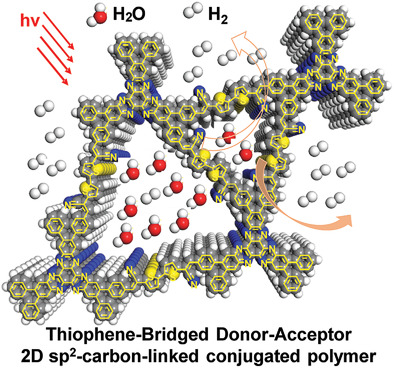 Photoelectrochemical (PEC) water reduction, converting solar energy into environmentally friendly hydrogen fuel, requires delicate design and synthesis of semiconductors with appropriate bandgaps, suitable energy levels of the frontier orbitals, and high intrinsic charge mobility. In this work, the synthesis of a novel bithiophene‐bridged donor–acceptor‐based 2D sp2‐carbon‐linked conjugated polymer (2D CCP) is demonstrated. The Knoevenagel polymerization between the electron‐accepting building block 2,3,8,9,14,15‐hexa(4‐formylphenyl) diquinoxalino[2,3‐a:2′,3′‐c]phenazine (HATN‐6CHO) and the first electron‐donating linker 2,2′‐([2,2′‐bithiophene]‐5,5′‐diyl)diacetonitrile (ThDAN) provides the 2D CCP‐HATNThDAN (2D CCP‐Th). Compared with the corresponding biphenyl‐bridged 2D CCP‐HATN‐BDAN (2D CCP‐BD), the bithiophene‐based 2D CCP‐Th exhibits a wide light‐harvesting range (up to 674 nm), a optical energy gap (2.04 eV), and highest energy occupied molecular orbital–lowest unoccupied molecular orbital distributions for facilitated charge transfer, which make 2D CCP‐Th a promising candidate for PEC water reduction. As a result, 2D CCP‐Th presents a superb H2‐evolution photocurrent density up to ≈7.9 µA cm−2 at 0 V versus reversible hydrogen electrode, which is superior to the reported 2D covalent organic frameworks and most carbon nitride materials (0.09–6.0 µA cm−2). Density functional theory calculations identify the thiophene units and cyano substituents at the vinylene linkage as active sites for the evolution of H2.
Photoelectrochemical (PEC) water reduction, converting solar energy into environmentally friendly hydrogen fuel, requires delicate design and synthesis of semiconductors with appropriate bandgaps, suitable energy levels of the frontier orbitals, and high intrinsic charge mobility. In this work, the synthesis of a novel bithiophene‐bridged donor–acceptor‐based 2D sp2‐carbon‐linked conjugated polymer (2D CCP) is demonstrated. The Knoevenagel polymerization between the electron‐accepting building block 2,3,8,9,14,15‐hexa(4‐formylphenyl) diquinoxalino[2,3‐a:2′,3′‐c]phenazine (HATN‐6CHO) and the first electron‐donating linker 2,2′‐([2,2′‐bithiophene]‐5,5′‐diyl)diacetonitrile (ThDAN) provides the 2D CCP‐HATNThDAN (2D CCP‐Th). Compared with the corresponding biphenyl‐bridged 2D CCP‐HATN‐BDAN (2D CCP‐BD), the bithiophene‐based 2D CCP‐Th exhibits a wide light‐harvesting range (up to 674 nm), a optical energy gap (2.04 eV), and highest energy occupied molecular orbital–lowest unoccupied molecular orbital distributions for facilitated charge transfer, which make 2D CCP‐Th a promising candidate for PEC water reduction. As a result, 2D CCP‐Th presents a superb H2‐evolution photocurrent density up to ≈7.9 µA cm−2 at 0 V versus reversible hydrogen electrode, which is superior to the reported 2D covalent organic frameworks and most carbon nitride materials (0.09–6.0 µA cm−2). Density functional theory calculations identify the thiophene units and cyano substituents at the vinylene linkage as active sites for the evolution of H2.
Hybrid Organic/Inorganic Photocathodes Based on WS2 Flakes as Hole Transporting Layer Material
L. Najafi, V. Romano, R. Oropesa-Nuñez, M. Prato, S. Lauciello, G. D’Angelo, S. Bellani, F. Bonaccorso
Small Struct., 2021, 2, 2000098. Link to article (open access).

The efficient production of molecular hydrogen (H2) is a fundamental step toward an environmentally friendly economy. Photocathodes using organic bulk heterojunction (BHJ) films as light harvesters represent an attracting technology for low-cost photoelectrochemical water splitting. These photocathodes need charge transporting layers (CTLs) to efficiently separate and transport either holes or electrons toward the back-current collector and electrolyte, respectively. Therefore, it is pivotal to control the energy band edge levels and the work function (WF) of the CTLs to match the ones of the BHJ film, current collector, and electrolyte. Herein, the use of 2D p-doped WS2 flakes as hole transporting material for H2-evolving photocathodes based on the regioregular poly(3-hexylthiophene):phenyl-C61-butyric acid methyl ester (rr-P3HT:PCBM) BHJ film is proposed. The WS2 flakes are produced through scalable liquid-phase exfoliation of the bulk crystal, whereas p-type chemical doping allows the tuning of the WS2 WF. This approach boosts the performances of the photocathodes, reaching photocurrent densities up to 4.14 mA cm−2 at 0 V versus reversible hydrogen electrode (RHE), an onset potential of 0.66 V versus RHE, and a ratiometric power-saved metric of 1.28% (under 1 sun illumination). To the best of the authors' knowledge, these performances represent the current record for 2D materials-based CTLs.
One‐Pot Synthesis of Boron‐Doped Polycyclic Aromatic Hydrocarbons via 1,4‐Boron Migration
J.-J. Zhang, M.-C. Tang, Y. Fu, K.-H. Low, J. Ma, L. Yang, J. J. Weigand, J. Liu, V. W.-W. Yam, X. Feng
Angew. Chem. Int. Ed., 2021, 60, 2833–2838. Link to article (open access). Featured in Hot Topic: Organic Electronics. TUD press release.

Herein, we demonstrate a novel one‐pot synthetic method towards a series of boron‐doped polycyclic aromatic hydrocarbons (B‐PAHs, 1 a–1 o), including hitherto unknown B‐doped zethrene derivatives, from ortho‐aryl substituted diarylalkynes with high atom efficiency and broad substrate scopes. A reaction mechanism is proposed based on the experimental investigation together with the theoretical calculations, which involves a unique 1,4‐boron migration process. The resultant benchtop‐stable B‐PAHs are thoroughly investigated by X‐ray crystallography, cyclic voltammetry, UV/Vis absorption, and fluorescence spectroscopies. The blue and green organic light‐emitting diode (OLED) devices based on 1 f and 1 k are further fabricated, demonstrating the promising application potential of B‐PAHs in organic optoelectronics.
A Curved Graphene Nanoribbon with Multi-Edge Structure and High Intrinsic Charge Carrier Mobility
W. Niu, J. Ma, P. Soltani, W. Zheng, F. Liu, A. A. Popov, J. J. Weigand, H. Komber, E. Poliani, C. Casiraghi, J. Droste, M. R. Hansen, S. Osella, D. Beljonne, M. Bonn, H. I. Wang, X. Feng, J. Liu, Y. Mai
J. Am. Chem. Soc., 2020, 142, 18293–18298. Link to article and accepted manuscript (open access). TUD press release.
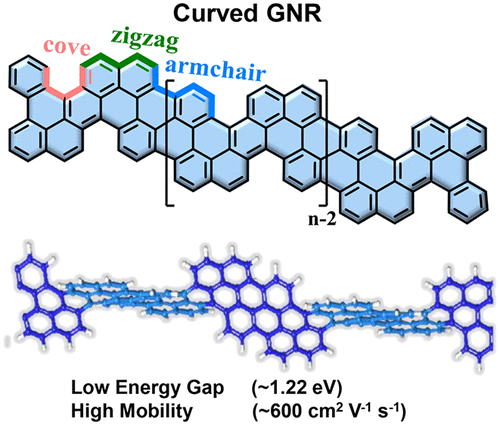
Structurally well-defined graphene nanoribbons (GNRs) have emerged as highly promising materials for the next-generation nanoelectronics. The electronic properties of GNRs critically depend on their edge topologies. Here, we demonstrate the efficient synthesis of a curved GNR (cGNR) with a combined cove, zigzag, and armchair edge structure, through bottom-up synthesis. The curvature of the cGNR is elucidated by the corresponding model compounds tetrabenzo[a,cd,j,lm]perylene (1) and diphenanthrene-fused tetrabenzo[a,cd,j,lm]perylene (2), the structures of which are unambiguously confirmed by the X-ray single-crystal analysis. The resultant multi-edged cGNR exhibits a well-resolved absorption at the near-infrared (NIR) region with a maximum peak at 850 nm, corresponding to a narrow optical energy gap of ∼1.22 eV. Employing THz spectroscopy, we disclose a long scattering time of ∼60 fs, corresponding to a record intrinsic charge carrier mobility of ∼600 cm2 V–1 s–1 for photogenerated charge carriers in cGNR.
Liquid-Phase Exfoliated GeSe Nanoflakes for Photoelectrochemical-Type Photodetectors and Photoelectrochemical Water Splitting
G. Bianca, M. I. Zappia, S. Bellani, Z. Sofer, M. Serri, L. Najafi, R. Oropesa-Nuñez, B. Martín-García, T. Hartman, L. Leoncino, D. Sedmidubský, V. Pellegrini, G. Chiarello, F. Bonaccorso
ACS Appl. Mater. Interfaces, 2020, 12, 48598–48613. Link to article (open access).
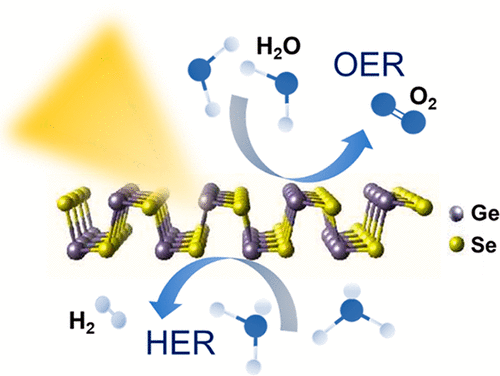
Photoelectrochemical (PEC) systems represent powerful tools to convert electromagnetic radiation into chemical fuels and electricity. In this context, two-dimensional (2D) materials are attracting enormous interest as potential advanced photo(electro)catalysts and, recently, 2D group-IVA metal monochalcogenides have been theoretically predicted to be water splitting photocatalysts. In this work, we use density functional theory calculations to theoretically investigate the photocatalytic activity of single-/few-layer GeSe nanoflakes for both the hydrogen evolution reaction (HER) and the oxygen evolution reaction (OER) in pH conditions ranging from 0 to 14. Our simulations show that GeSe nanoflakes with different thickness can be mixed in the form of nanoporous films to act as nanoscale tandem systems, in which the flakes, depending on their thickness, can operate as HER- and/or OER photocatalysts. On the basis of theoretical predictions, we report the first experimental characterization of the photo(electro)catalytic activity of single-/few-layer GeSe flakes in different aqueous media, ranging from acidic to alkaline solutions: 0.5 M H2SO4 (pH 0.3), 1 M KCl (pH 6.5), and 1 M KOH (pH 14). The films of the GeSe nanoflakes are fabricated by spray coating GeSe nanoflakes dispersion in 2-propanol obtained through liquid-phase exfoliation of synthesized orthorhombic (Pnma) GeSe bulk crystals. The PEC properties of the GeSe nanoflakes are used to design PEC-type photodetectors, reaching a responsivity of up to 0.32 AW–1 (external quantum efficiency of 86.3%) under 455 nm excitation wavelength in acidic electrolyte. The obtained performances are superior to those of several self-powered and low-voltage solution-processed photodetectors, approaching that of self-powered commercial UV–Vis photodetectors. The obtained results inspire the use of 2D GeSe in proof-of-concept water photoelectrolysis cells.
Synthesis of Vinylene‐Linked Two‐Dimensional Conjugated Polymers via the Horner–Wadsworth–Emmons Reaction
D. L. Pastoetter, S. Xu, M. Borrelli, M. Addicoat, B. P. Biswal, S. Paasch, A. Dianat, H. Thomas, R. Berger, S. Reineke, E. Brunner, G. Cuniberti, M. Richter, X. Feng
Angew. Chem. Int. Ed., 2020, 59, 23620–23625. Link to article (open access). Selected as a Hot Paper. TUD press release.

In this work, we demonstrate the first synthesis of vinylene‐linked 2D CPs, namely, 2D poly(phenylenequinoxalinevinylene)s 2D‐PPQV1 and 2D‐PPQV2, via the Horner–Wadsworth–Emmons (HWE) reaction of C2‐symmetric 1,4‐bis(diethylphosphonomethyl)benzene or 4,4′‐bis(diethylphosphonomethyl)biphenyl with C3‐symmetric 2,3,8,9,14,15‐hexa(4‐formylphenyl)diquinoxalino[2,3‐a:2′,3′‐c]phenazine as monomers. Density functional theory (DFT) simulations unveil the crucial role of the initial reversible C−C single bond formation for the synthesis of crystalline 2D CPs. Powder X‐ray diffraction (PXRD) studies and nitrogen adsorption‐desorption measurements demonstrate the formation of proclaimed crystalline, dual‐pore structures with surface areas of up to 440 m2 g−1. More importantly, the optoelectronic properties of the obtained 2D‐PPQV1 (Eg=2.2 eV) and 2D‐PPQV2 (Eg=2.2 eV) are compared with those of cyano‐vinylene‐linked 2D‐CN‐PPQV1 (Eg=2.4 eV) produced by the Knoevenagel reaction and imine‐linked 2D COF analog (2D‐C=N‐PPQV1, Eg=2.3 eV), unambiguously proving the superior conjugation of the vinylene‐linked 2D CPs using the HWE reaction.
Graphene transistors for real-time monitoring molecular self-assembly dynamics
M. Gobbi, A. Galanti, M.-A. Stoeckel, B. Zyska, S. Bonacchi, S. Hecht, P. Samorì
Nat. Commun., 2020, 11, 4731. Link to article (open access). UNISTRA, CNRS Alsace, ISIS and IRIS Adlershof press releases. Highlighted in Nature Research Device & Materials Engineering Community.

Mastering the dynamics of molecular assembly on surfaces enables the engineering of predictable structural motifs to bestow programmable properties upon target substrates. Yet, monitoring self-assembly in real time on technologically relevant interfaces between a substrate and a solution is challenging, due to experimental complexity of disentangling interfacial from bulk phenomena. Here, we show that graphene devices can be used as highly sensitive detectors to read out the dynamics of molecular self-assembly at the solid/liquid interface in-situ. Irradiation of a photochromic molecule is used to trigger the formation of a metastable self-assembled adlayer on graphene and the dynamics of this process are monitored by tracking the current in the device over time. In perspective, the electrical readout in graphene devices is a diagnostic and highly sensitive means to resolve molecular ensemble dynamics occurring down to the nanosecond time scale, thereby providing a practical and powerful tool to investigate molecular self-organization in 2D.
Scalable spray-coated graphene-based electrodes for high-power electrochemical double-layer capacitors operating over a wide range of temperature
M. A. Garakani, S. Bellani, V. Pellegrini, R. Oropesa-Nuñez, A. E. Del Rio Castillo, S. Abouali, L. Najafi, B. Martín-García, A. Ansaldo, P. Bondavalli, C. Demirci, V. Romano, E. Mantero, L. Marasco, M. Prato, G. Bracciale, F. Bonaccorso
Energy Storage Mater., 2021, 34, 1–11. Link to article (open access).

Advancements in electrochemical double-layer capacitor (EDLC) technology require the concomitant use of novel efficient electrode materials and viable electrode manufacturing methods. Cost-effectiveness, scalability and sustainability are key-drivers for fulfilling product development chain accepted by worldwide legislations. Herein, we report a scalable and sprayable “green” electrode material-based ink based on activated carbon and single-/few-layer graphene (SLG/FLG) flakes. We show that, contrary to commercial reduced graphene oxide, defect-free and flat SLG/FLG flakes reduce the friction of ions over the electrode films, while spray coating deposition of our ink maximises the electrolyte accessibility to the electrode surface area. Sprayed SLG/FLG flakes-based EDLCs display superior rate capability performance (e.g., specific energies of 31.5, 23.7 and 12.5 Wh kg−1 at specific powers of 150, 7500 and 30000 W kg−1, respectively) compared to both SLG/FLG flakes-free devices and commercial-like EDLCs produced by slurry-coating method. The use of SLG/FLG flakes enables our sprayed EDLCs to operate in a wide range of temperature (−40/+100°C) compatible with ionic liquid/organic solvent-based electrolytes, overcoming the specific power limits of AC-based EDLCs. A prototype EDLCs stack consisting of multiple large-area EDLCs, each one displaying a capacitance of 25 F, demonstrates the industrial potential of our technology.
Luminescent sp2-Carbon-Linked 2D Conjugated Polymers with High Photostability
Y. Li, B. P. Biswal, M. A. Addicoat, S. Paasch, P. Imbrasas, S. Park, H. Shi, E. Brunner, M. Richter, S. Lenk, S. Reineke, X. Feng
Chem. Mater., 2020, 32, 7985–7991. Link to article and accepted manuscript (open access).
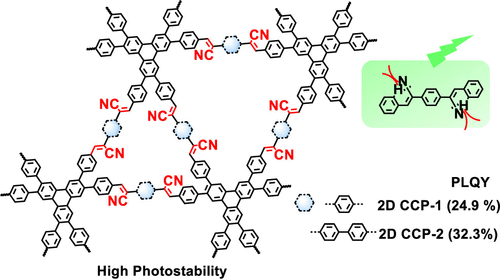
Luminescent organic materials with high photostability are essential in optoelectronics, sensor, and photocatalysis applications. However, small organic molecules are generally sensitive to UV irradiation, giving rise to chemical decompositions. In this work, we demonstrate two novel CN-substituted two-dimensional sp2-carbon-linked conjugated polymers (2D CCPs) containing a chromophore triphenylene unit. The Knoevenagel polymerization between 2,3,6,7,10,11-hexakis(4-formylphenyl)triphenylene (HFPTP) and 1,4-phenylenediacetonitrile (PDAN) or 2,2′-(biphenyl-4,4′-diyl)diacetonitrile (BDAN), provides the crystalline 2D CCP-HFPTP-PDAN (2D CCP-1) and 2D CCP-HFPTP-BDAN (2D CCP-2) with dual pore structures, respectively. 2D CCP-1 and 2D CCP-2 exhibit the photoluminescence quantum yield (PLQY) up to 24.9 and 32.3%, which are the highest values among the reported 2D conjugated polymers and π-conjugated 2D covalent organic frameworks. Furthermore, compared with the well-known emissive small molecule tetrakis(carbazol-9-yl)-4,6-dicyanobenzene (4CzIPN), both 2D CCPs show superior photostability under UV irradiation for 2 h, profiting from the twisted and rigid structures of the CN-substituted vinylene linkages. The present work will trigger the further explorations of novel organic emitters embedded in 2D CCPs with high PLQY and photostability, which can be useful for optoelectronic devices.
Role of Exchange Interactions in the Magnetic Response and Intermolecular Recognition of Chiral Molecules
A. Dianat, R. Gutierrez, H. Alpern, V. Mujica, A. Ziv, S. Yochelis, O. Millo, Y. Paltiel, G. Cuniberti
Nano Lett., 2020, 20, 7077–7086. Link to article and accepted manuscript (open access).

The physical origin of the so-called chirality-induced spin selectivity (CISS) effect has puzzled experimental and theoretical researchers over the past few years. Early experiments were interpreted in terms of unconventional spin–orbit interactions mediated by the helical geometry. However, more recent experimental studies have clearly revealed that electronic exchange interactions also play a key role in the magnetic response of chiral molecules in singlet states. In this investigation, we use spin-polarized closed-shell density functional theory calculations to address the influence of exchange contributions to the interaction between helical molecules as well as of helical molecules with magnetized substrates. We show that exchange effects result in differences in the interaction properties with magnetized surfaces, shedding light into the possible origin of two recent important experimental results: enantiomer separation and magnetic exchange force microscopy with AFM tips functionalized with helical peptides.
Synthesis of Robust MOFs@COFs Porous Hybrid Materials via an Aza‐Diels–Alder Reaction: Towards High‐Performance Supercapacitor Materials
H. Peng, J. Raya, F. Richard, W. Baaziz, O. Ersen, A. Ciesielski, P. Samorì
Angew. Chem. Int. Ed., 2020, 59, 19602–19609. Link to article and accepted manuscript (open access). Selected as a Very Important Paper. Featured in Special Issue: Functional Porous Materials Chemistry and Hot Topic: Batteries and Supercapacitors.
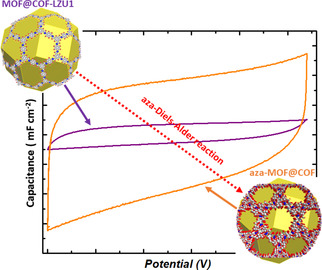
Metal–organic frameworks (MOFs) and covalent organic frameworks (COFs) have attracted enormous attention in recent years. Recently, MOF@COF are emerging as hybrid architectures combining the unique features of the individual components to enable the generation of materials displaying novel physicochemical properties. Herein we report an unprecedented use of aza‐Diels–Alder cycloaddition reaction as post‐synthetic modification of MOF@COF‐LZU1, to generate aza‐MOFs@COFs hybrid porous materials with extended π‐delocalization. A a proof‐of‐concept, the obtained aza‐MOFs@COFs is used as electrode in supercapacitors displaying specific capacitance of 20.35 μF cm−2 and high volumetric energy density of 1.16 F cm−3. Our approach of post‐synthetic modification of MOFs@COFs hybrids implement rational design for the synthesis of functional porous materials and expands the plethora of promising application of MOFs@COFs hybrid porous materials in energy storage applications.
On-surface synthesis of super-heptazethrene
S. Mishra, J. Melidonie, K. Eimre, S. Obermann, O. Gröning, C. A. Pignedoli, P. Ruffieux, X. Feng, R. Fasel
Chem. Commun., 2020, 56, 7467–7470. Link to article and accepted manuscript (open access).
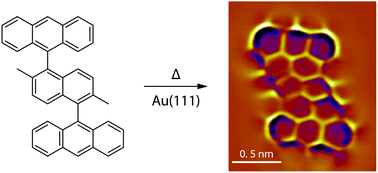
Zethrenes are model diradicaloids with potential applications in spintronics and optoelectronics. Despite a rich chemistry in solution, on-surface synthesis of zethrenes has never been demonstrated. We report the on-surface synthesis of super-heptazethrene on Au(111). Scanning tunneling spectroscopy investigations reveal that super-heptazethrene exhibits an exceedingly low HOMO–LUMO gap of 230 meV and, in contrast to its open-shell singlet ground state in the solution phase and in the solid-state, likely adopts a closed-shell ground state on Au(111).
Photomodulation of Charge Transport in All‐Semiconducting 2D–1D van der Waals Heterostructures with Suppressed Persistent Photoconductivity Effect
Z. Liu, H. Qiu, C. Wang, Z. Chen, B. Zyska, A. Narita, A. Ciesielski, S. Hecht, L. Chi, K. Müllen, P. Samorì
Adv. Mater., 2020, 32, 2001268. Link to article and accepted manuscript (open access). COVER PAGE. Featured in Hot Topic: Carbon, Graphite, and Graphene.
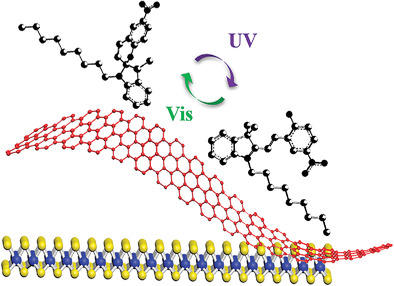
Van der Waals heterostructures (VDWHs), obtained via the controlled assembly of 2D atomically thin crystals, exhibit unique physicochemical properties, rendering them prototypical building blocks to explore new physics and for applications in optoelectronics. As the emerging alternatives to graphene, monolayer transition metal dichalcogenides and bottom‐up synthesized graphene nanoribbons (GNRs) are promising candidates for overcoming the shortcomings of graphene, such as the absence of a bandgap in its electronic structure, which is essential in optoelectronics. Herein, VDWHs comprising GNRs onto monolayer MoS2 are fabricated. Field‐effect transistors (FETs) based on such VDWHs show an efficient suppression of the persistent photoconductivity typical of MoS2, resulting from the interfacial charge transfer process. The MoS2‐GNR FETs exhibit drastically reduced hysteresis and more stable behavior in the transfer characteristics, which is a prerequisite for the further photomodulation of charge transport behavior within the MoS2‐GNR VDWHs. The physisorption of photochromic molecules onto the MoS2‐GNR VDWHs enables reversible light‐driven control over charge transport. In particular, the drain current of the MoS2‐GNR FET can be photomodulated by 52%, without displaying significant fatigue over at least 10 cycles. Moreover, four distinguishable output current levels can be achieved, demonstrating the great potential of MoS2‐GNR VDWHs for multilevel memory devices.
Ultrathin two-dimensional conjugated metal–organic framework single-crystalline nanosheets enabled by surfactant-assisted synthesis
Z. Wang, G. Wang, H. Qi, M. Wang, M. Wang, S. Park, H. Wang, M. Yu, U. Kaiser, A. Fery, S. Zhou, R. Dong, X. Feng
Chem. Sci., 2020, 11, 7665–7671. Link to article (open access).
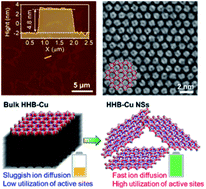
Two-dimensional conjugated metal–organic frameworks (2D c-MOFs) have recently emerged for potential applications in (opto-)electronics, chemiresistive sensing, and energy storage and conversion, due to their excellent electrical conductivity, abundant active sites, and intrinsic porous structures. However, developing ultrathin 2D c-MOF nanosheets (NSs) for facile solution processing and integration into devices remains a great challenge, mostly due to unscalable synthesis, low yield, limited lateral size and low crystallinity. Here, we report a surfactant-assisted solution synthesis toward ultrathin 2D c-MOF NSs, including HHB-Cu (HHB = hexahydroxybenzene), HHB-Ni and HHTP-Cu (HHTP = 2,3,6,7,10,11-hexahydroxytriphenylene). For the first time, we achieve single-crystalline HHB-Cu(Ni) NSs featured with a thickness of 4–5 nm (∼8–10 layers) and a lateral size of 0.25–0.65 μm2, as well as single-crystalline HHTP-Cu NSs with a thickness of ∼5.1 ± 2.6 nm (∼10 layers) and a lateral size of 0.002–0.02 μm2. Benefiting from the ultrathin feature, the synthetic NSs allow fast ion diffusion and high utilization of active sites. As a proof of concept, when serving as a cathode material for Li-ion storage, HHB-Cu NSs deliver a remarkable rate capability (charge within 3 min) and long-term cycling stability (90% capacity retention after 1000 cycles), superior to the corresponding bulk materials and other reported MOF cathodes.
Demonstration of a Broadband Photodetector Based on a Two‐Dimensional Metal–Organic Framework
H. Arora, R. Dong, T. Venanzi, J. Zscharschuch, H. Schneider, M. Helm, X. Feng, E. Cánovas, A. Erbe
Adv. Mater., 2020, 32, 1907063. Link to article (open access). COVER PAGE. cfaed, HZDR, EurekAlert!, NWA, Phys.org, ScienceDaily, Laser Focus World, Optics & Photonics News and PhotonicsViews press releases.
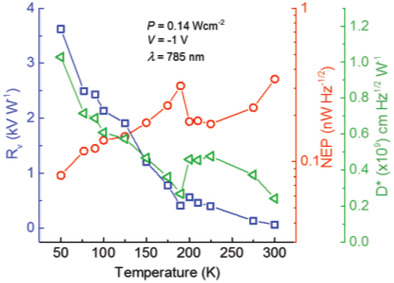
Metal–organic frameworks (MOFs) are emerging as an appealing class of highly tailorable electrically conducting materials with potential applications in optoelectronics. Yet, the realization of their proof‐of‐concept devices remains a daunting challenge, attributed to their poor electrical properties. Following recent work on a semiconducting Fe3(THT)2(NH4)3 (THT: 2,3,6,7,10,11‐triphenylenehexathiol) 2D MOF with record‐high mobility and band‐like charge transport, here, an Fe3(THT)2(NH4)3 MOF‐based photodetector operating in photoconductive mode capable of detecting a broad wavelength range from UV to NIR (400–1575 nm) is demonstrated. The narrow IR bandgap of the active layer (≈0.45 eV) constrains the performance of the photodetector at room temperature by band‐to‐band thermal excitation of charge carriers. At 77 K, the device performance is significantly improved; two orders of magnitude higher voltage responsivity, lower noise equivalent power, and higher specific detectivity of 7 × 108 cm Hz1/2 W−1 are achieved under 785 nm excitation. These figures of merit are retained over the analyzed spectral region (400–1575 nm) and are commensurate to those obtained with the first demonstrations of graphene‐ and black‐phosphorus‐based photodetectors. This work demonstrates the feasibility of integrating conjugated MOFs as an active element into broadband photodetectors, thus bridging the gap between materials' synthesis and technological applications.
